- Warning: This post contains NSFW imagery (drawn nudity).
- Editor’s note: I began writing this post in 2020 and finished writing it in 2023. The original narrative has been preserved, but some updated information has been included.
- Tip: Click or tap any of the screenshots or photographs to view them in a larger size!
For those unaware, a dakimakura is a Japanese body pillow and accompanying pillow case, which often has full-body artwork of an anime character printed on it. This is one of the most “stereotypical” pieces of weeaboo merchandise in existence, and yes, it seems a little weird.

Let me take a moment to explain the utility of a dakimakura. Most of its functional usefulness actually has to do with posture. While sleeping on your side, your hips can have a tendency to twist forward or backward. That leaves your spine in a weird position, can also cause your neck to twist, and can result in back pain or other problems over time.
Meanwhile, while sleeping on my back, I’ve developed a tendency to remove my pillow from behind my head to let my neck rest flat. After doing this for a bit, I also developed a tendency to hug the pillow, which occupies my arms and provides some weight to help me fall asleep (like a tucked-in comforter does.) Of course, an ordinary pillow is fairly light, so there’s not much weight or mass to hold onto.
A dakimakura, or any other full-body pillow, solves many of these problems. It provides a sturdy but soft mass to wrap both arms and legs around, allowing sleeping on one’s side without having to balance to avoid twisting or slouching. It also provides more weight that can be held over part or all of the body while sleeping on one’s back.
Basically, it’s a comfortable component to add to a bed. Of course, it won’t provide warmth (or companionship) like sleeping with an actual human partner would; on the other hand, it’s light enough to not put your limbs to sleep while trapped underneath it, and can be moved around as much as you want without being disturbed or waking up. (Compared to a human, it’s also silent.)
All of that makes sense regarding the pillow itself; that leaves the anime-printed pillow case, which is the larger hangup most people have. “If you want to sleep better, why not just get a plain body pillow?”
As an anime fan, it’s the same reason you get a poster instead of having a blank wall: because it’s fun to pick out and nice to look at. And trust me, since your eyes are typically closed while you’re sleeping and the thing’s too close to see properly when you’re holding it anyway, the printed cover is more for novelty than anything else.
The Hunt
With that out of the way, I decided I wanted to try sleeping with a dakimakura, and what I thought was going to be a quick purchase ended up turning into more of an adventure than I expected. I started off by doing a web search for Love Live! dakimakuras– this isn’t my favorite anime by any means, but it’s one that I didn’t own any merchandise for yet, and if I’m going to go full weeb with a dakimakura, what better show to do it with than Love Live!, a very mainstream and stereotypical anime?
After looking around on a number of different websites, I chose this one from dakimura.us, depicting Nishikino Maki from µ’s (the idol group in the original Love Live! show):
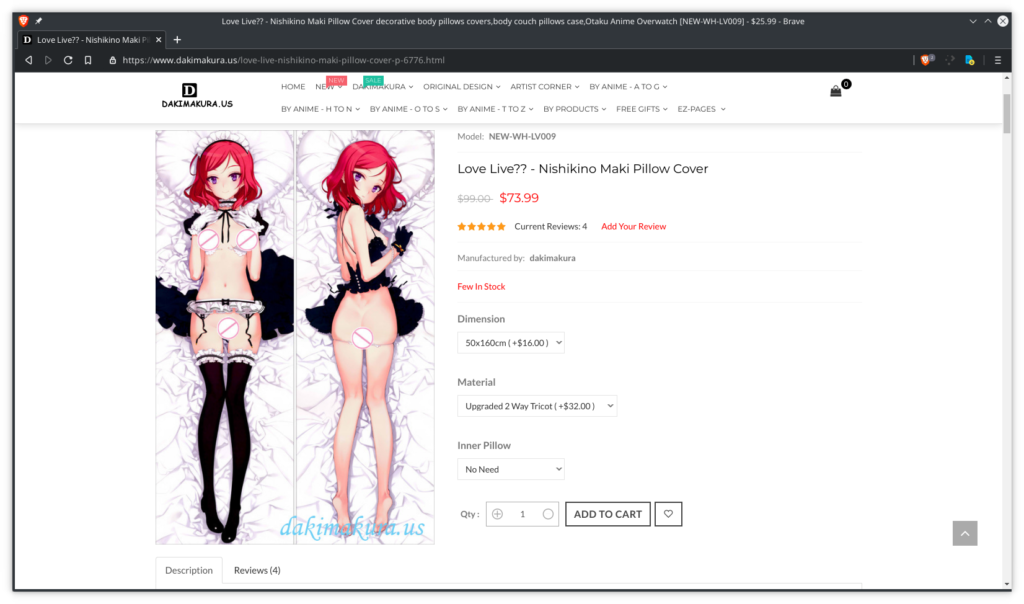
My criteria when judging images of anime characters typically include how close the art style is to the source material, how clean the lines and colors are, how non-distracting the clothes are, and the obvious stuff like having the correct aspect ratio and not being stretched/squished. While I’m actually not a fan of the weird fluffy “maid” headband Maki’s wearing in this artwork, the rest of the image looks great to me.
I bookmarked this product for later (read: kept the tab open), decided on an inner pillow from Dakimakuri (a mainstream daki producer with an extremely limited selection of artwork), and waited a couple of months to save up some money since this was a low-priority purchase. (I ended up pulling the trigger after getting a $300 security deposit refund that I didn’t expect from a previous apartment complex.)
Fast forward to when I sat down to actually make the purchase. I gathered up the three tabs I’d saved (for the cover, the inner pillow, and an overcover to hide the lewd character cover in case of guests.) I added everything to the respective websites’ carts and added up the totals. But before I clicked “check out,” I decided to do just a little more research on one aspect of the inner pillow itself:
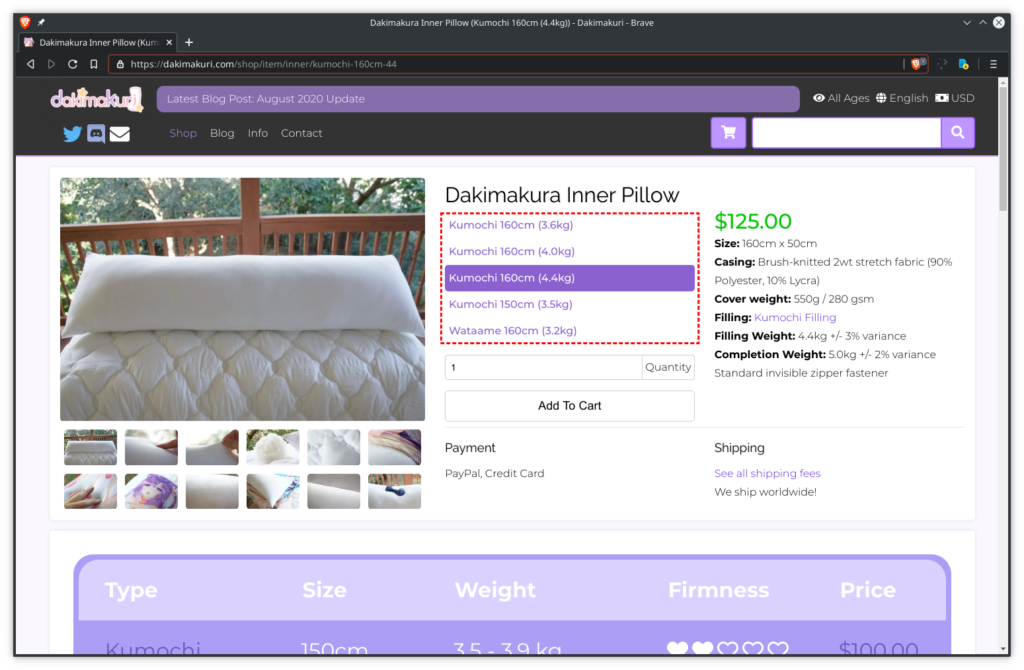
Dakimakuri offers multiple pillow sizes; their selection has changed since writing this post, but the options at the time of my purchase are shown in the screenshot above. One of them’s a 150cm length, so that one can be eliminated right away– most daki covers are 160cm long. The rest of the pillows are differentiated by their stuffing.
One of the remaining pillows has an older “Wataame” (cotton candy) stuffing, while the other three have “Kumochi” (cloud candy) stuffing, the current flagship stuffing from Dakimakuri. (Dakimakuri sells their Kumochi stuffing separately for those wishing to build their own pillows, while they do not sell Wataame separately.) Of the three Kumochi pillows, each is stuffed with a different amount of stuffing in kilograms, ranging from 3.6kg to 4.8kg.
I initially chose the heaviest pillow available with the rationale that it would most likely last the longest– more stuffing means more time before the pillow goes flat. However, Dakimakuri described this pillow as “made for the most experienced owners.” I assumed that was simply because it’s the most expensive, but wanted to be sure, so I did a web search for “firm vs fluffy dakimakura” on DuckDuckGo.
The first page of results was mostly filled with daki manufacturer homepages, but near the bottom was the /r/Dakimakuras subreddit (since it includes “fluffy” in its page title), and the preview text caught my attention:

I was about to purchase a cover from dakimura.us– and here Reddit was telling me that dakimura.us is a “bootlegger.” Here’s a link to the thread in question, which was created (and stickied) by one of the three subreddit moderators (four as of 2023).
Here’s a short summary of what I learned from that Reddit thread:
- A bootleg dakimakura cover is generally defined as “any dakimakura cover which was produced using an image without the explicit permission of the original illustrator or whoever owns the rights to the image.”
- Because the original illustrators rarely post full-resolution designs online, bootleggers usually have to find lower-resolution and/or censored images, upscale them, then touch them up to remove the censors (and sometimes make additional changes to hide their plagiarism.)
- In the words of the moderator, “most English sites are going to be bootleggers,” and aside from a few big ones (like Dakimakuri and Cuddly Octopus), it’s recommended to use a Japanese auction site, such as Yahoo! Auctions.
- The moderator of /r/Dakimakuras is annoying.
- Of course, I’m only kidding– the moderator was just the bearer of bad news, and wasn’t shy about being the messenger.
Addressing point #3, the reason auction websites are recommended is because doujin artists (freelance fan artists) in Japan generally don’t set up print-to-order merchandise online; instead, they privately order a limited run, then they sell them at conventions, only turning to eBay-like websites with whatever surplus stock they happen to have. This doesn’t seem to make a lot of sense (they’re limiting how much revenue they’re making from each design), but it’s largely because the artist of that particular image probably didn’t own the rights to use that character in the first place. Artists are much less likely to get in trouble for copyright infringement selling small batches of essentially home-made goods at conventions than they are if they try to mass-market their products on the internet.
This brings us back to point #1, and why I personally think bootleg dakimakuras are not a black-and-white issue: a website can certainly copy an artists’s design, but if the artist didn’t own the rights to the character in that design anyway, then they don’t have much legal ground to stand on. Giving the artist a copyright on that work would mean taking the copyright away from the original creators of the character. For that reason, bootleg dakimakuras aren’t so much a legal issue as they are a moral one– and the moderator of /r/Dakimakuras is quite verbal about his viewpoint on the matter.
I appreciated a lot of information the moderator provided, but I became increasingly irked each time he referred to the dakimakura industry as “the hobby.” He explained that “the hobby doesn’t work in the same way that bootleggers do,” and that if you see a particular design online that you like, you can’t simply have it– you have to venture to a convention to see if it’s in stock, scour auction websites for resellers who might have picked up extras at a convention, and if the design isn’t available anywhere, you have to give up.

What this person’s describing is indeed a hobby, and the hobby is collecting dakimakuras. That’s all well and good, but I do not intend to collect dakimakuras. (Let’s check back on that statement in a few years, am I right?) I’m trying to make a one-time purchase. I have some extra money and I thought it’d be nice to have one, so here I am. I don’t want to browse booths for cover designs (as if conventions are still around after COVID-19); I already know which cover I want, and it’s the Maki design that I’ve been eyeing for several months already.
This redditor’s arguments boil down to it being morally wrong to use an artist’s artwork without their permission. I understand where he’s coming from, but I would counter that the artists used the original characters without their creators’ permission, and then stopped offering copies of their artwork. If they wanted to take the risk and offer their designs directly, I’d happily pay them more to get it directly, but that is not an option. And what the redditor doesn’t understand is an option is purchasing a copy from one of the “bootleg” websites, which, by compiling a large number of long-lost designs and offering to print and ship them, are unarguably providing a service in themselves.
What is arguable is the quality of that service, and that’s why I had to keep listening to this redditor despite my difference in philosophy. Bootleg websites offer a variety of materials, the cheapest being “peach skin” and the most expensive being “upgraded 2-way tricot.” The /r/Dakimakuras moderator claimed that even the upgraded 2-way tricot on a bootleg website is inferior quality compared to a “legitemate” cover. I have no way to substantiate his claims, and they could be clouded by his view of the third-party sellers, but the fact that he refers to purchasing these covers as “the hobby” lends him some credibility of knowing the products well.
He also gave some examples of details being lost or inaccurately restored on upscaled bootleg images. These are even more subjectively judged– looking at some side-by-side photos, there were at least a few times when I preferred the art style of the inaccurately-restored version. Take this comparison, with the original on the left and the bootleg on the right:

While the image on the right clearly has less shading than the one on the left, that flatter look is more in line with what I would expect from anime-style artwork. Anime looks so attractive because it lacks detail; no detail equals no imperfections, and your mind can fill in what it wants to see. So in this case, while I can certainly appreciate the more true-to-life shading of the original image, I also wouldn’t mind having the bootleg version instead.
The moderator provided a link to a handy website called MyFigureCollection, which tracks all sorts of anime-related merchandise. Amazingly, when searching for the character “Nishikino Maki” with the classification of “Dakimakura Cover,” there were only 16 results, and it was easy to spot the one I was considering by its thumbnail. From the entry, I was already able to see some differences between the original artwork and the version being sold today:
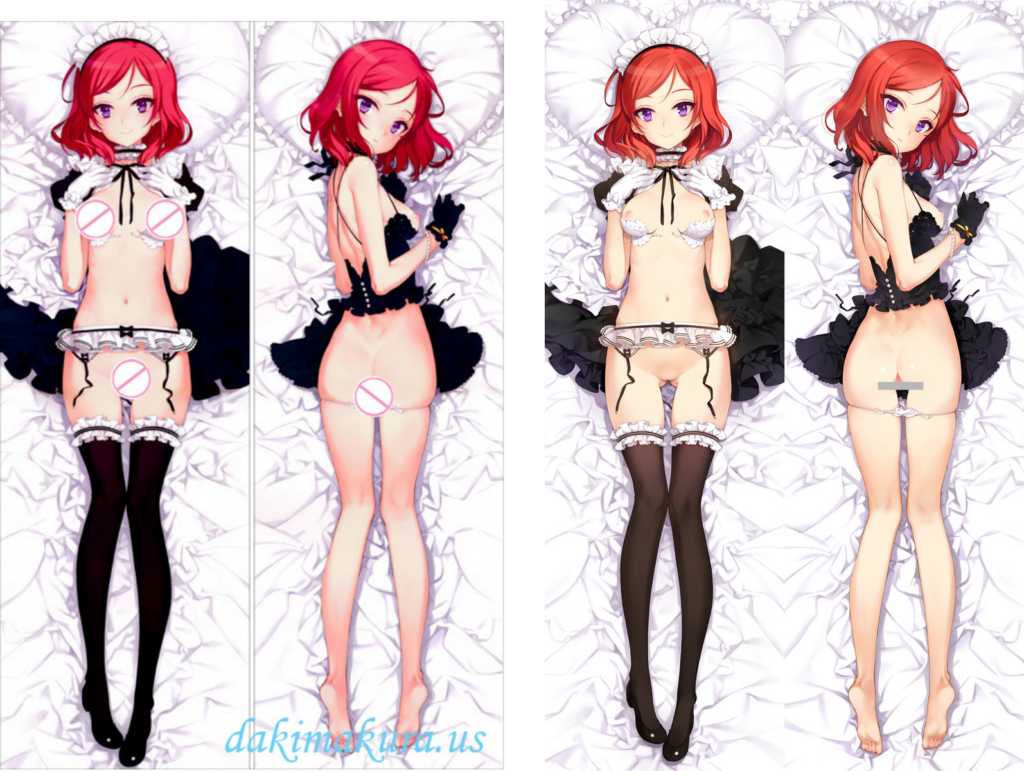
Here are some observations:
- The cropping is a dead giveaway that the bootleg version is “downstream” from the original version.
- I was initially drawn toward the more vibrant red (with a hotter pink hue) of Maki’s hair in the bootleg version compared to the original (which has a more subdued orange hue). However, the original is both more realistic and more accurate to the source material.
- The shading on the stockings is far superior in the original; they’re nearly opaque in the bootleg.
- It’s obvious that details have been lost in the removed clothing laying underneath Maki’s upper body.
- While setting up the above comparison image, I noticed that the vertical proportions are slightly off in the bootleg (with some points on the bootleg corresponding to higher on the original, and other points corresponding to lower), especially towards the bottom, where her shoes’ shadow has simply become part of the shoes (while somehow not covering up more of the background).
- It’s obviously difficult to compare the censored portions. Interestingly, on the back of the design, Maki’s left butt cheek (on the right) has a slight indentation where it transitions to her thigh in the original; it’s been rounded out in the bootleg version.
The MyFigureCollection entry (which only shows up for logged-in users with adult content enabled) informed me that the design was released all the way back in 2013, and was only officially sold in two places: at a convention called COMIC1☆7 (held in Tokyo with over 3,300 artist groups present), and as a limited-run item on a crafts website called Booth (presumably, the leftover stock from the convention.) The artist’s name is Oyari Ashito; following the link to his MyFigureCollection profile, and the link from his profile to his website, I was able to find his Booth store, where only three items are currently being sold, this cover not being one of them.
I sent the artist a message via Booth asking if he would be willing to provide the original high-resolution artwork for a fee so I can have it printed myself. This seemed like a win-win all around: I know I’m getting the original artwork, he makes money off of a design he’s already sitting on, and I’m supporting him as the artist. Alas, I didn’t get a response after several days, so I moved on in my search.
Taking the Reddit moderator’s advice, I tried searching on a few Japanese auction websites (as well as eBay), but was unable to find more than one or two completely different Maki dakimakuras– when searching in Roman characters, of course.
I had already reverse image searched the bootleg version of the preview image earlier to see if I could find a higher-resolution version, but I decided to try it again with the slightly larger and less censored preview on the MyFigureCollection page. Google gave me four results.
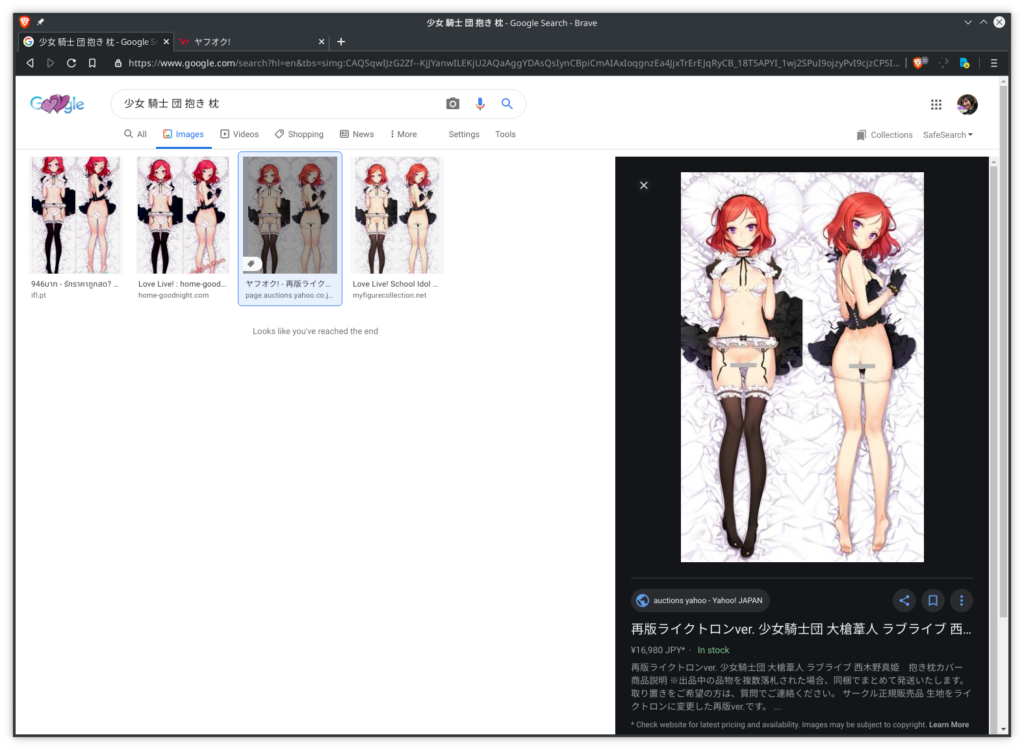
Two of these results were bootleg websites, one was another page on the MyFigureCollection website, and the final result (shown above) is for a Yahoo! Auctions page. (A bit of internet history: Yahoo! Japan was originally founded by Yahoo! along with the Japanese corporation SoftBank, and while the main Yahoo! website has changed a lot over the years in an attempt to stay modern, Yahoo! Japan instead stuck with the logo and website layout that lead to Yahoo!’s original success.) I clicked through and attempted to view the auction.

There are two problems with this image, and the first is that it’s in Japanese. At the time of purchasing, my Duolingo-honed skills weren’t quite at this level yet, so this is where I switched from Brave to Chromium in order to use the built-in translation tool.
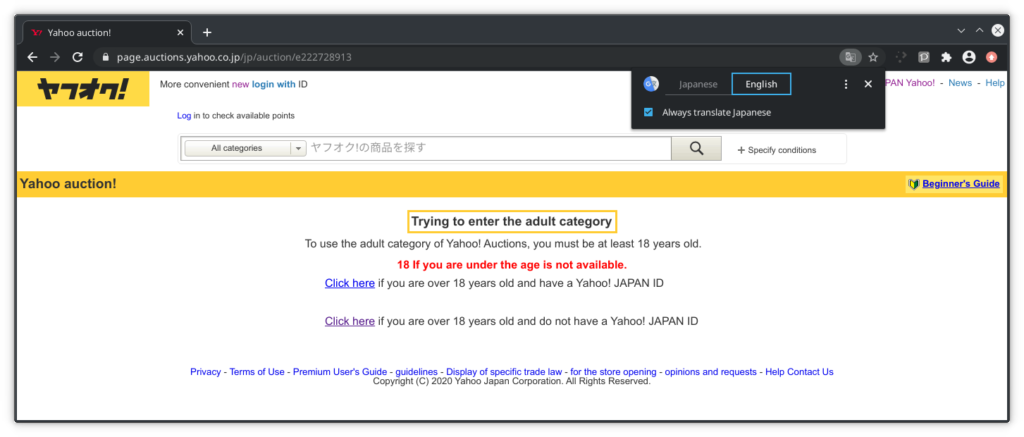
The second problem is that the listing is age-gated due to the sexually explicit nature of the artwork. Passing through the age gate requires logging in with an account. I tried doing that, but the first step asks for a phone number, and only works with Japanese numbers; mine was rejected.
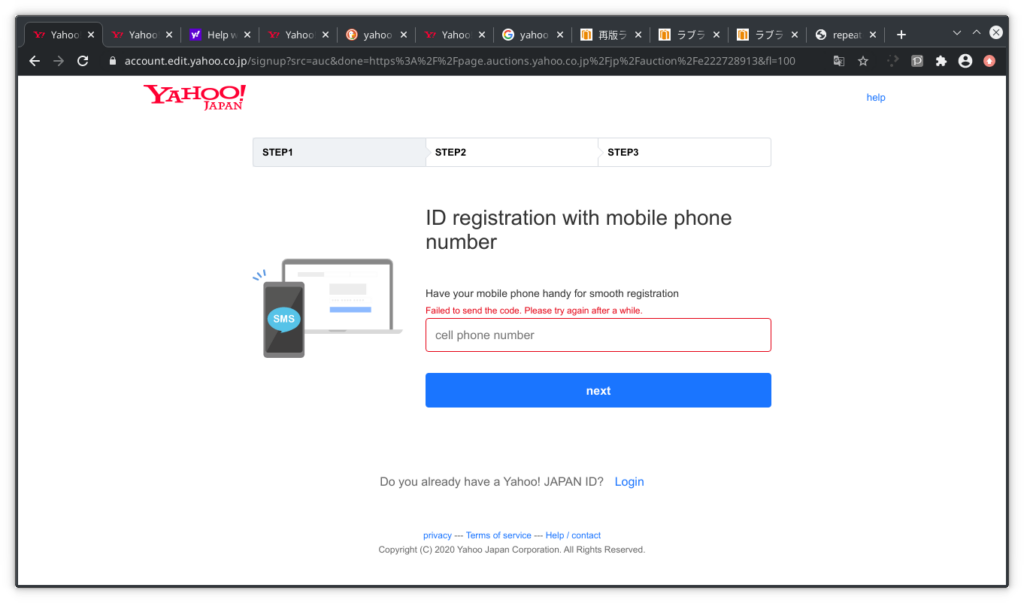
It wouldn’t have even been too helpful if I had gotten into the listing, since Yahoo! Japan auctions usually only ship to Japanese shipping addresses anyway. The auctions are also run in Japanese currency, and I wouldn’t bet on their systems allowing foreign credit cards, even though my card supports international payments.
Some quick web searches and references back to the /r/Dakimakuras subreddit turned up several websites that can be used by foreigners to bid on Yahoo! Japan auctions by proxy. Typically, these websites charge separately for international shipping, and/or add an additional percentage fee on top of the item. They require a deposit first (in case you win the auction), then you can place bids that are (automatically or manually) forwarded to Yahoo! Japan.
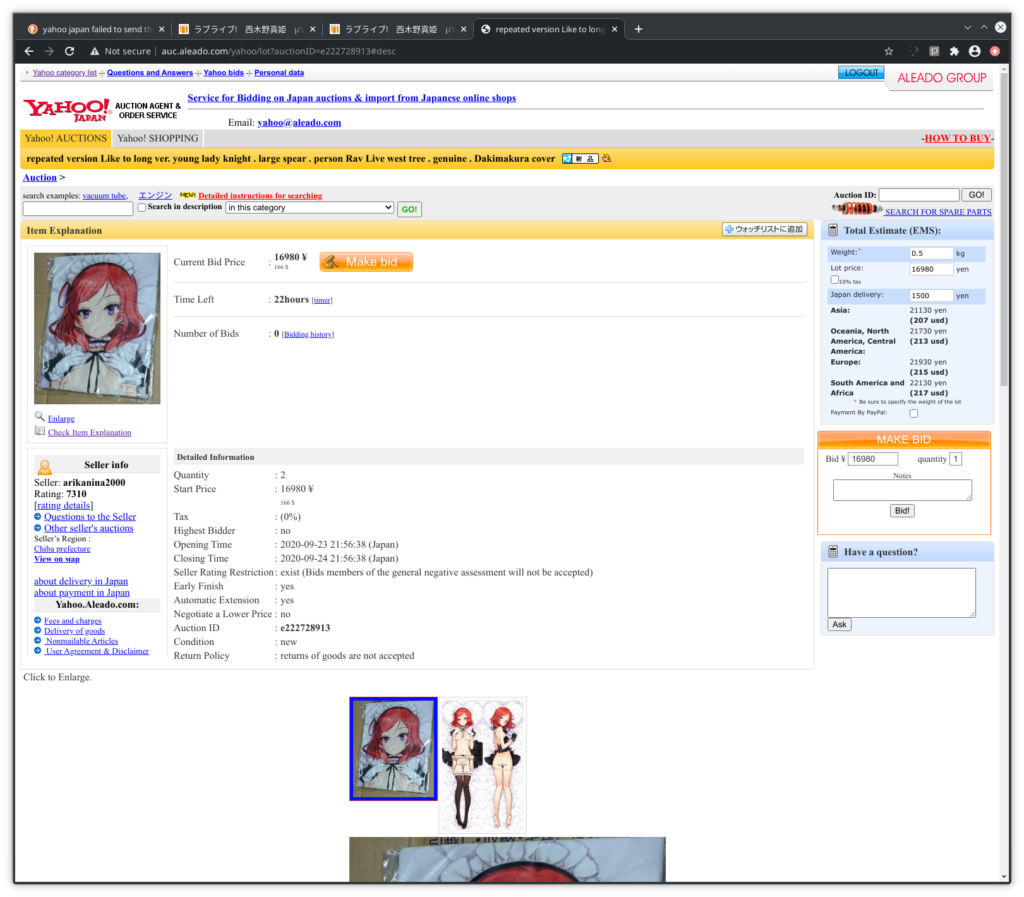
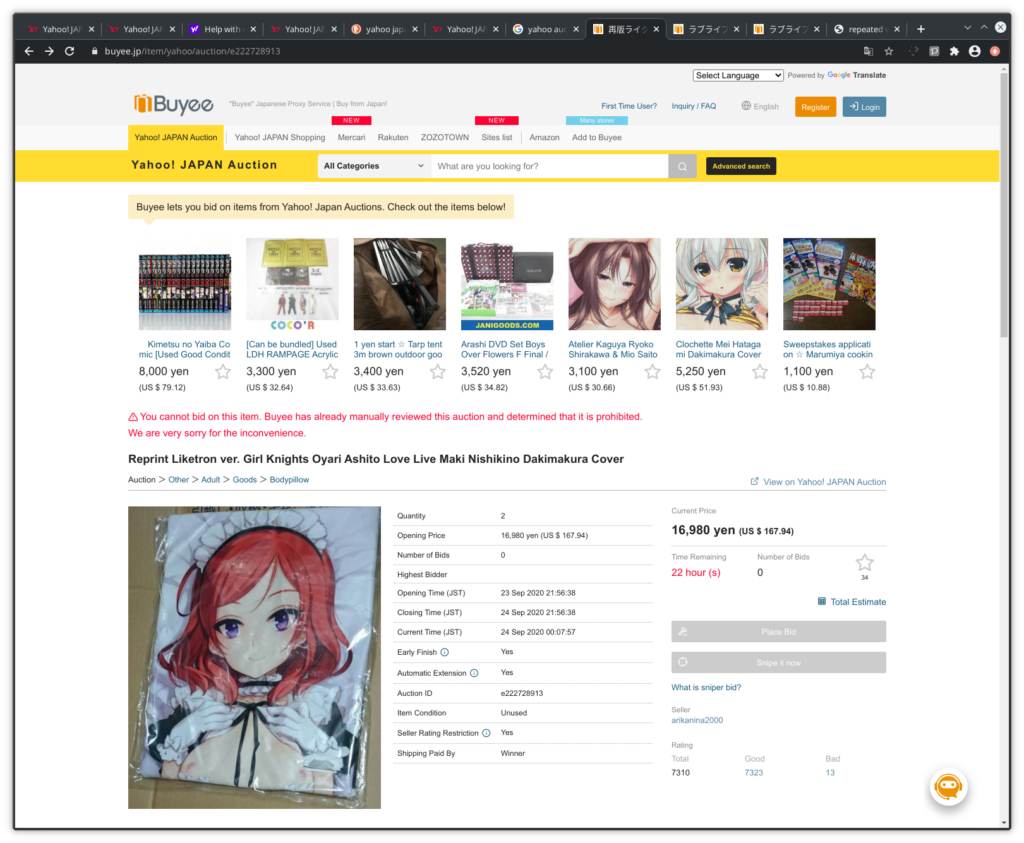
The main differences between the sites are the cost structure and exact markup. The interfaces also differed slightly– Aleado, pictured on the left above, has a page layout similar to the actual Yahoo! Japan auctions website at the time. In 2023, Yahoo! Auctions displays an English banner stating that they’ve partnered with Buyee, but that partnership banner wasn’t there in 2020 when I made this purchase, so Buyee was just another third-party option.
Based on reviews and pricing, I ended up trying Remambo. As the proxy websites showed me, the seller had two of this item available, and the opening price was 16,980 yen (about $160 in 2020).
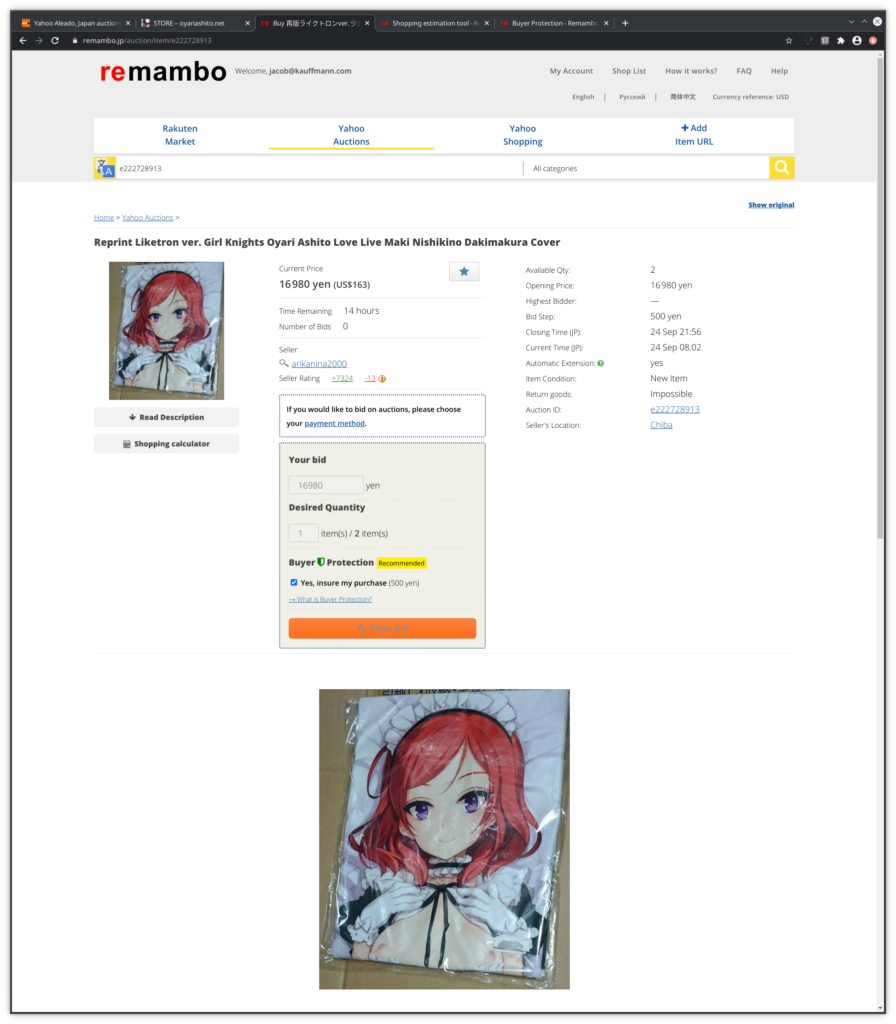
Remambo helpfully provided a machine translation of the Yahoo! Auctions seller’s description, while also giving the option to view it in the original form.
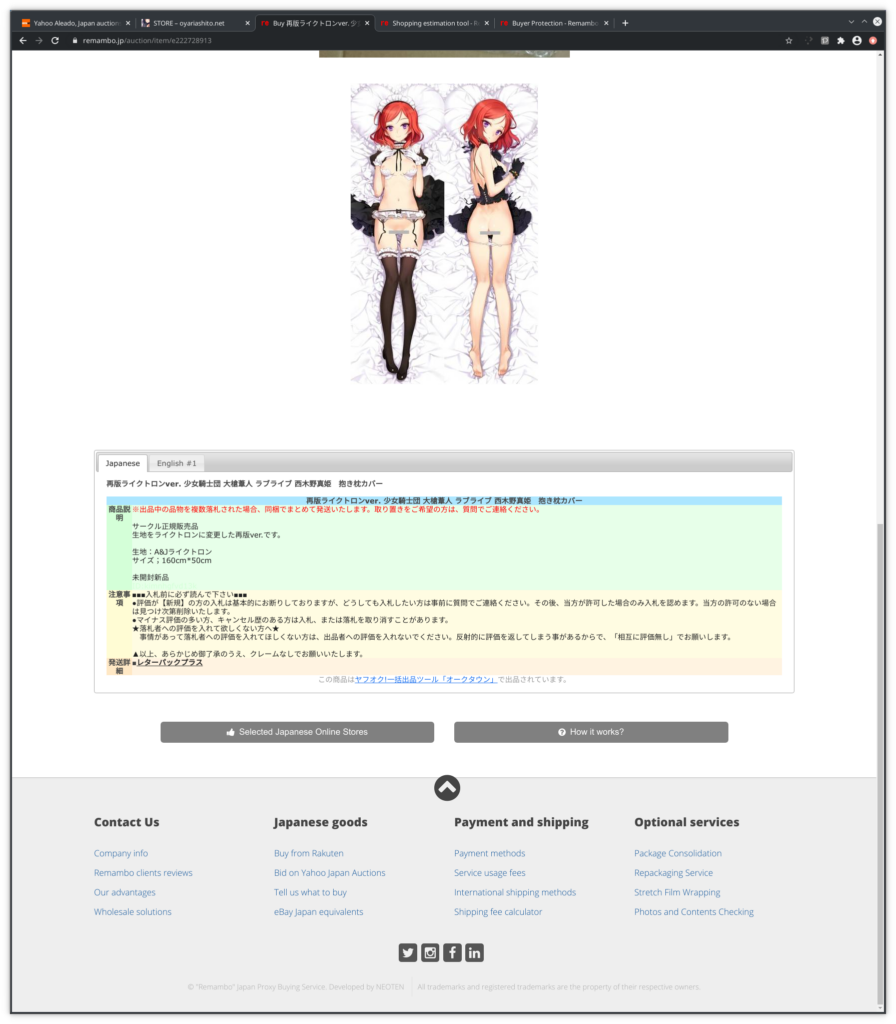
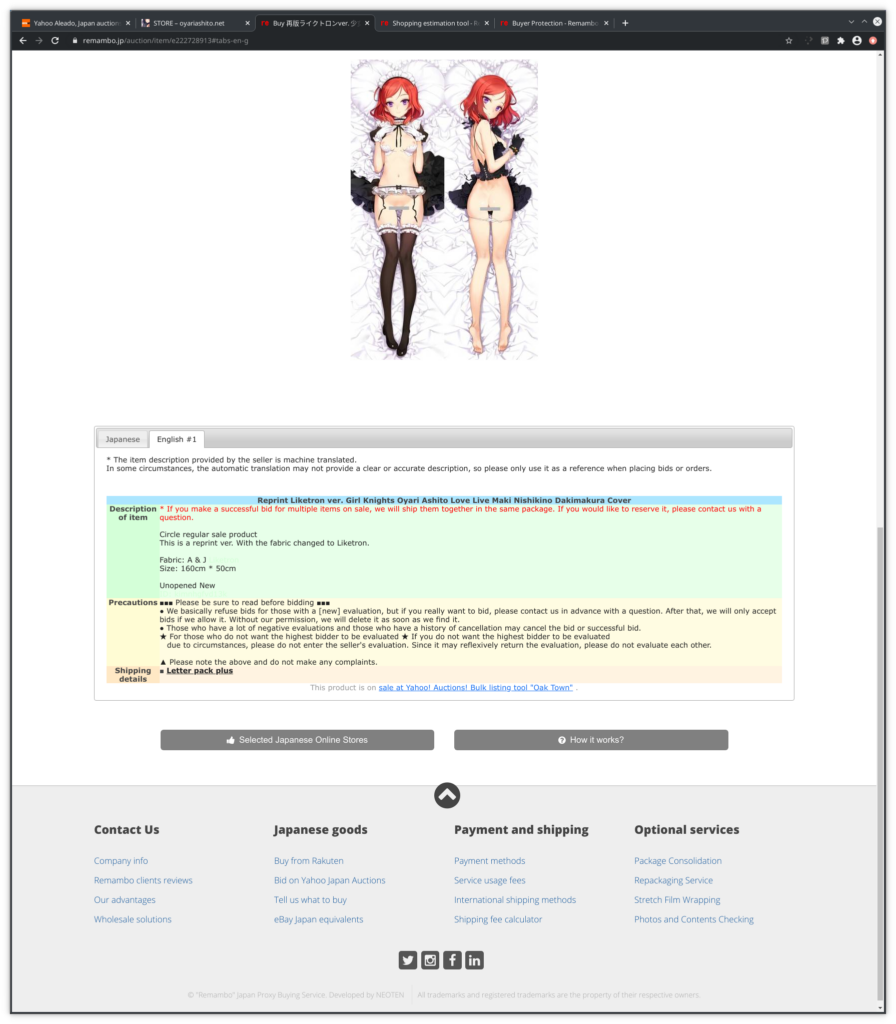
Remambo requires payment for bids and domestic shipping (to their warehouse) upfront, then collects for international shipping separately once the item’s in the warehouse. This allows you to order multiple items to their warehouse, then pay once to have it all shipped internationally in the same package.
At this point, before moving forward, I messaged the artist on Booth one more time linking to the auction page and asking if he could confirm this item was legitimate, since bootlegs can still pop up in auctions and I lacked the data and experience to verify the authenticity myself. However, I still didn’t get a reply. The “reprint” title and description seemed to check out against one of the entries on the “Releases” section of the MyFigureCollection page (assuming the second release wasn’t just extra stock after all), so I decided to go for it before the auction expired.
After registering for Remambo, I submitted a deposit of 17,980 yen ($188.29) to my account, which I figured would cover the bid and domestic shipping. I chose to pay by credit card, which cost four cents more than paying by PayPal. Then, I placed my bid.
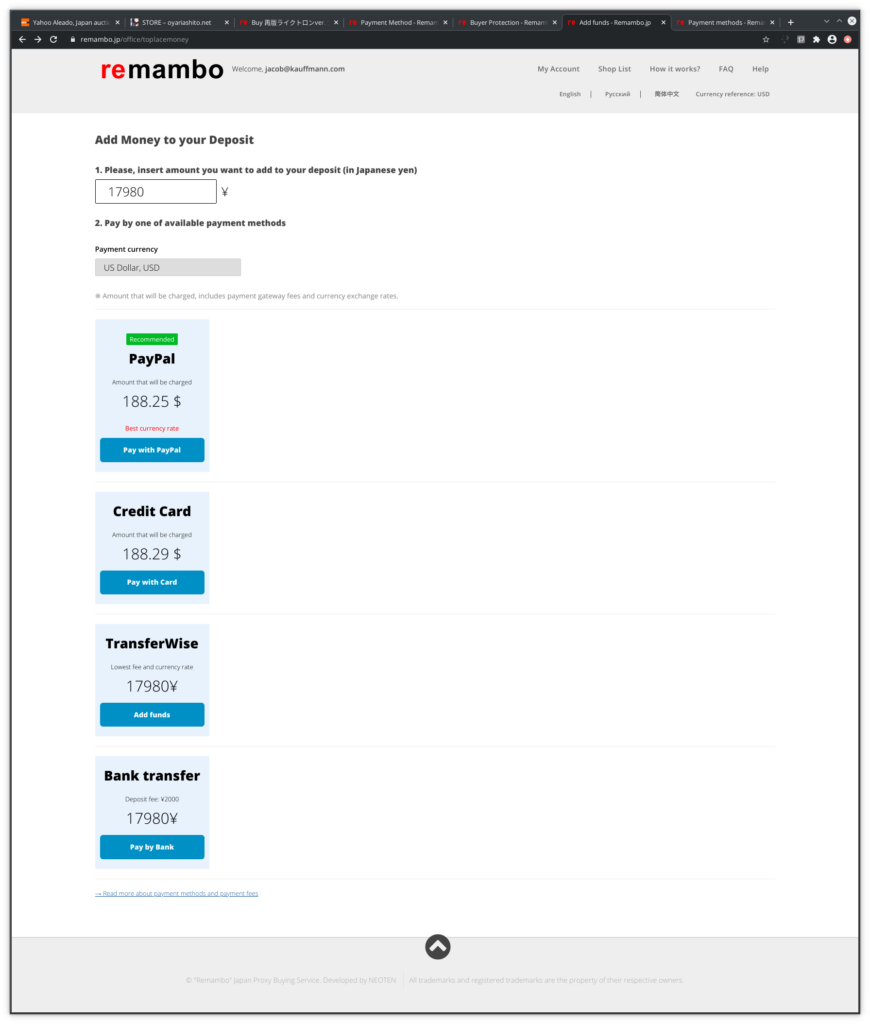
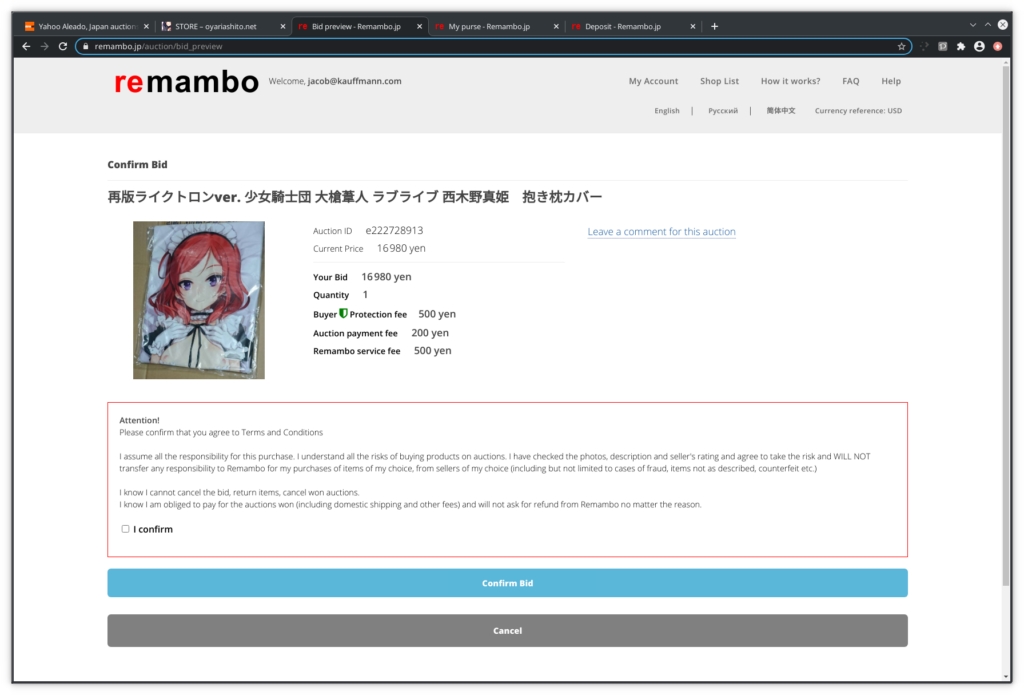
Fortunately, this item wasn’t in particularly high demand, probably because the original Love Live! show is more than a few years old. I won the auction later that day on September 24th, and was informed that an additional payment of $2.08 was required to cover the proxy service fees. After making that payment, I waited for the item to arrive at Remambo’s warehouse, which happened on October 8th.
Next, I went to “request compilation” so Remambo could put my items (in this case, only one item) into a package for forwarding. It’s been quite a while at the time of writing, so I’m a bit murky on the details, and my records are a little strange. I found a message that I sent Remambo asking a series of questions, but I don’t have any record of their response.
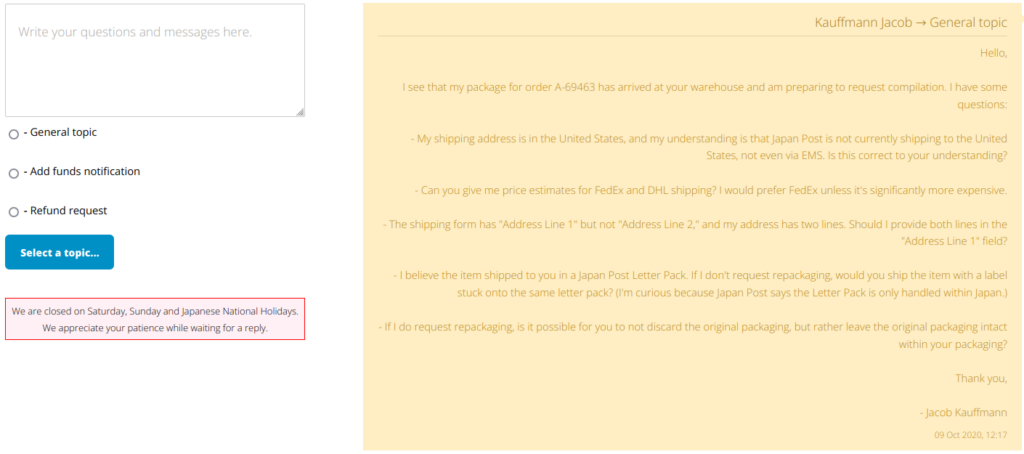
One of my main concerns was that Japan Post’s EMS (Express Mail Service) was still suspended to the United States at the time because of COVID-19. Additionally, I knew from the Yahoo! Japan auction listing that the product had been shipped domestically in a Japan Post Letter Pack, which Japan Post only allows for domestic shipments. I was interested in preserving as much of the original auction material as possible, so I asked if it would be possible for Remambo to put the Letter Pack packaging inside of another box or envelope for FedEx. (I also inquired about their address form, since they only had one line for the street address, and I lived in an apartment at the time, with the building and apartment number usually going on the second address line.)
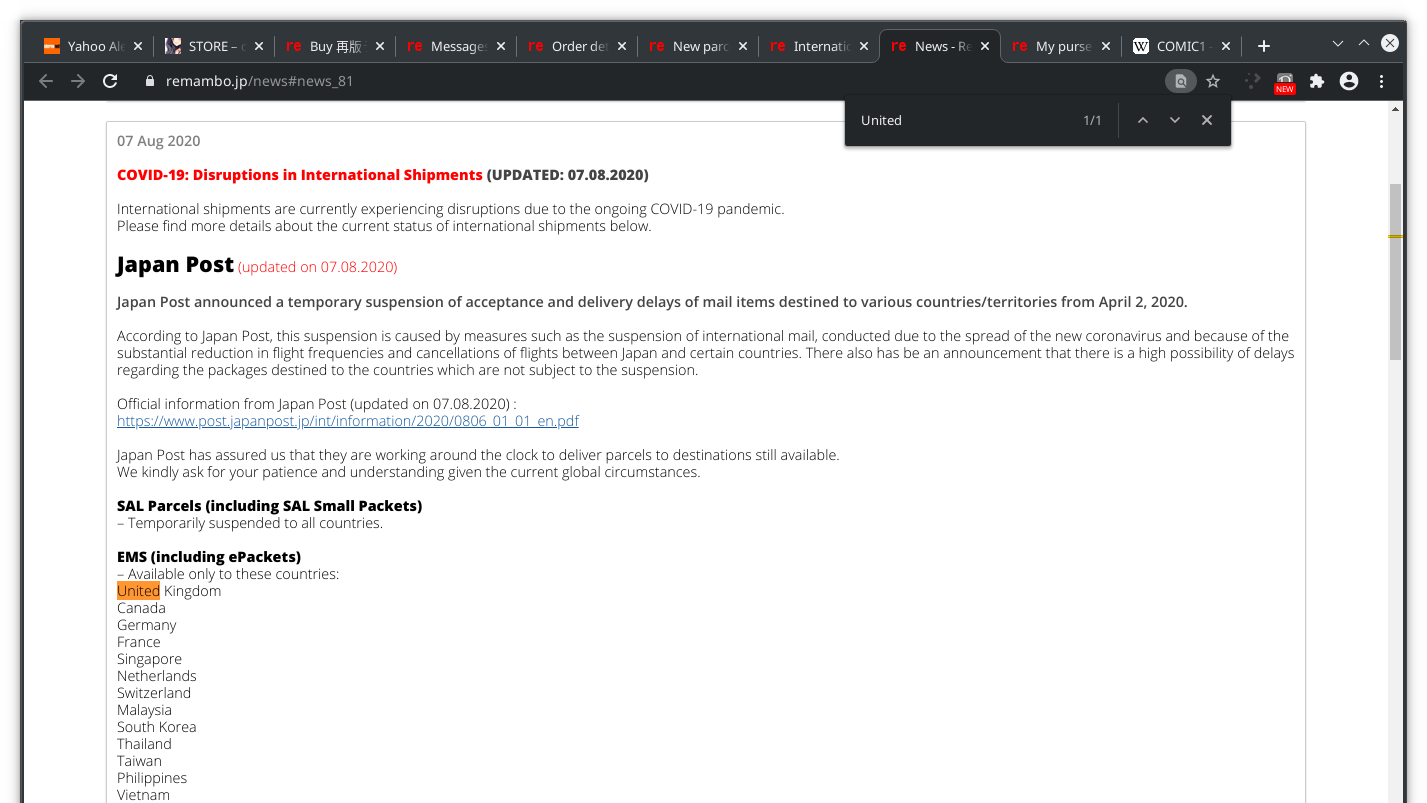
A few days later, I went ahead and submitted the form to request compilation and shipment, so unless I got a reply that’s no longer showing on the website, I must have gotten tired of waiting and decided to chance it. It appears that I just filled the form out to the best of my ability, basically requesting the same things I’d asked about in my earlier message, but worded such that I’d understand if any of the details weren’t possible.
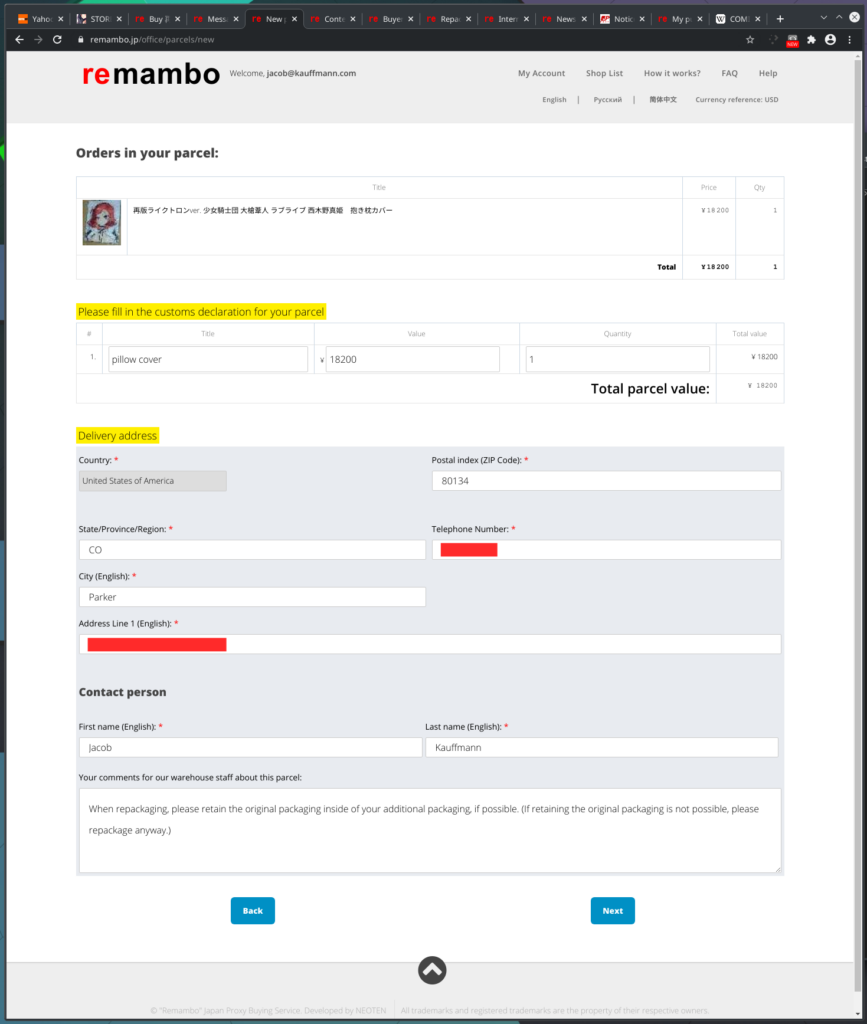
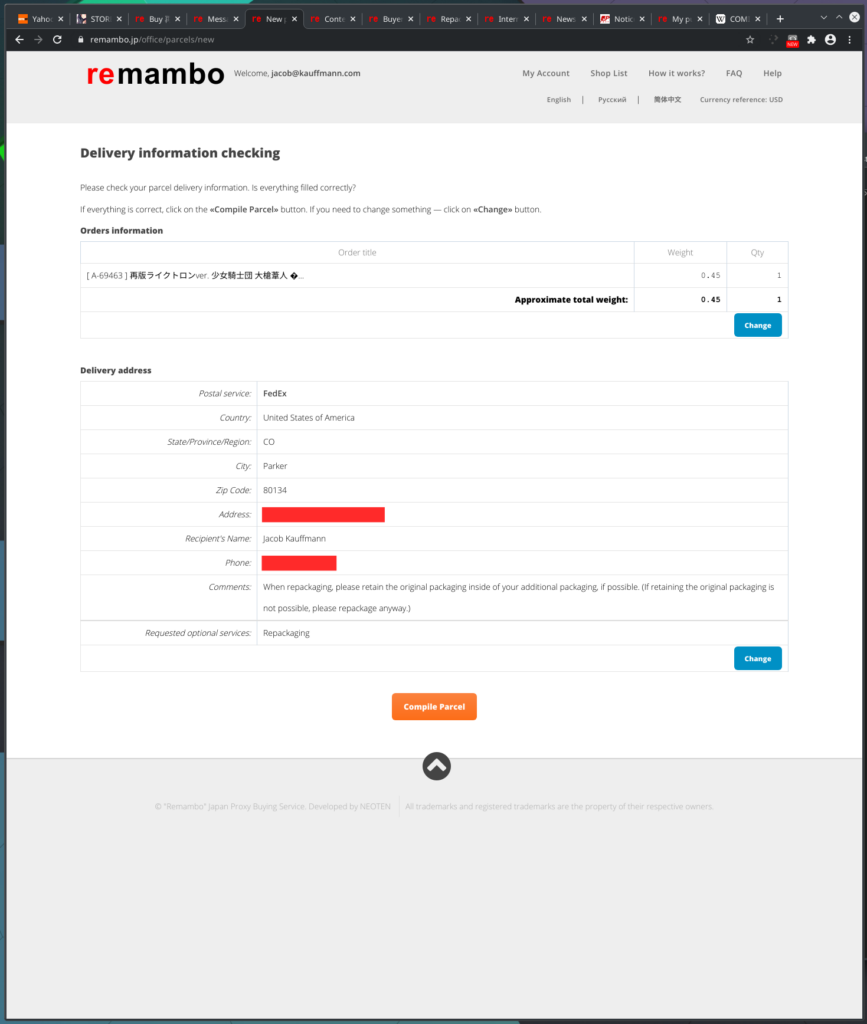
I saw a confirmation page for registering the parcel, and the parcel details page listed the auction orders that the parcel would contain (in this case, only one.)
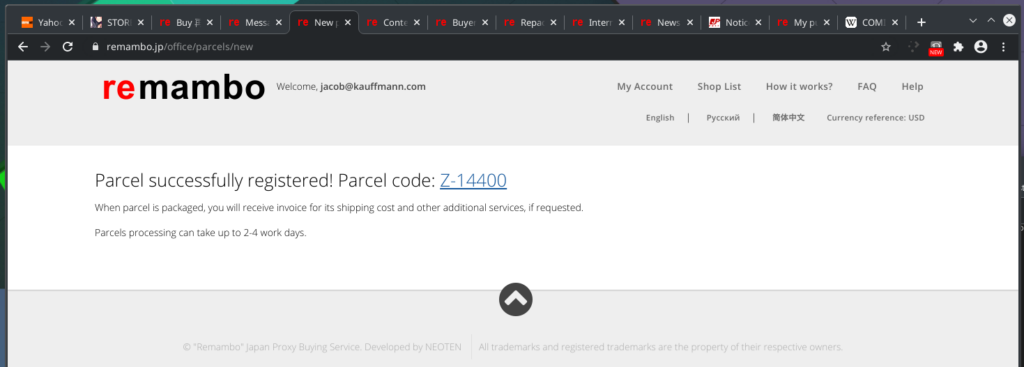
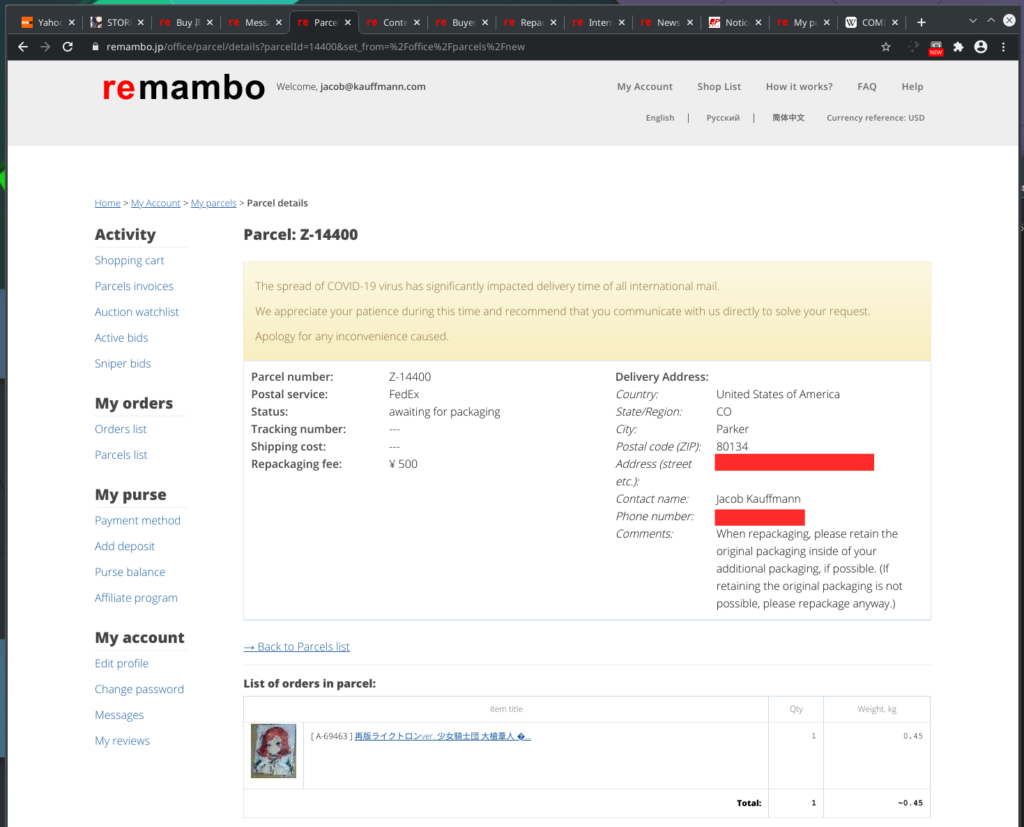
At 1:46 AM MDT on October 15th, I was notified that the parcel was packaged and awaiting a final payment of ¥ 9054 (about $85.11), which consisted of a ¥ 500 repackaging fee and ¥ 8554 for the actual FedEx shipping cost. After making that payment at 10:07 AM MDT, the parcel was marked as shipped out ten hours later at 8:13 PM MDT (11:13 AM in Japan’s Tokyo timezone.)
Even though FedEx was pricey compared to Japan Post’s EMS, it was also extremely quick! I got the package four days later, on October 19th.
Unboxing
As expected, the outer box was FedEx-branded, with some labels written in Japanese applied on multiple sides.
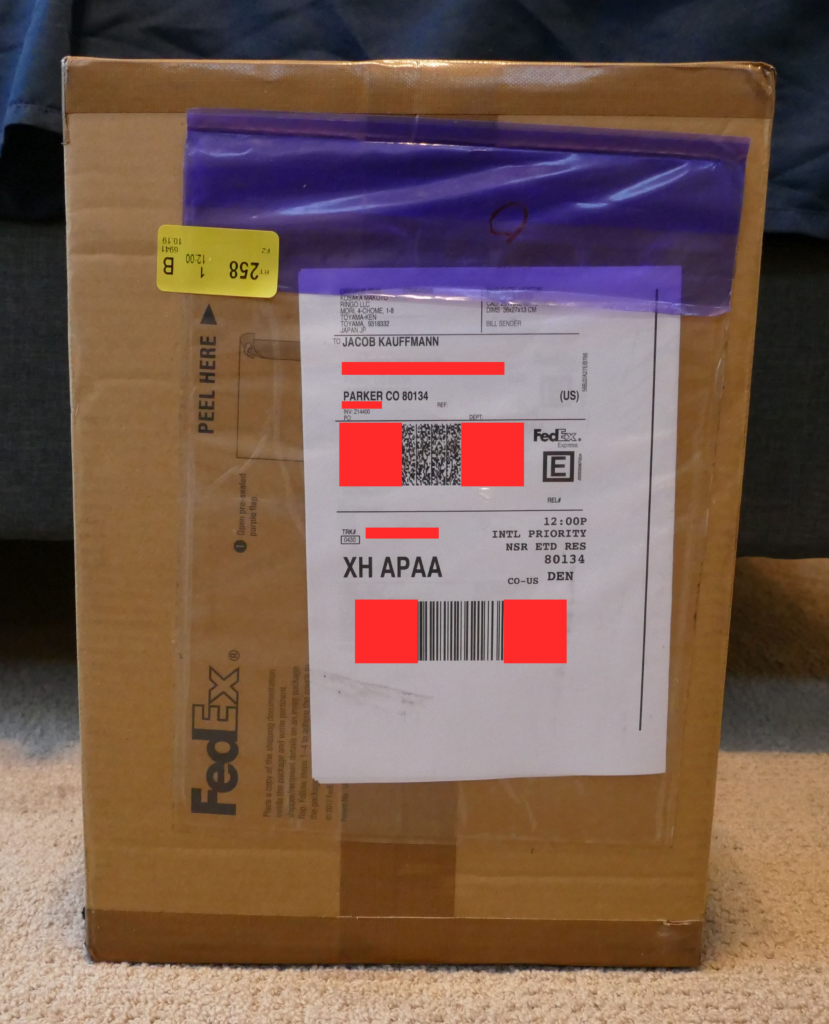
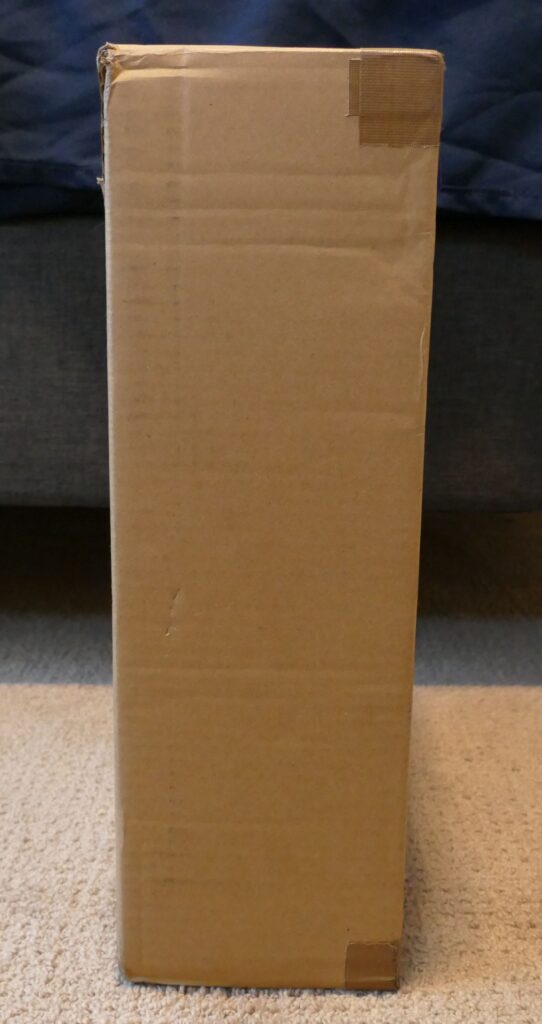
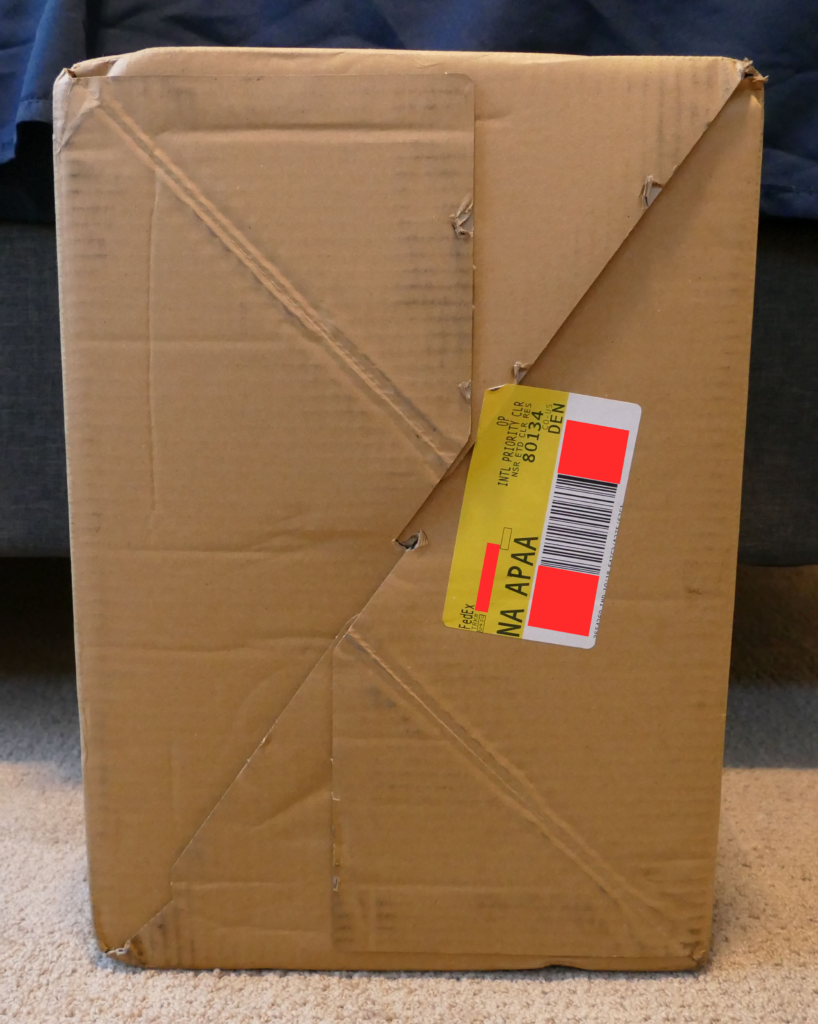
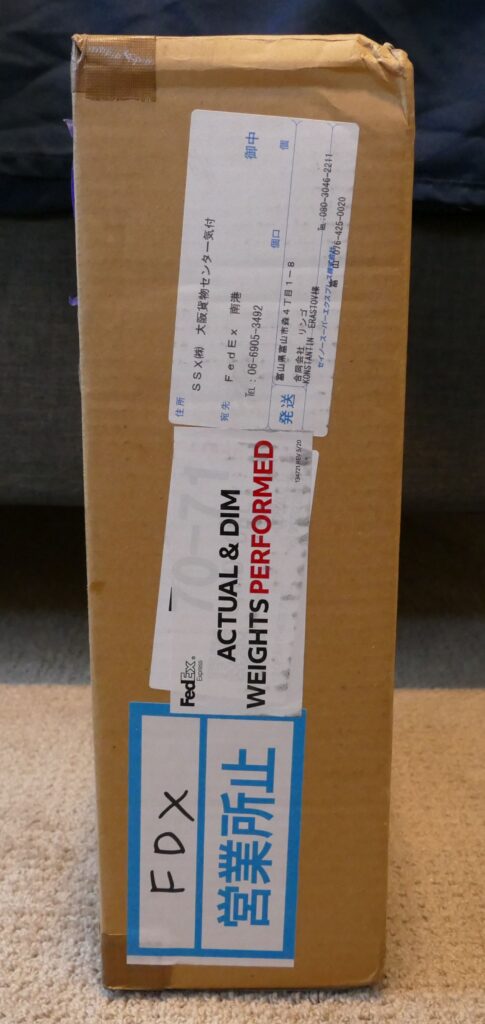
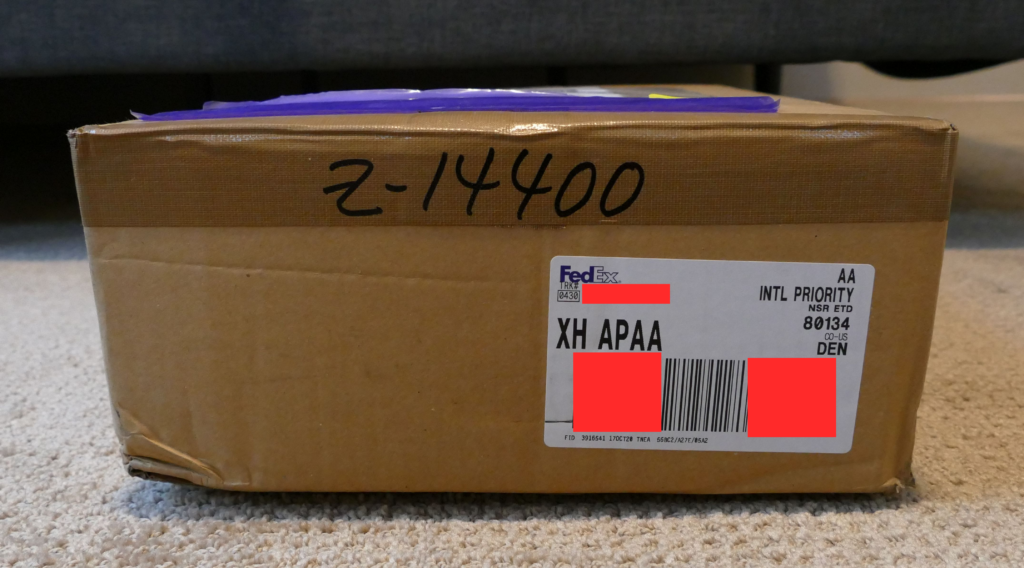
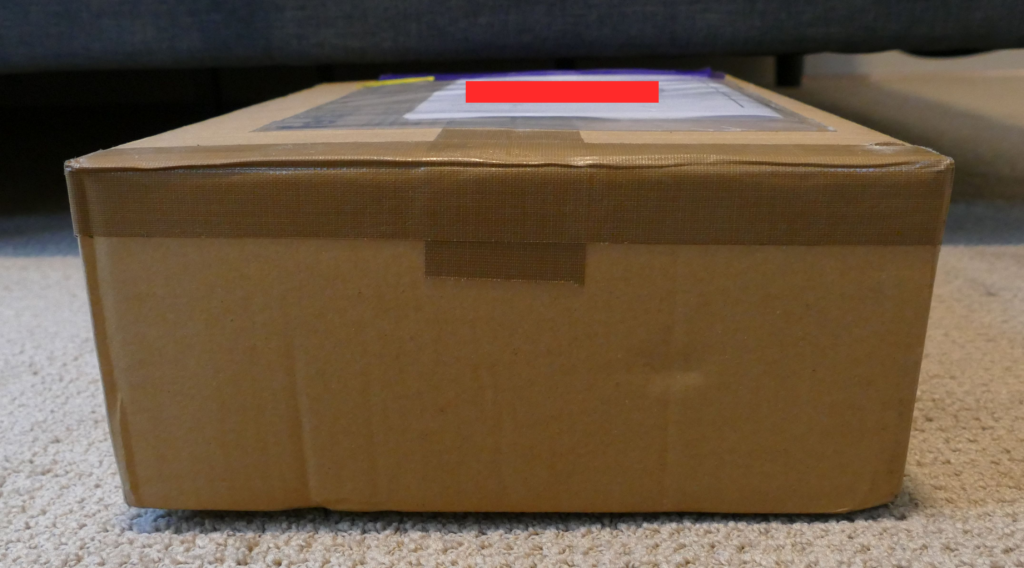
After removing the plastic envelope containing the international shipping documents, I was able to cut the tape and begin opening the box. Inside, I found the original Japan Post domestic shipping packet as I’d requested, protected within bubble wrap.
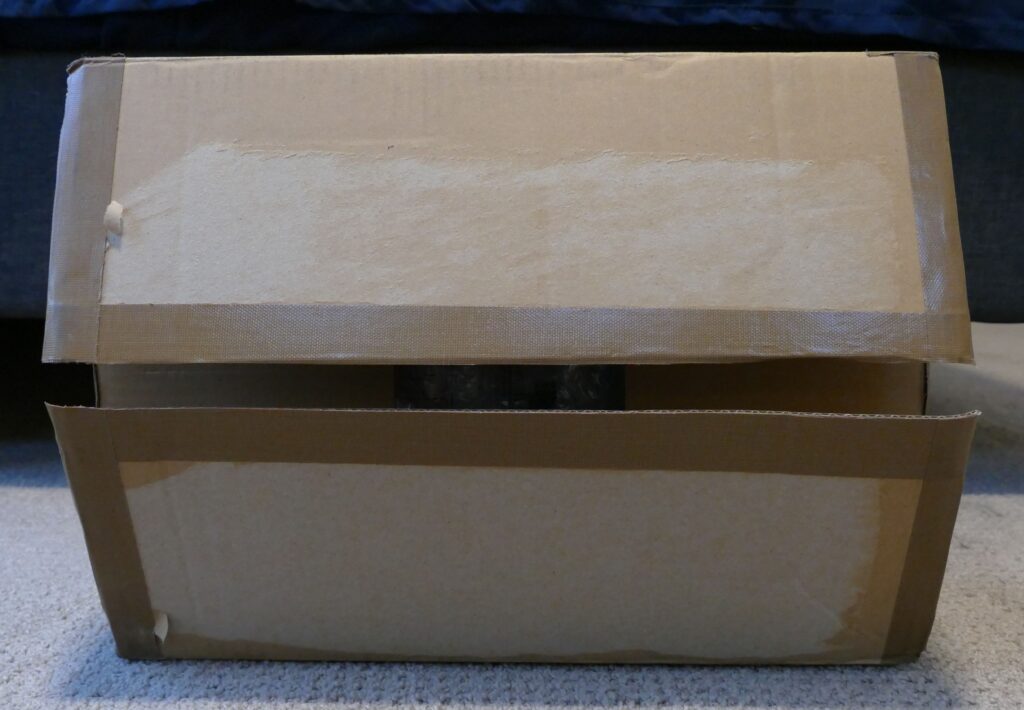
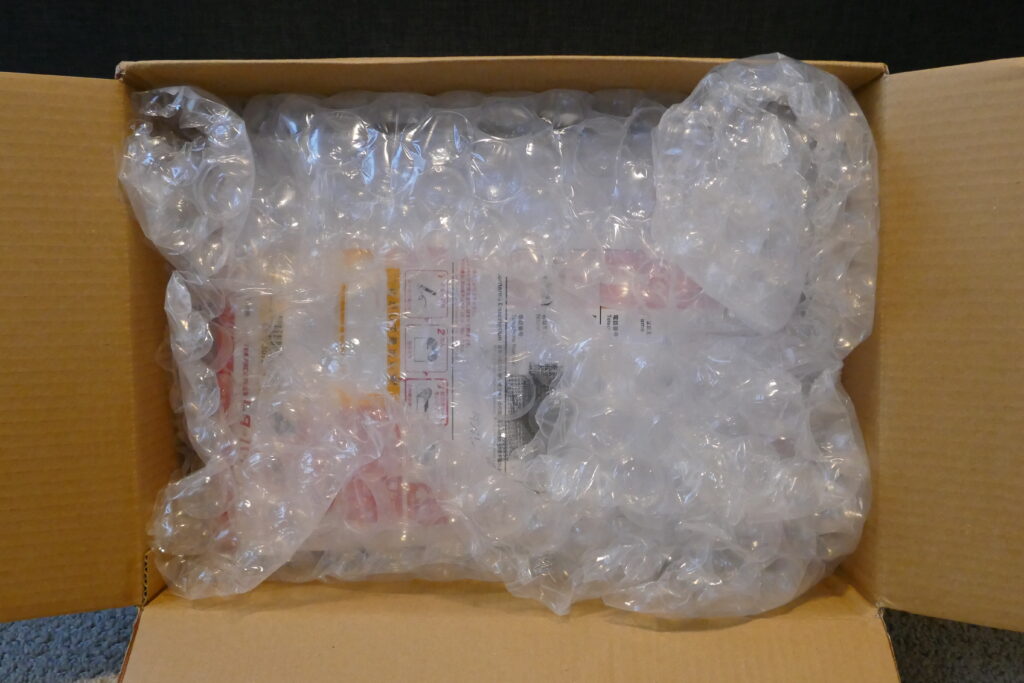
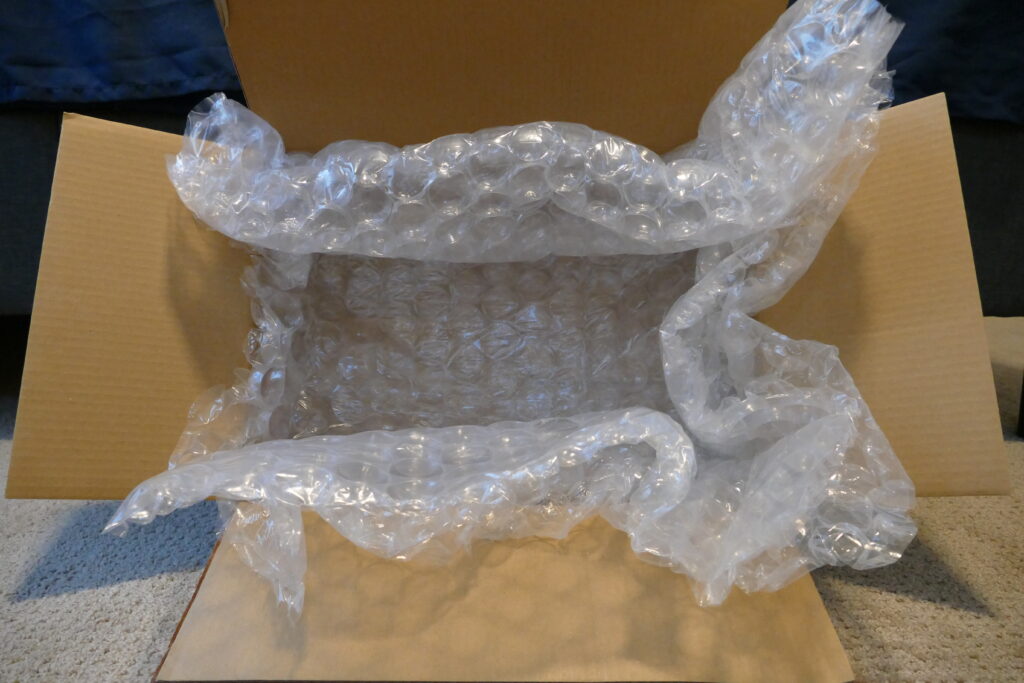
Interestingly, the “From” address on the domestic shipping packet seems to have been stamped over. I’m not sure if Japan Post or Remambo did this; I can’t think of why any individual party would have wanted to, unless there’s some law that states Japan Post parcels can’t be forwarded in their original packaging without blocking the origin address out. Ironically, it looks like whoever blocked the address out might have left their fingerprint right next to it on the label.
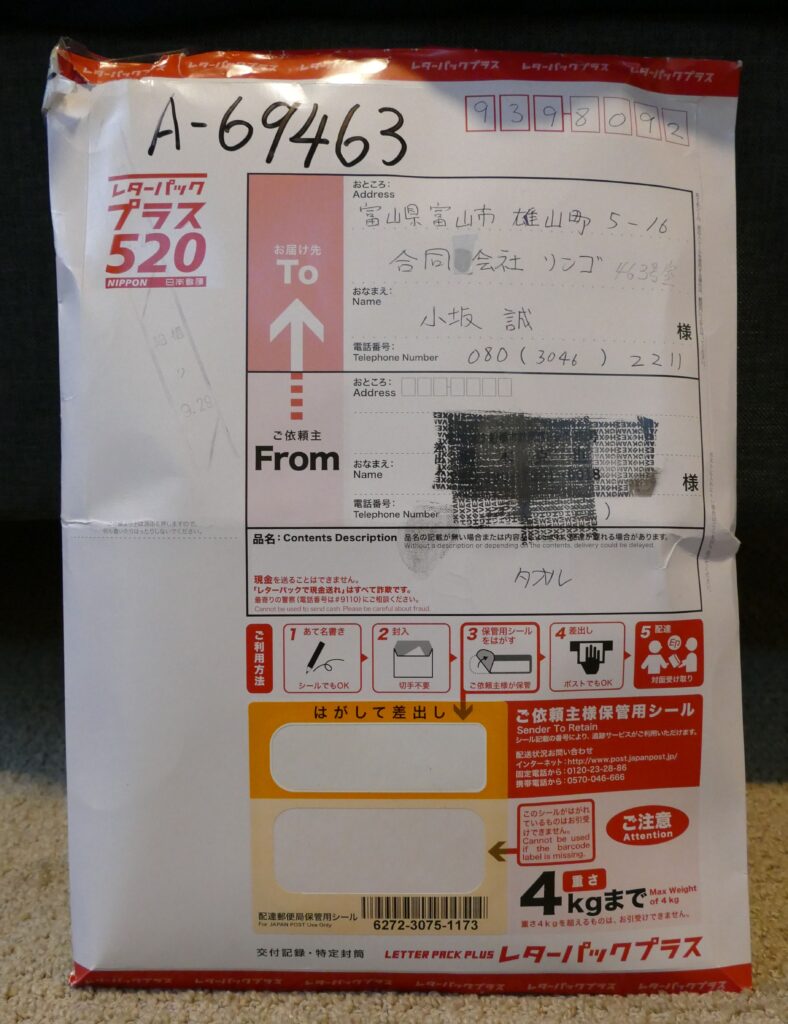
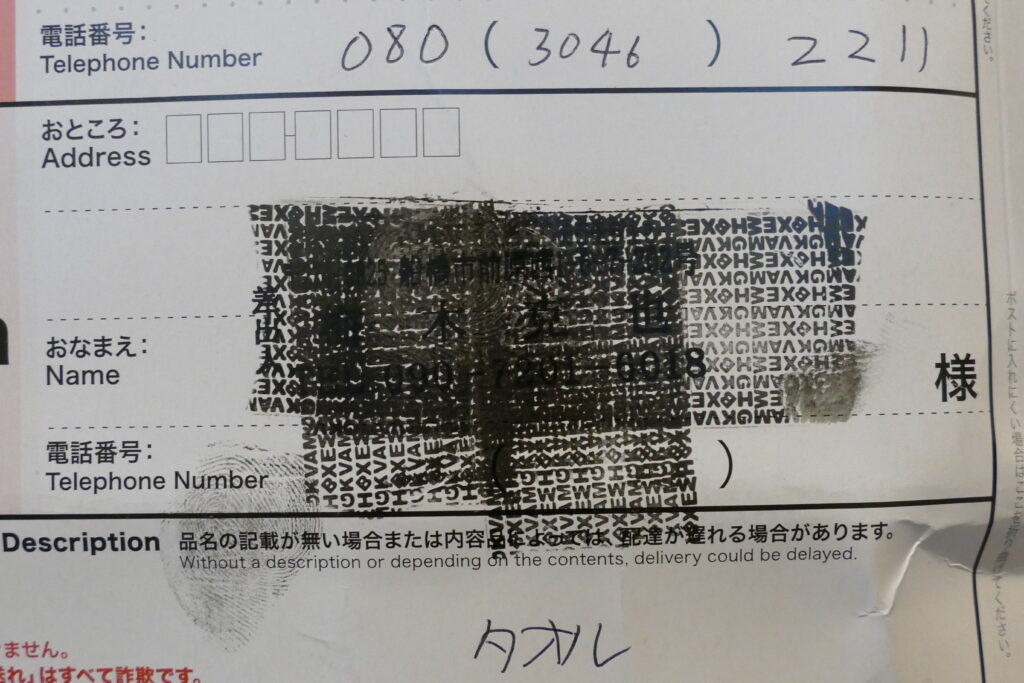
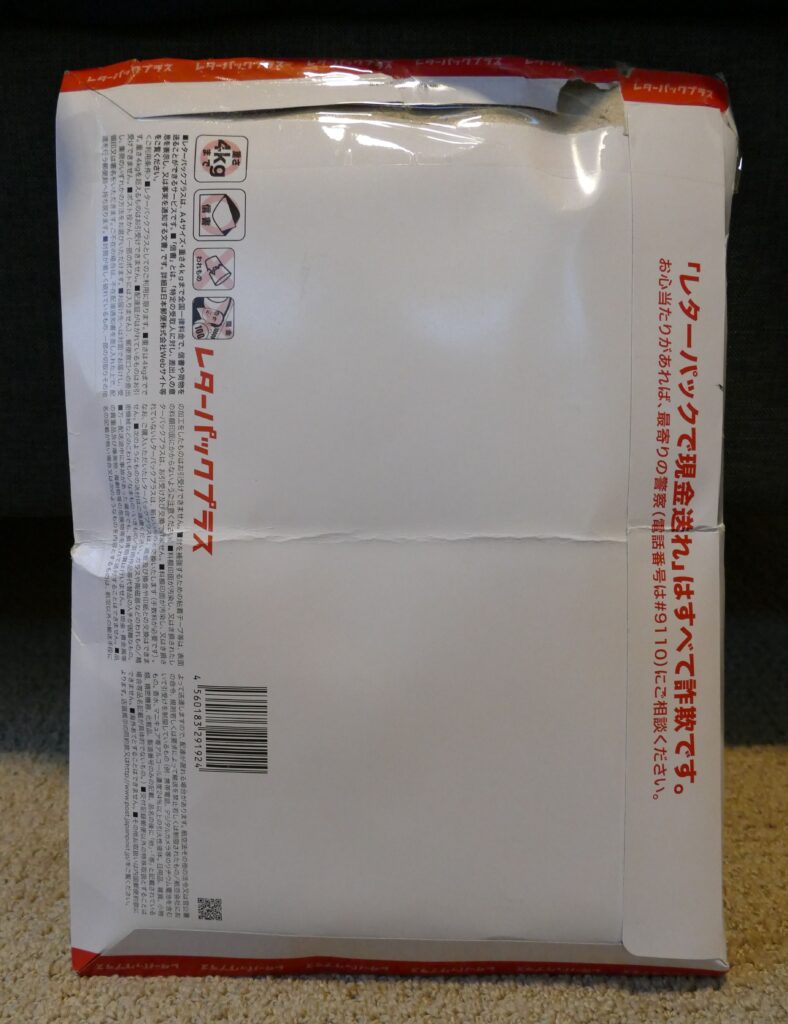
As I suspected, the Letter Pack is basically a document envelope. I’m glad it was repackaged in a proper box for international delivery, because even though cloth isn’t particularly fragile, I wouldn’t have wanted the dakimakura material subjected to any traction or pressure from sorting machines or other packages stacked on top.




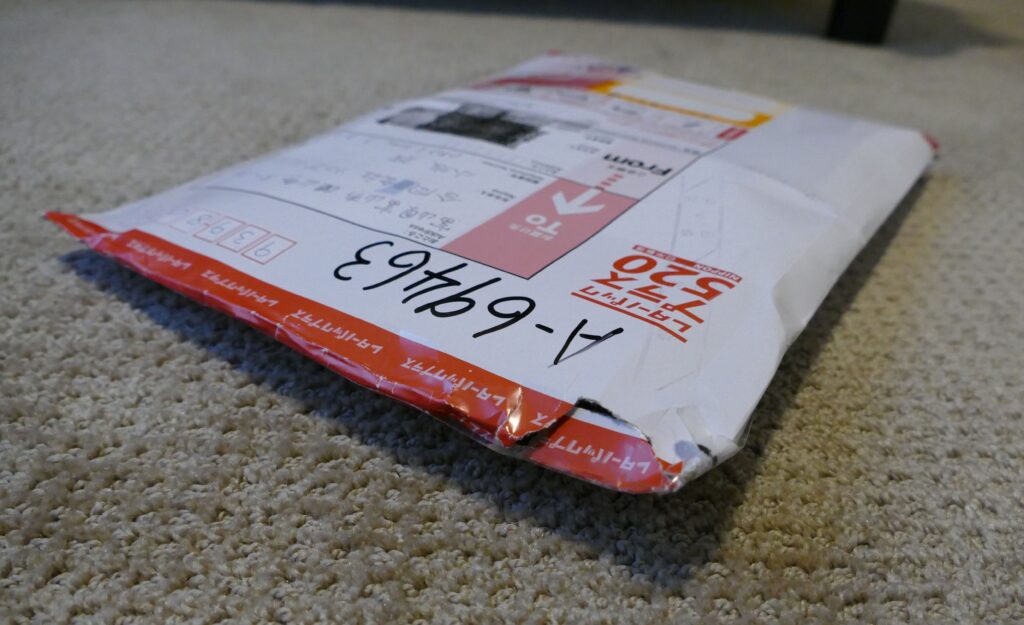
The letter pack appeared to have been opened and taped shut again, probably from Remambo checking the contents before they forwarded it. Pulling the tape open again, I could see the plastic bag that the folded dakimakura cover was originally packaged in by the artist (or the artist’s merchandising partner.)

At long last, I slid the cover out of the envelope, and was greeted by Maki!
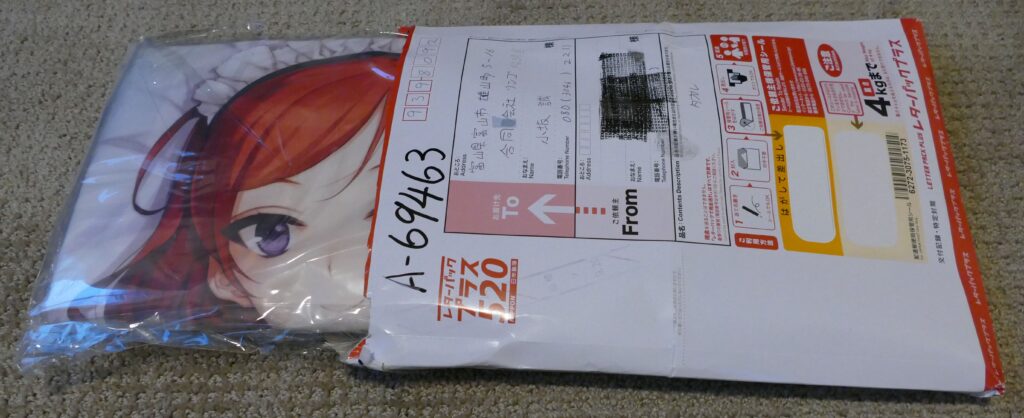
The front side of the folded cover conveniently showed Maki’s face. The back side, which happened to show her bust, also contained a small sticker.
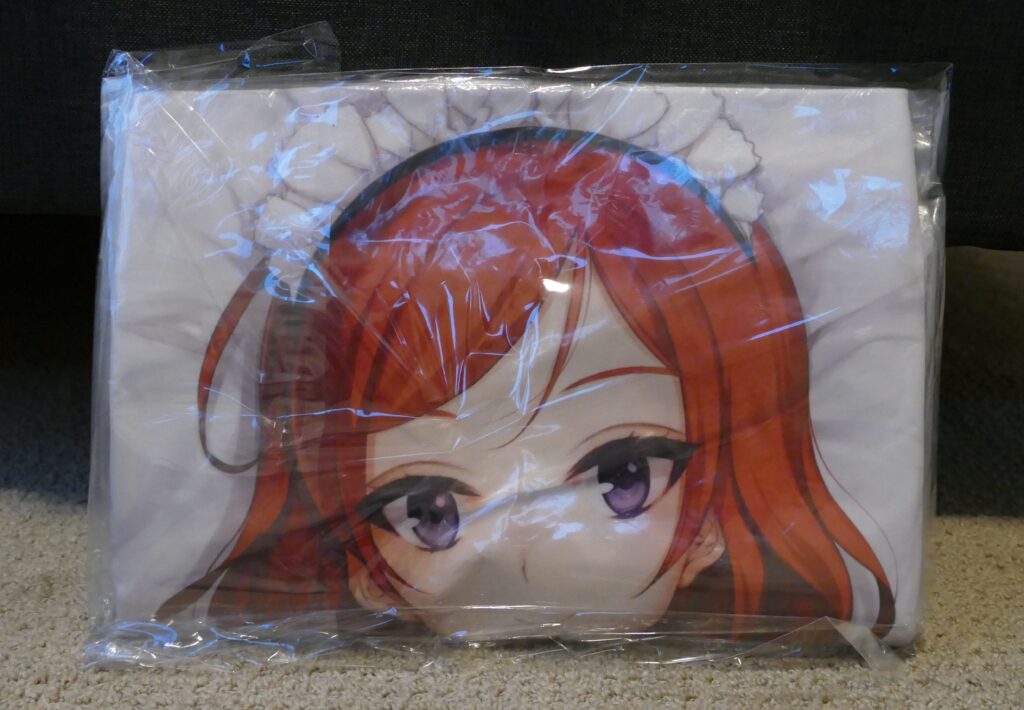
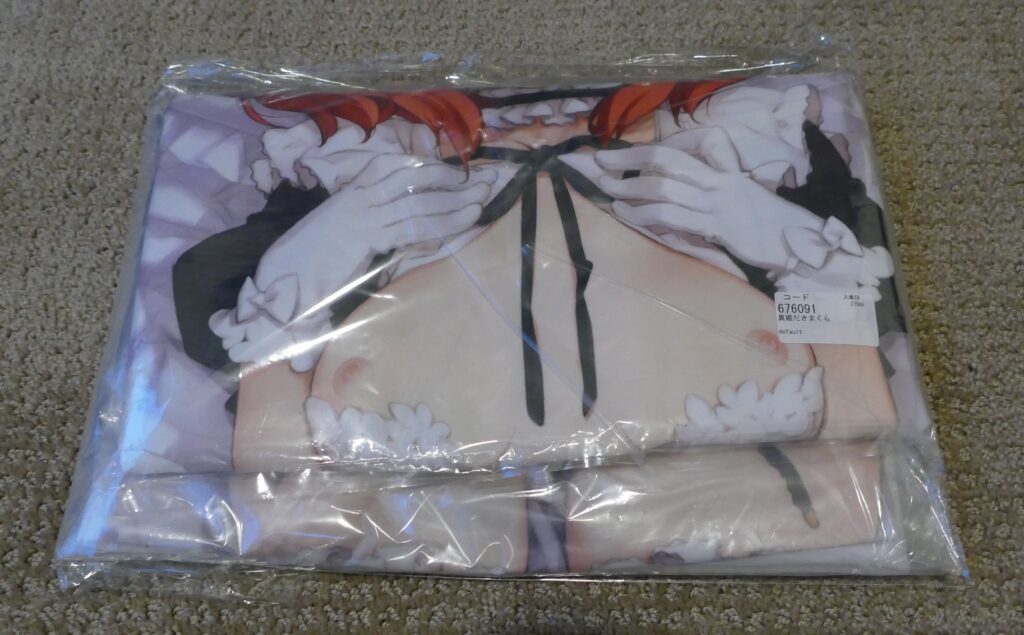
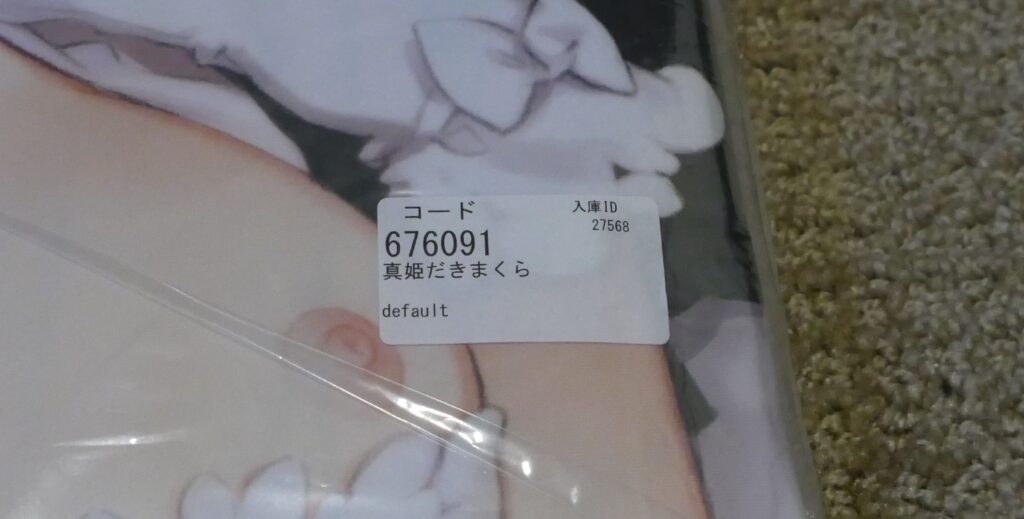
Setting the cover on my bed, I unfolded the outer plastic bag. The cloth was contained within a second layer of plastic packaging. (We’re three layers deep now: FedEx, Japan Post, and the convention sleeve!)
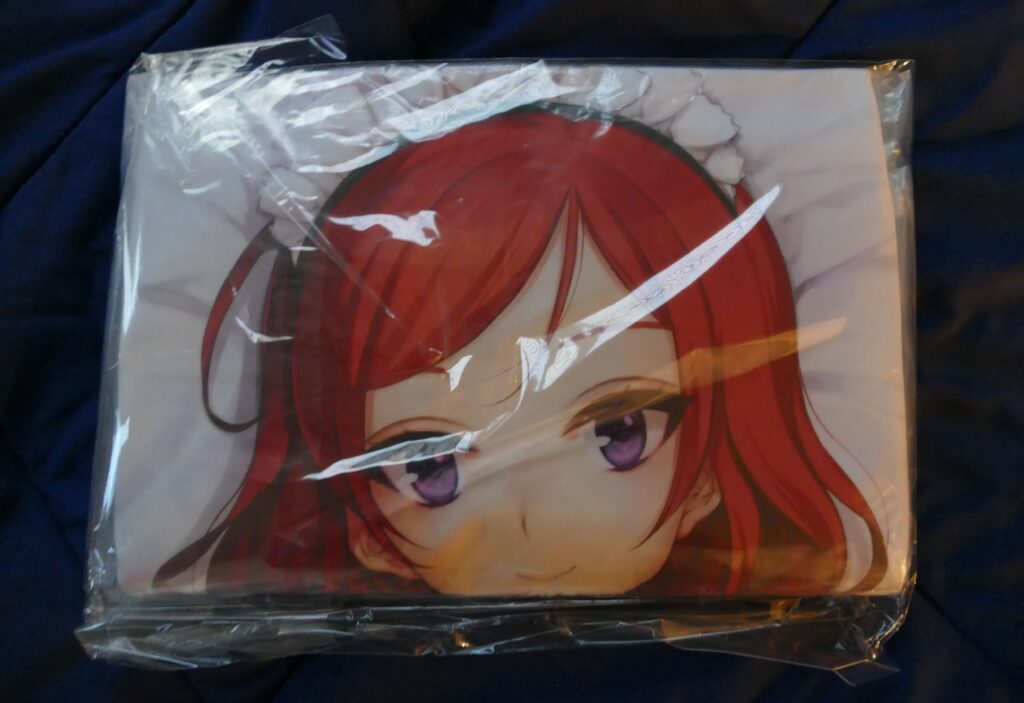
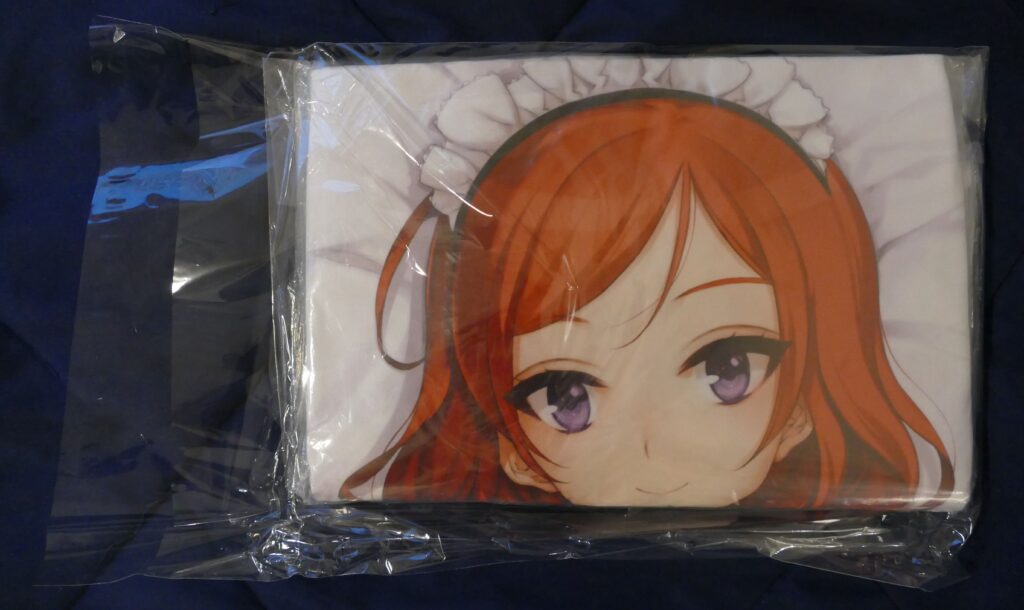
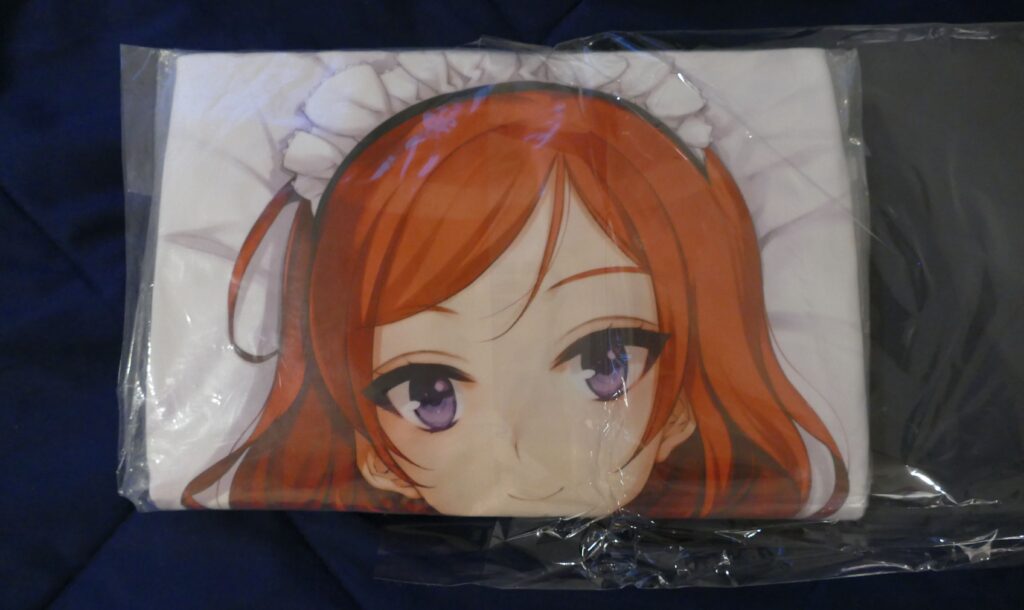
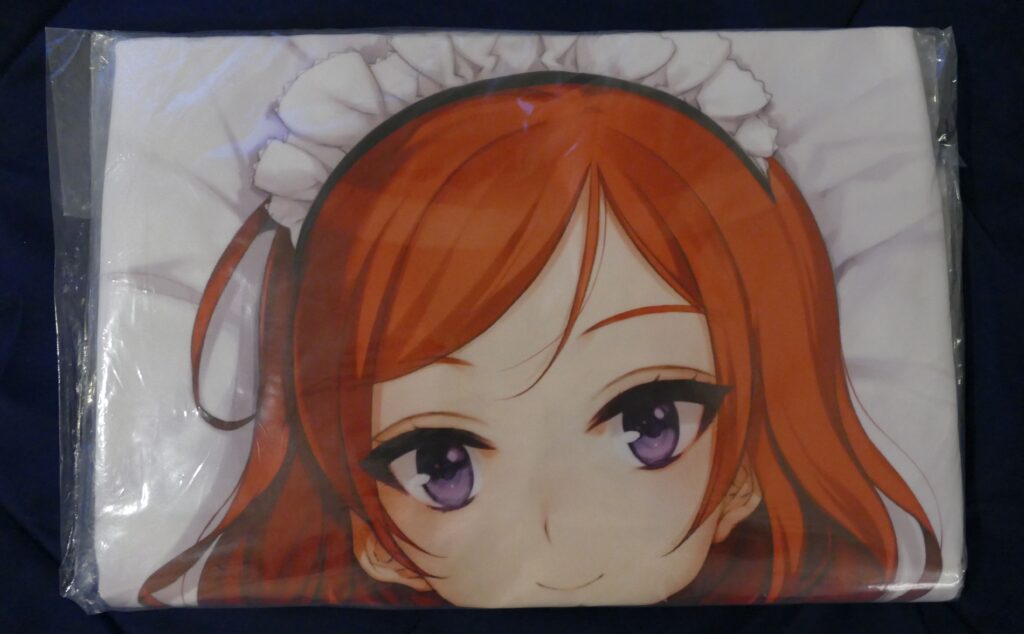
The cover finally unfolded once. Amazingly, that still wasn’t the last plastic bag; I slid the cover out of the sleeve to be greeted with another sleeve (that makes five layers, three of which were probably there before the online auction.)
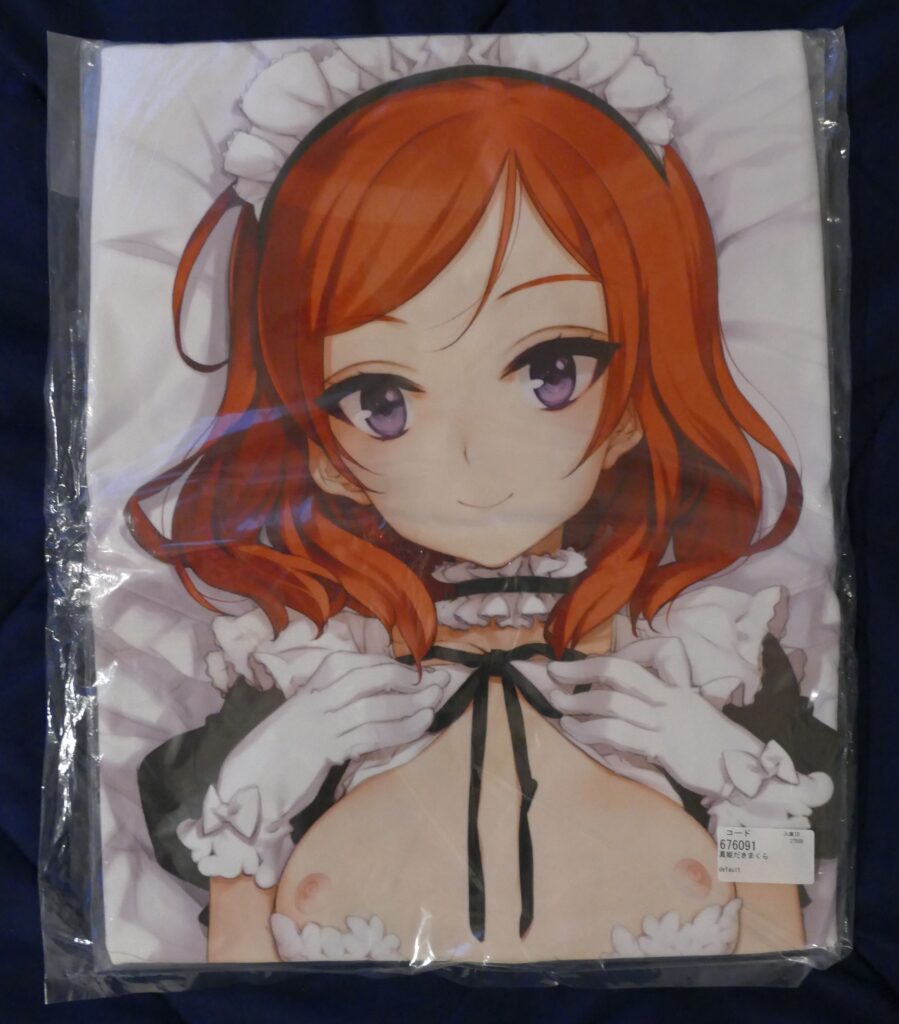
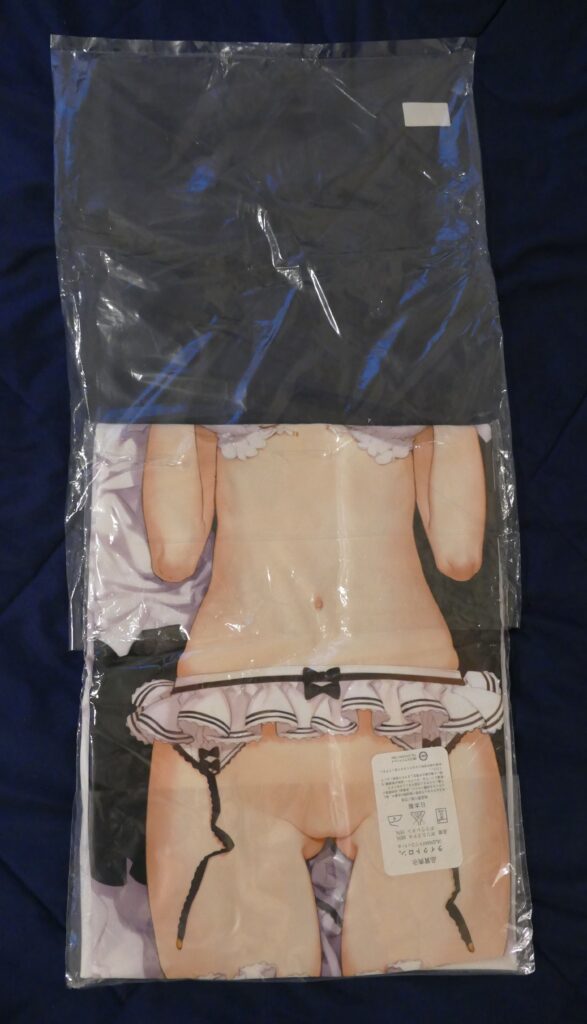
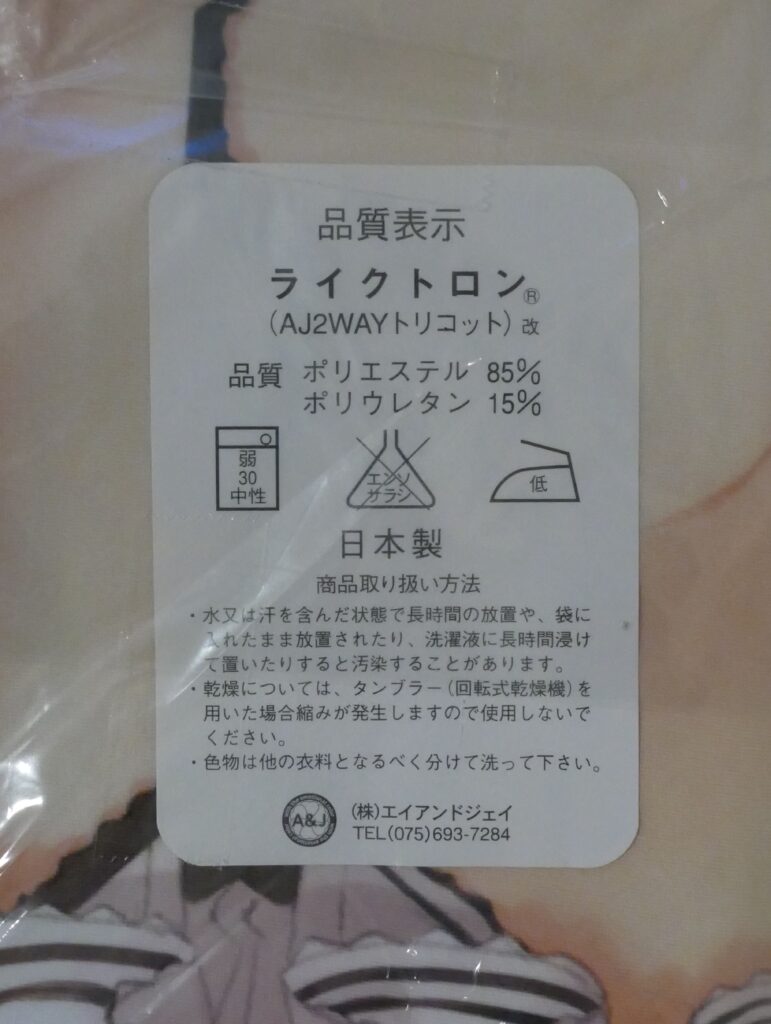
Yet again, I attempted to free Maki from the plastic. This time, I was actually greeted with cloth. In addition, the small paper tag containing some information about the material (85% polyester, 15% polyurethane, spelled out in katakana) came loose. The tag is titled “Liketron” (or “Lyctron”), a brand of two-way tricot material that the A&J company produces– this type of fabric is regarded as high-end due to its softness and print quality, but is also known for being easier to damage than some other materials.

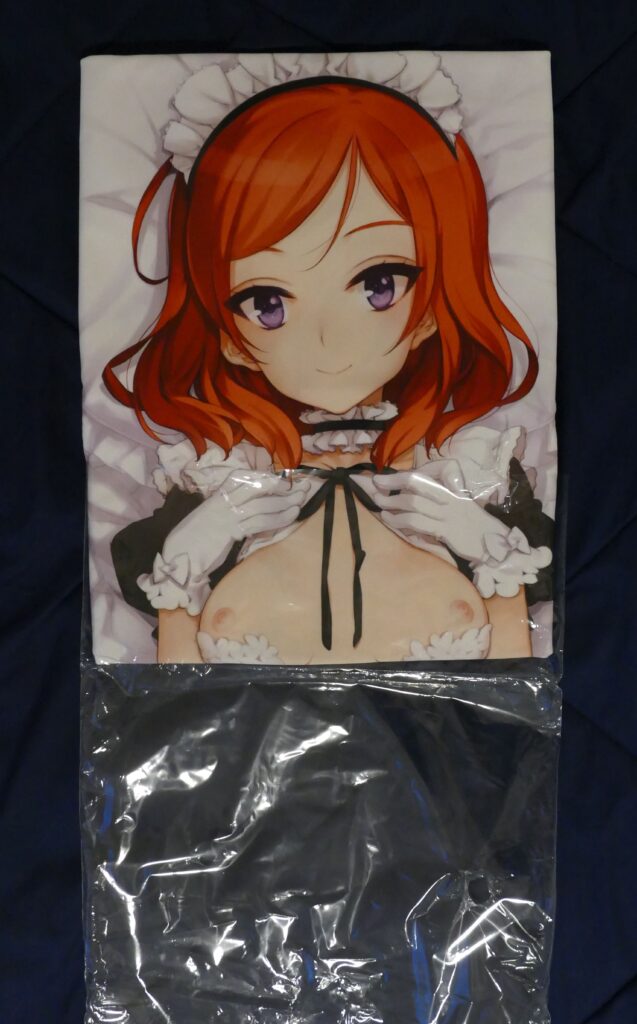
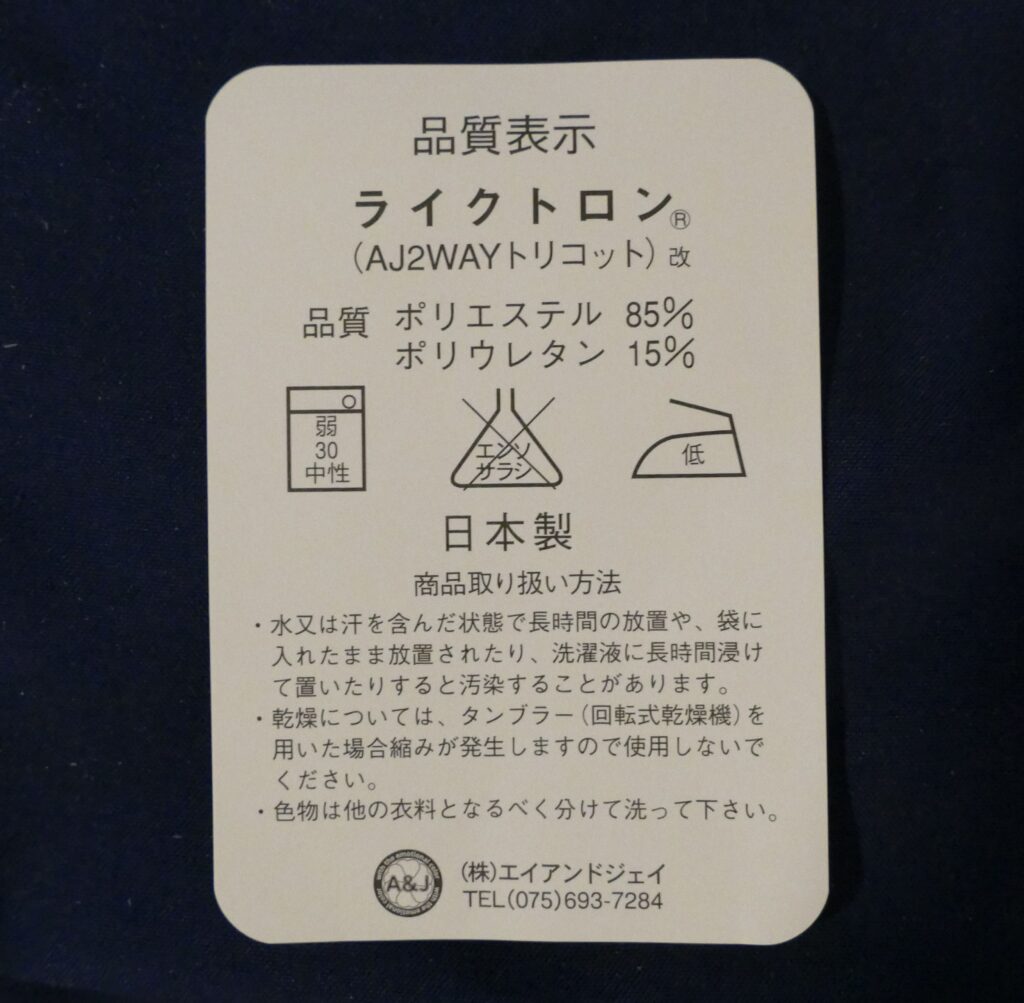
Once it was removed from the plastic, I found the fabric was folded around a cardboard rectangle that helped it keep its shape. It was only a few more folds to go until the entire thing was visible.
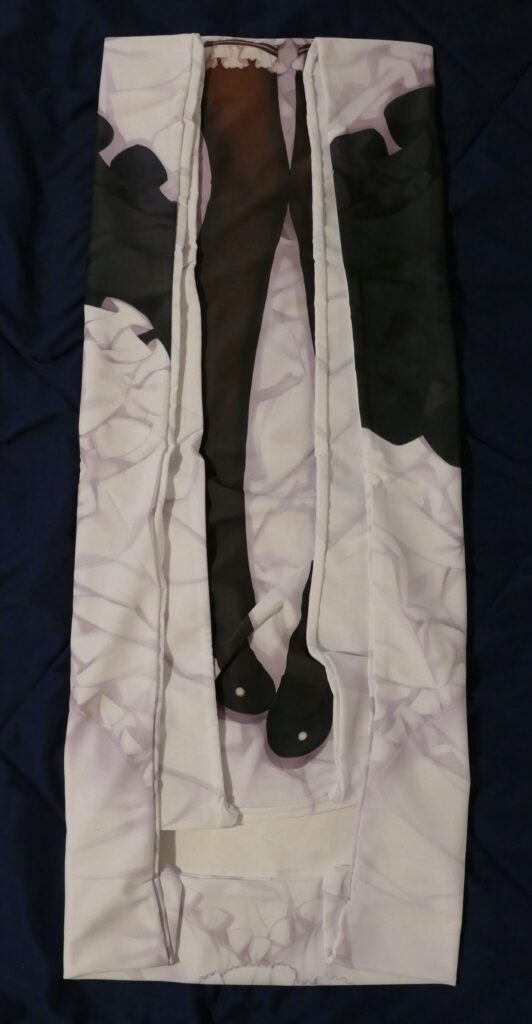
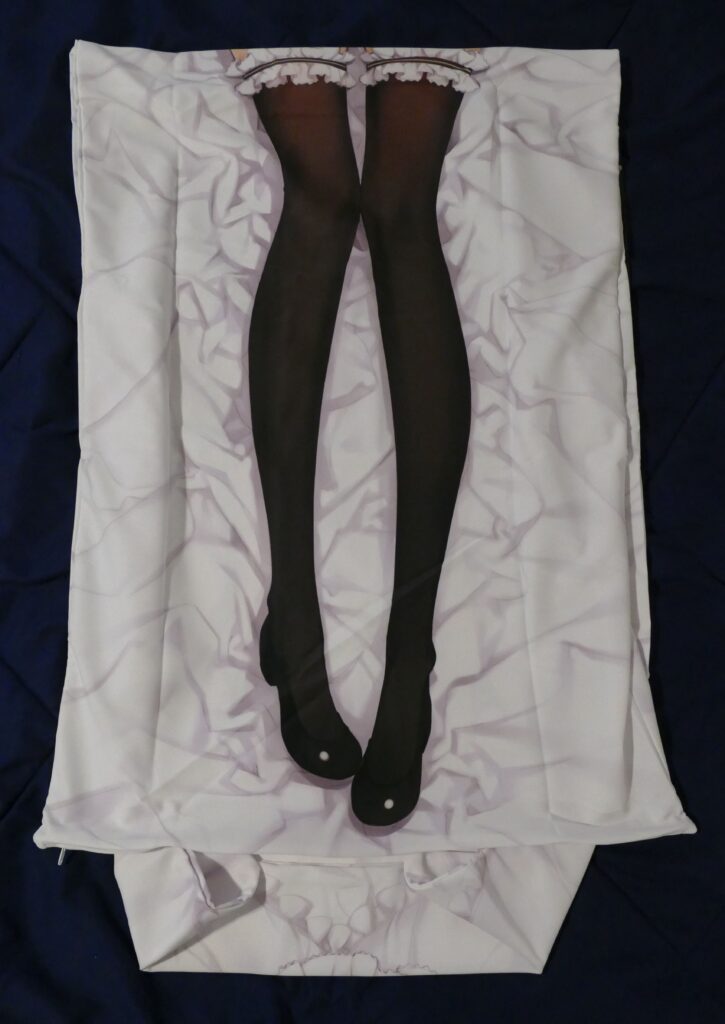
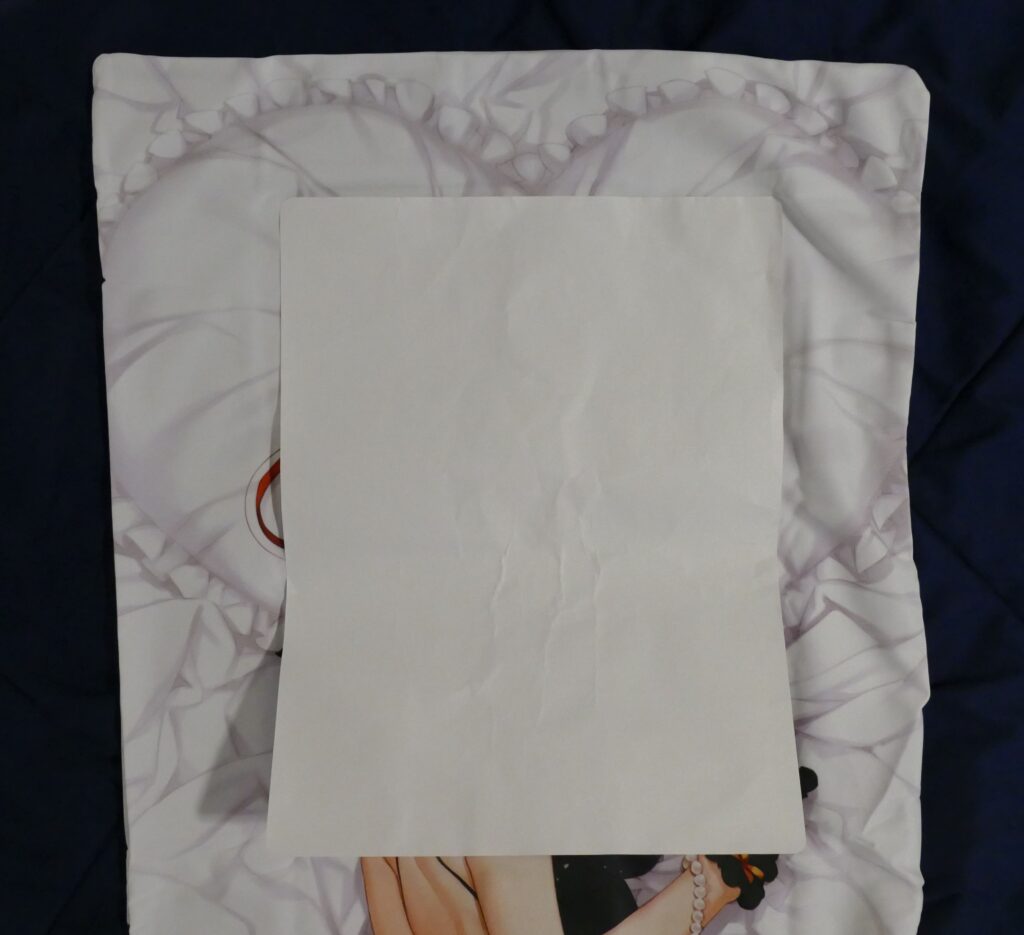
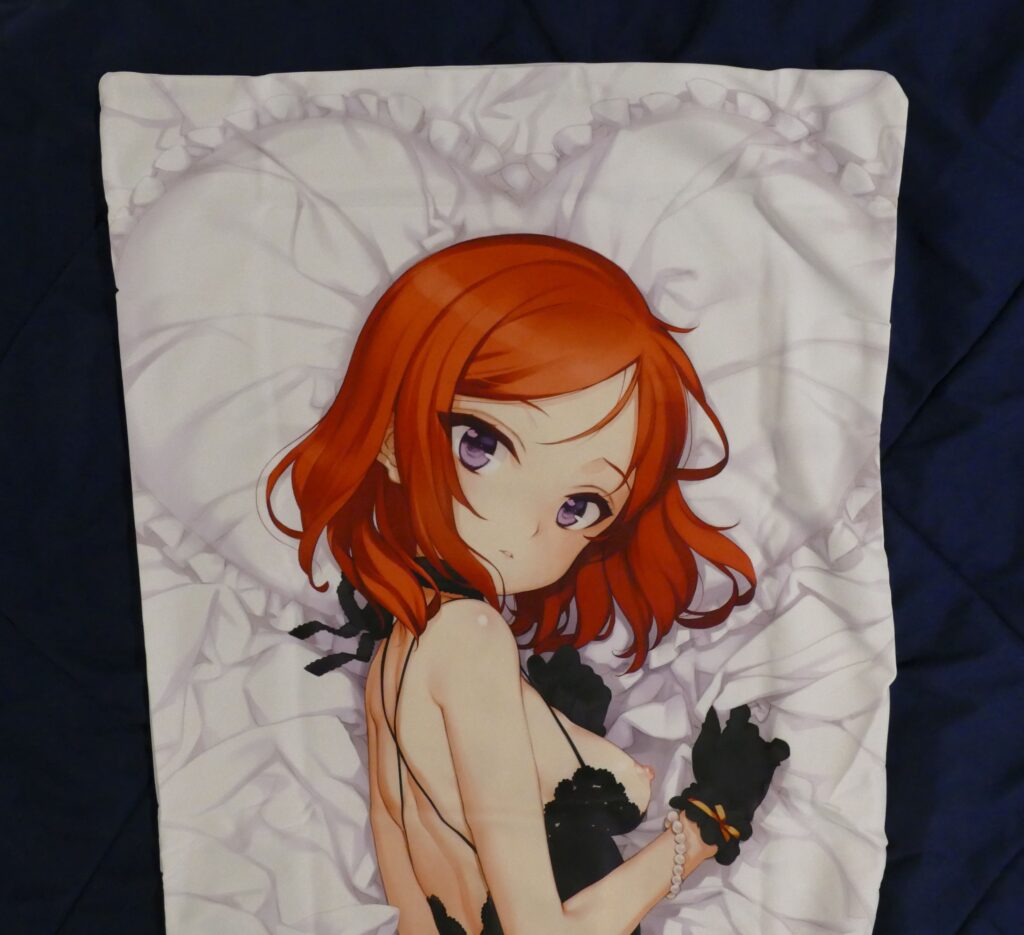
I finally ended up with a view of the cover, upside-down after the initial unfolding sequence.
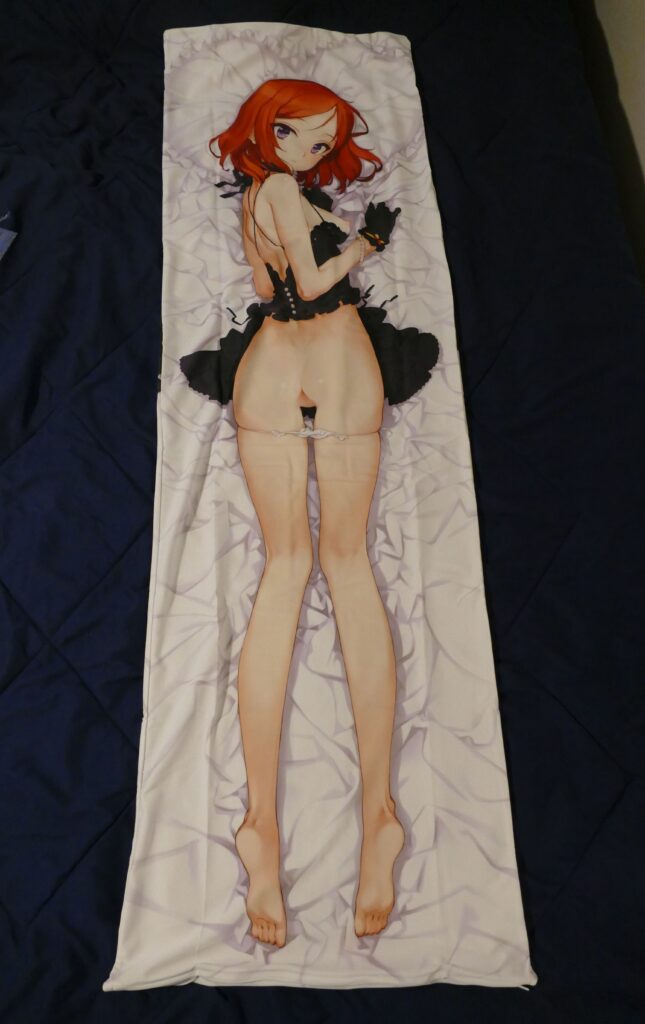
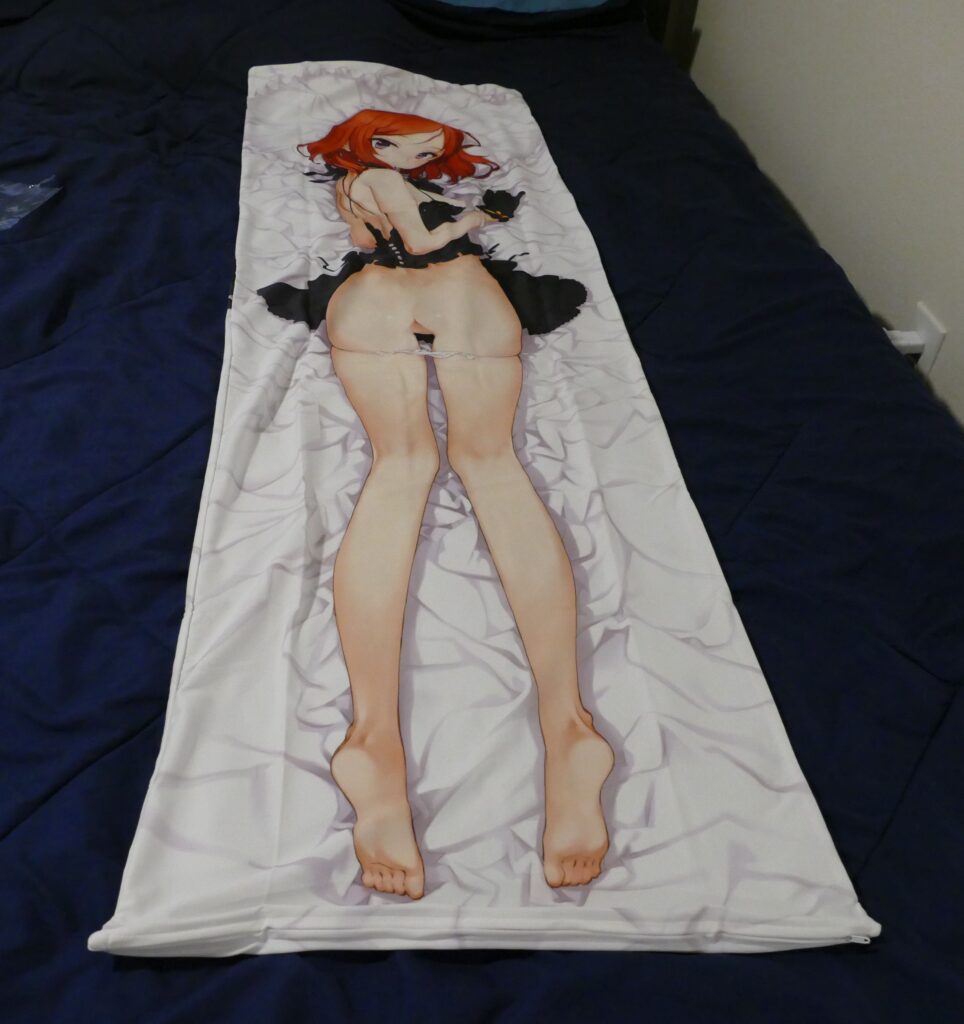
I wasn’t able to actually use the cover since I didn’t have a pillow yet, but I took some close-up shots of both sides to capture the quality of the printing before putting it away.
The last piece I was interested to see in person was the zipper. The cover has its zipper on the bottom (a normal arrangement for printed covers), with the fabric stitched to hide the length of the zipper when zipped. I noticed that the zipper didn’t quite extend to the edge of the fabric– this is also fairly normal for covers, although as I’d learn later, it makes putting the cover on (and taking it off) a little difficult.
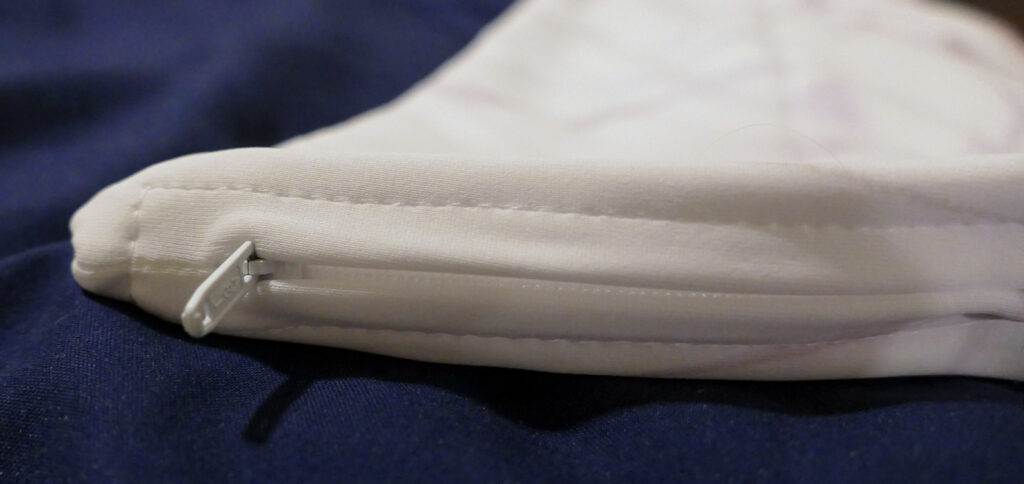
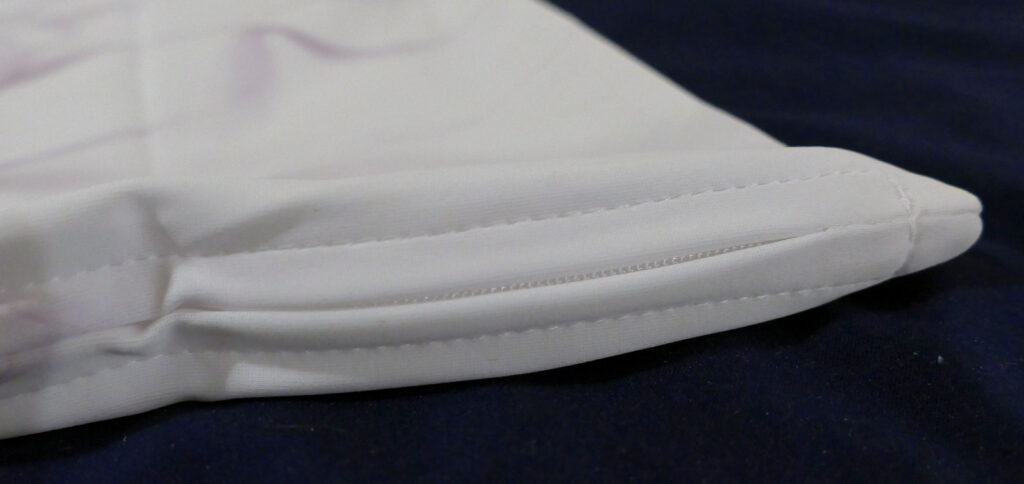
At this point, I had what I wanted– the cover. Now, I needed to get my hands on an actual pillow. The rest of the story required less resourcefulness, but was obviously still important to the final execution.
Overcover & Pillow
Backing up to earlier in the story, I went with the inner pillow I mentioned from Dakimakuri. I stuck with my initial strategy of selecting the heaviest one available, which got me 4.4kg of the Kumochi stuffing in a 160cm length to match the cover. (As of 2023, the Kumochi in 160cm is now only offered at a weight of 4.2kg, and a new option called Kumoame is available with a whopping 6.5kg weight; I haven’t tried that one yet.)
As previously mentioned, I also ordered a navy blue overcover (which matches my bed sheets) from Dakimakuri. The pillow ran me $125, the overcover cost $45, and shipping added an additional $50 onto the total price. I received an email when the inner pillow shipped via SAL from Guangzhou, China, and a second email when the the overcover shipped via USPS from Texas.
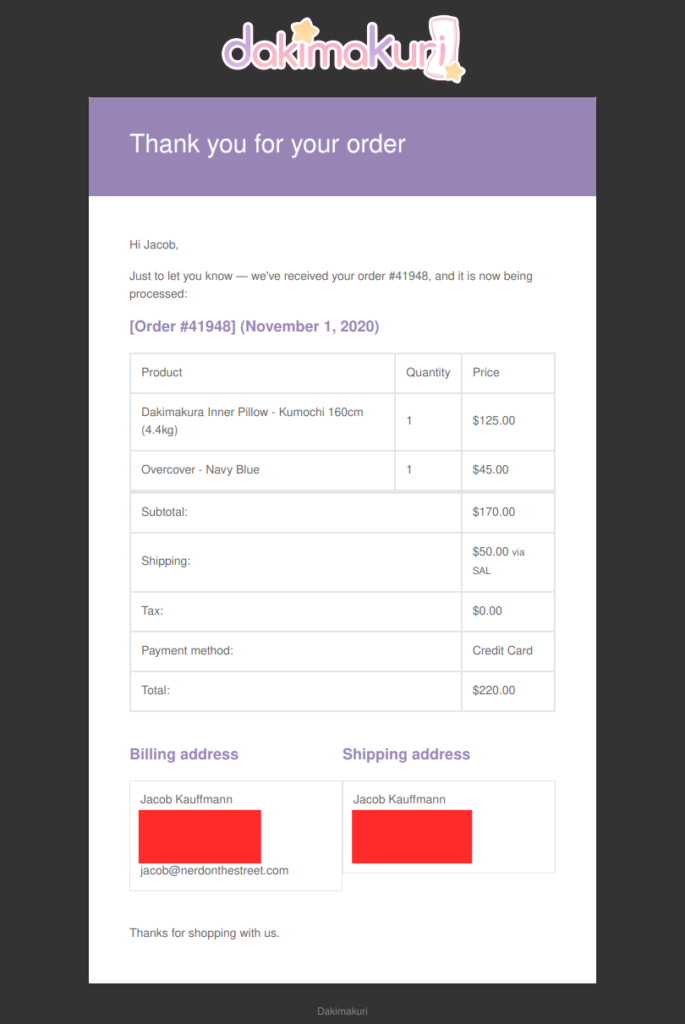
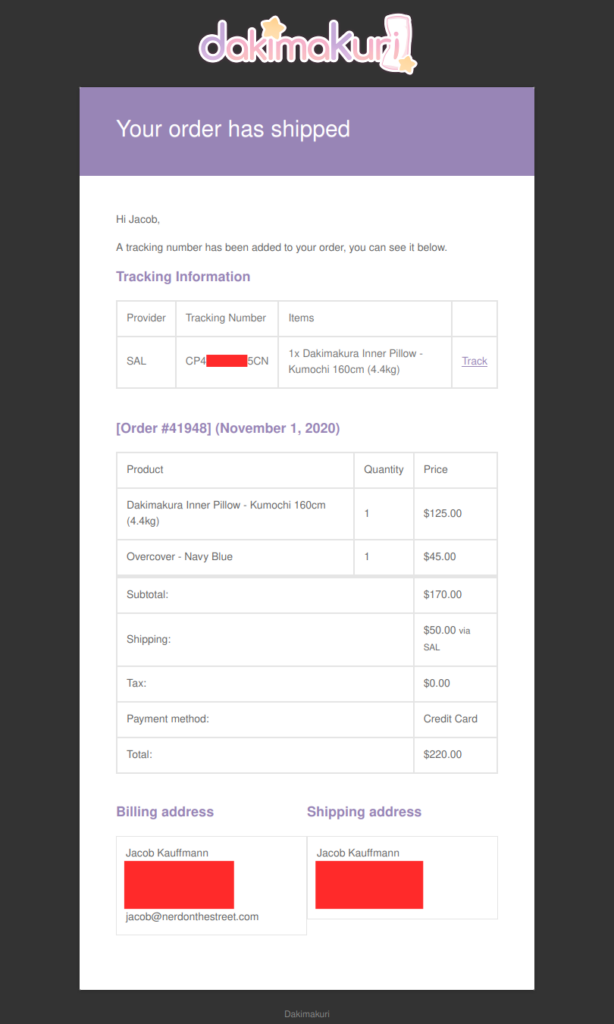
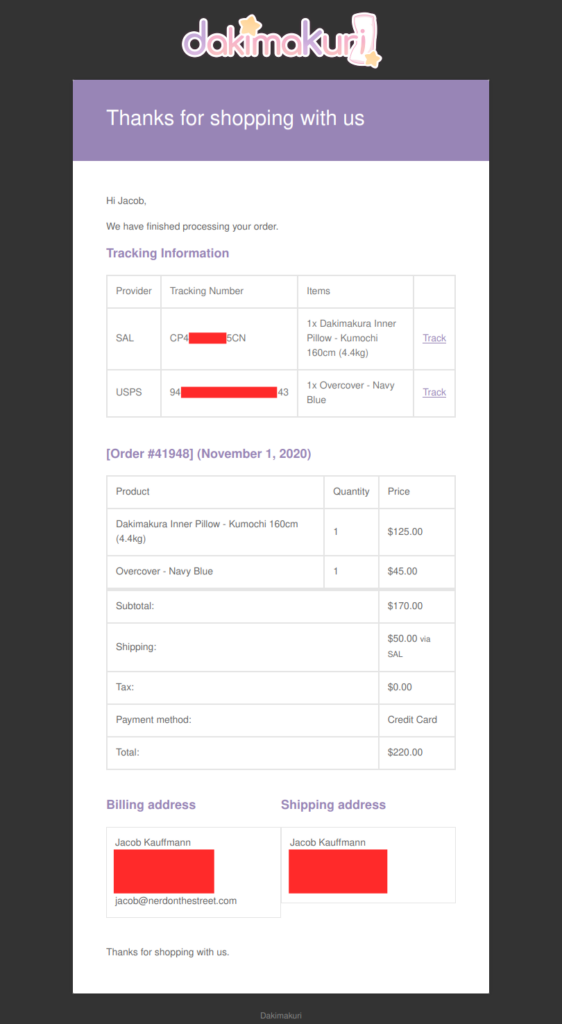
I placed the order on October 31st, and the overcover arrived first on November 9th. It was shipped in a padded envelope with a USPS First-Class package label, with a “from” name of “Amazon Store”.
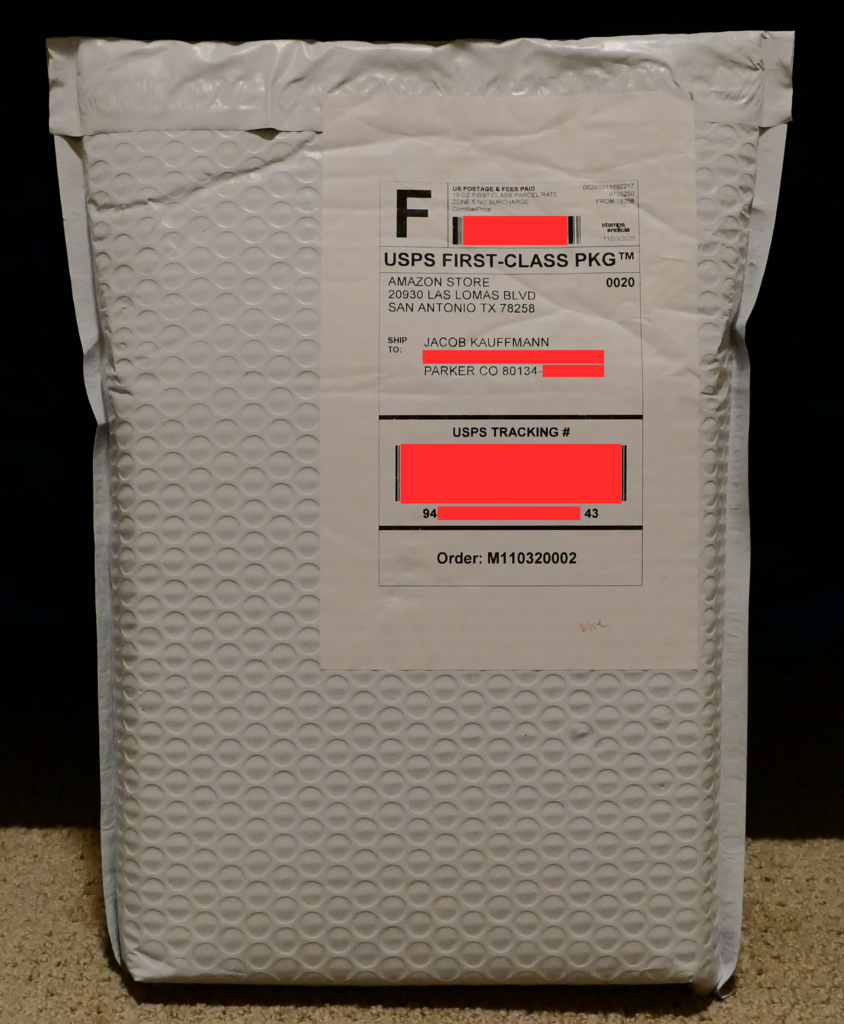
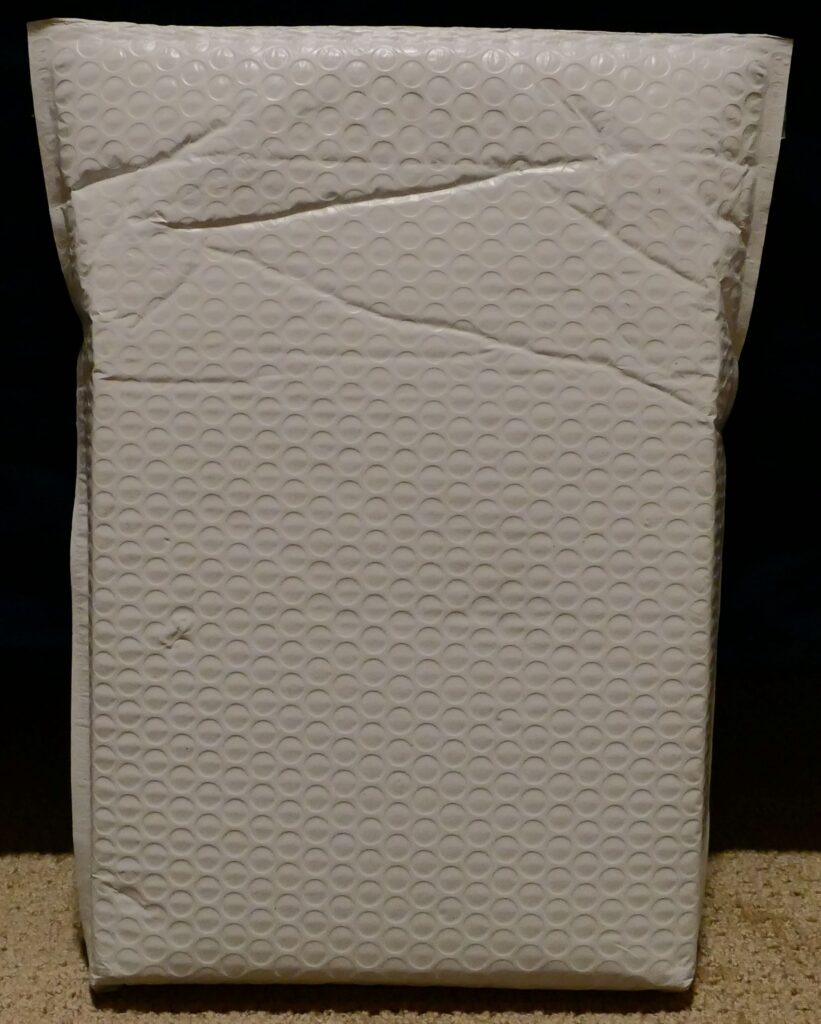


Inside, I found a colorfully branded package consisting of printed cardboard inside of a clear plastic bag with cloth linings and a zipper. The materials reminded me of the packaging that my Amazon bed sheets came in. The inner cardboard sleeve depicted anime girls much cuter than most actual dakimakura users lying down with slightly undersized dakimakura pillows.
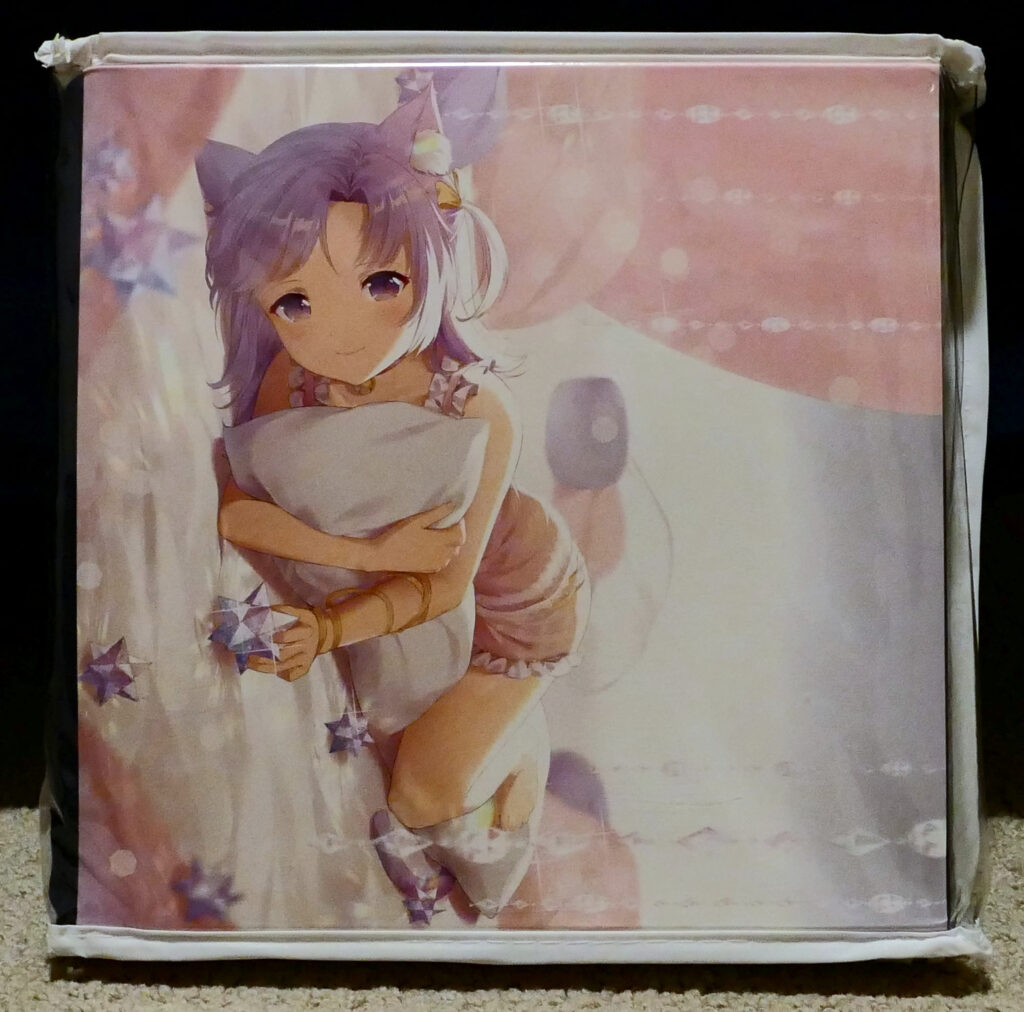
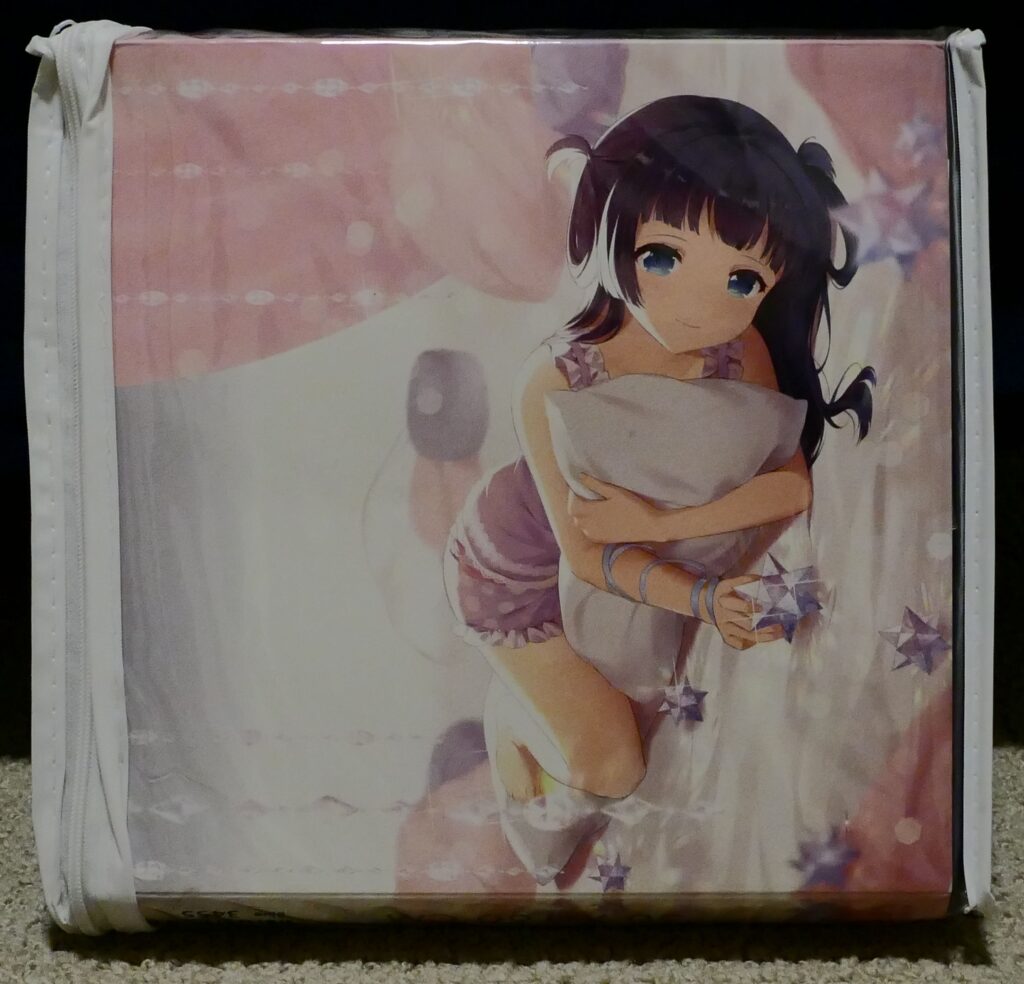


Unzipping the bag, I saw the overcover within. Pulling it out, I saw that a card and two stickers were also included.
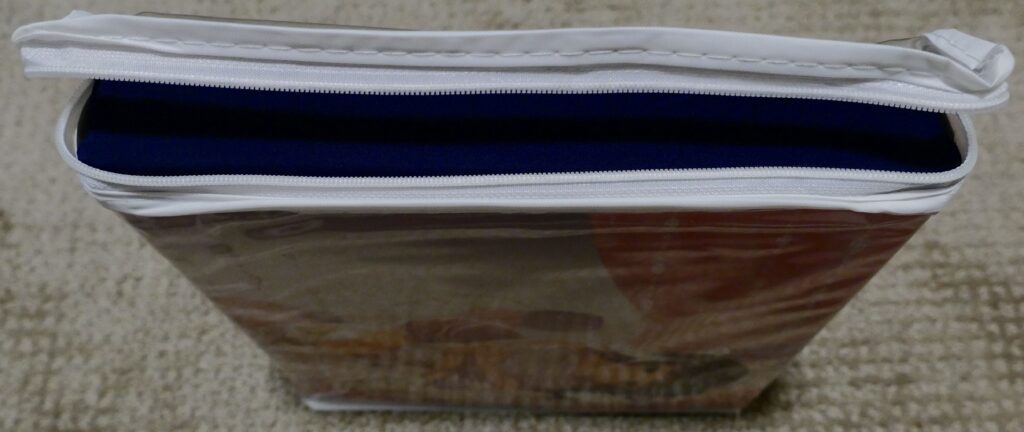
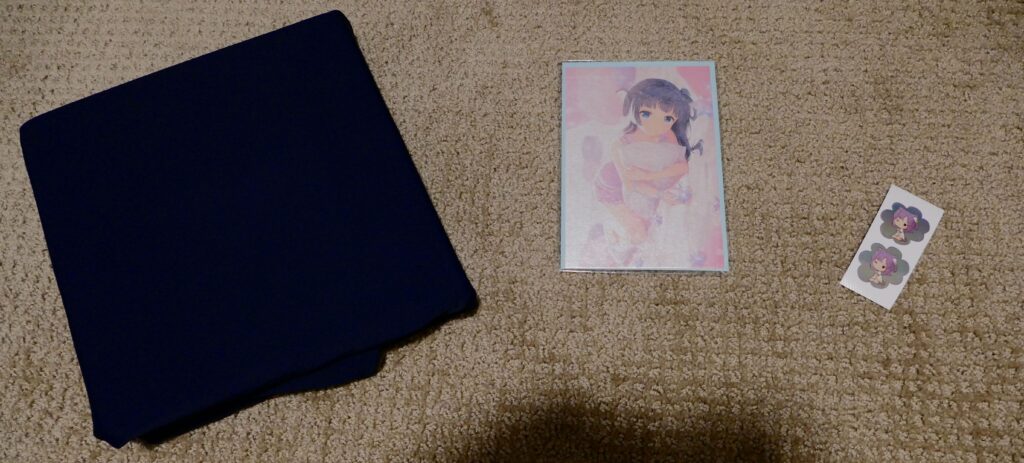
The overcover was folded around a piece of cardboard similarly to the printed dakimakura cover earlier, but without any thought for which particular section was on display after folding.
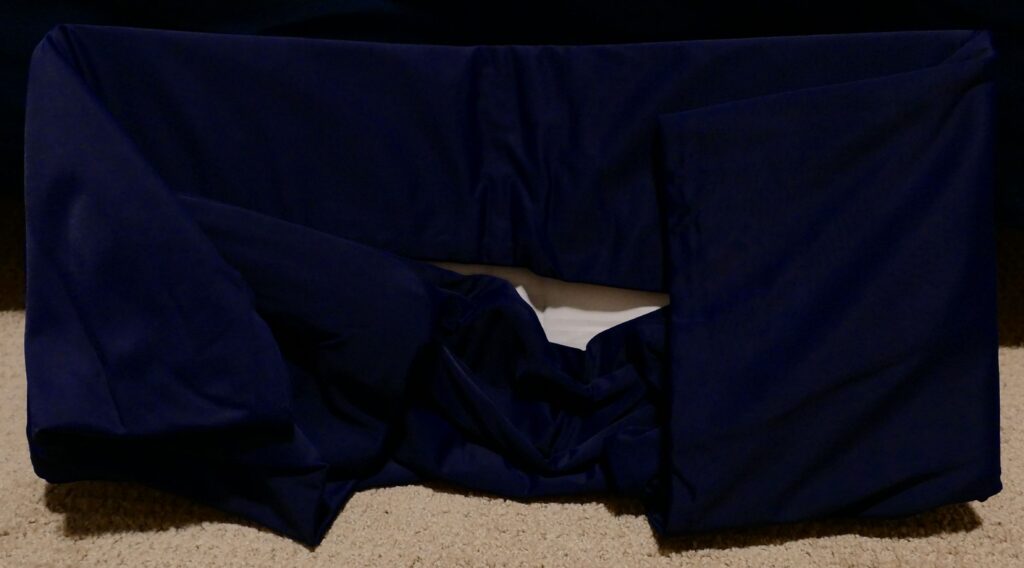
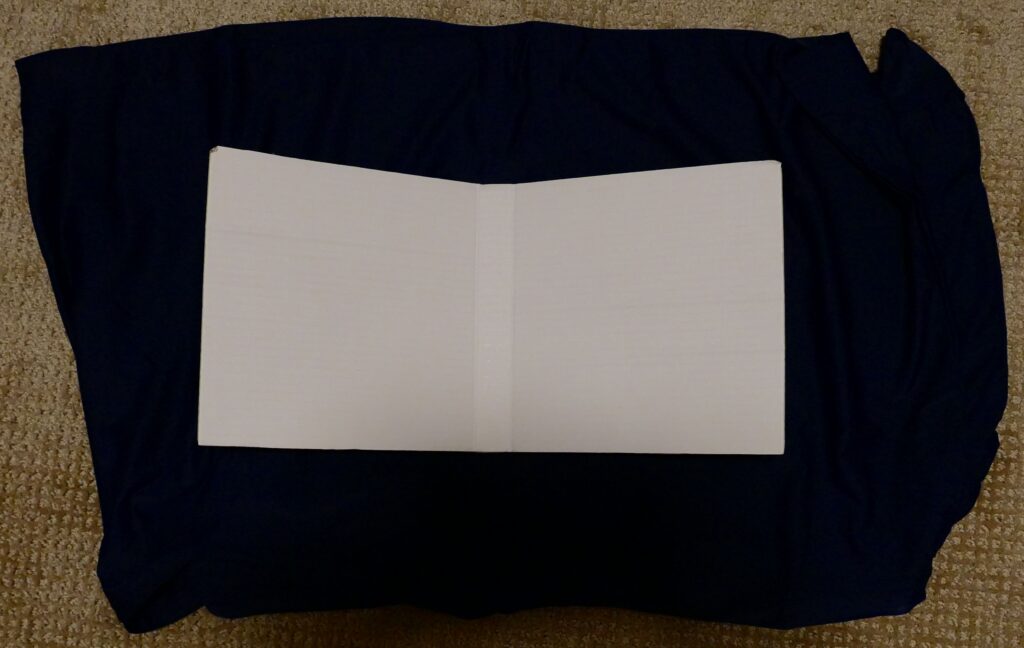
Laying the overcover out on my bed, I was pleased at how well it matched the color of my comforter and other linens.

The card mentioned earlier seems to be a postcard, complete with an envelope of matching size.
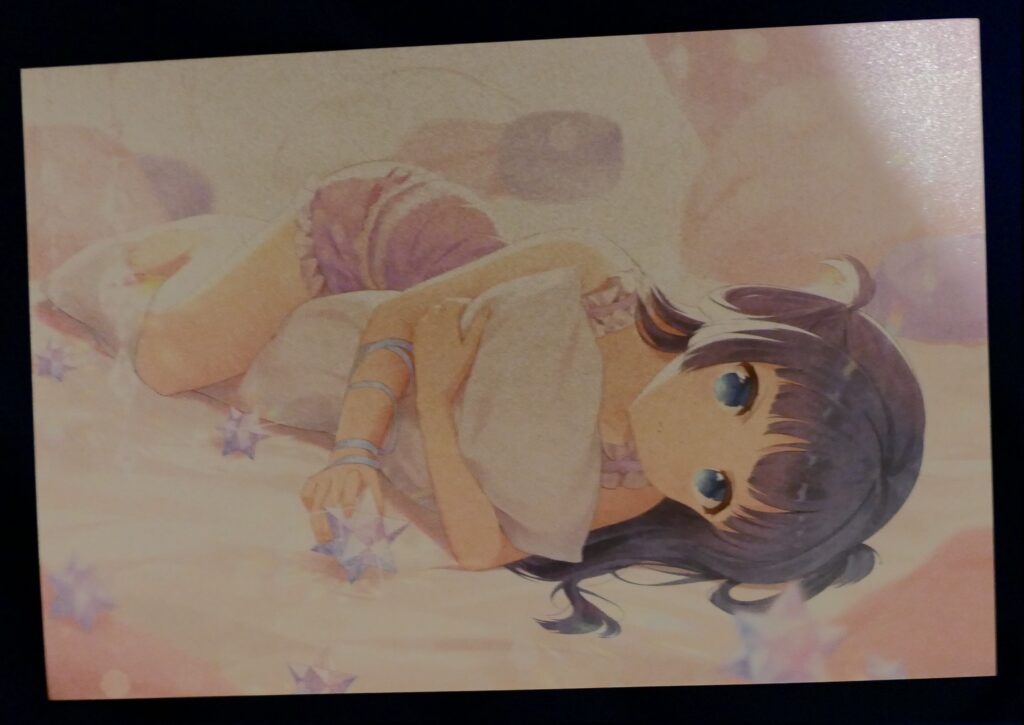
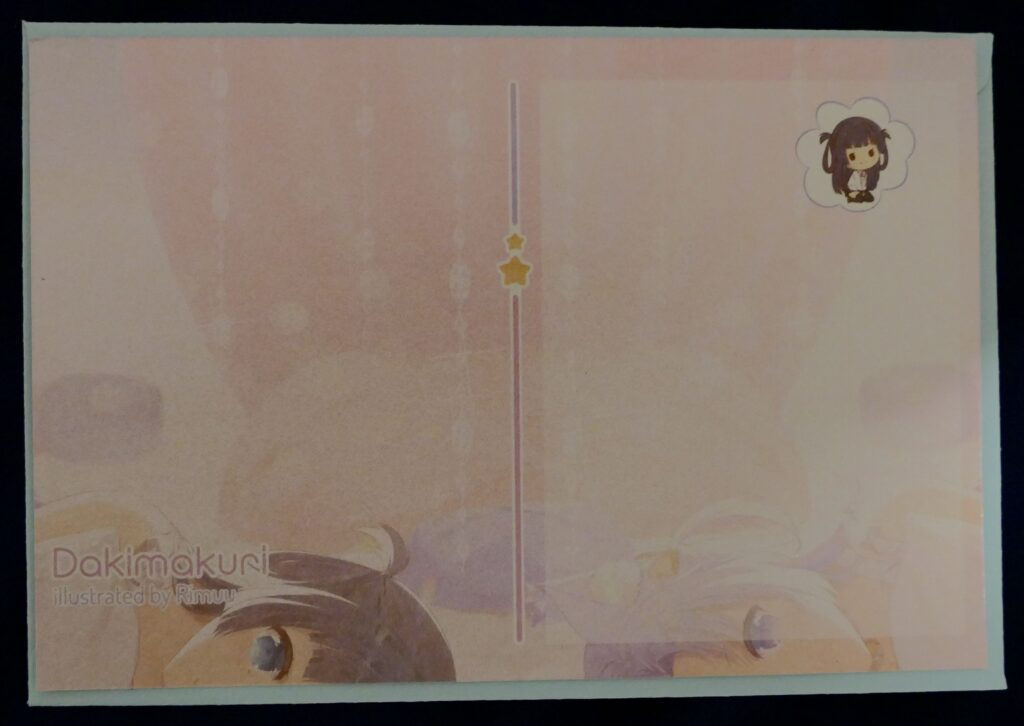
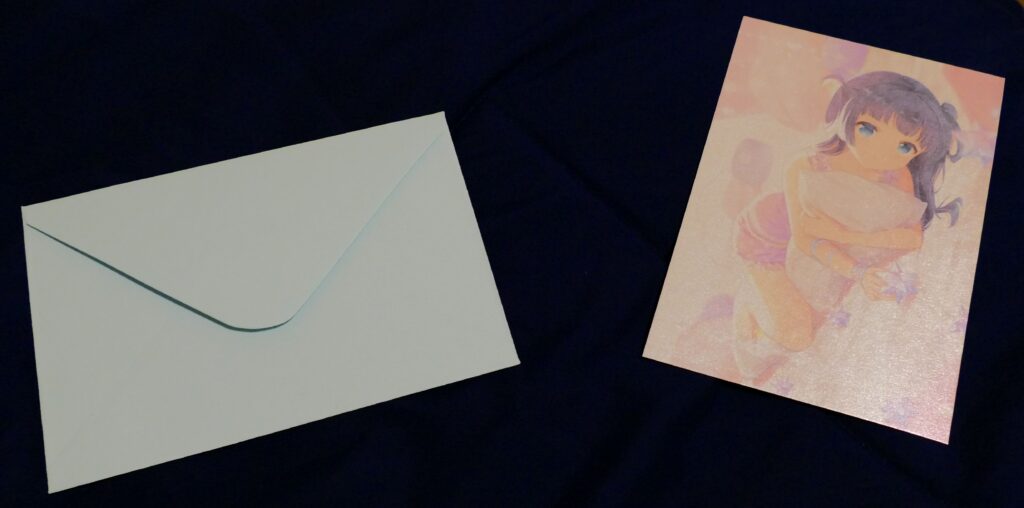
At this point, with two covers folded neatly in my closet, I still had to wait for the actual pillow to arrive.
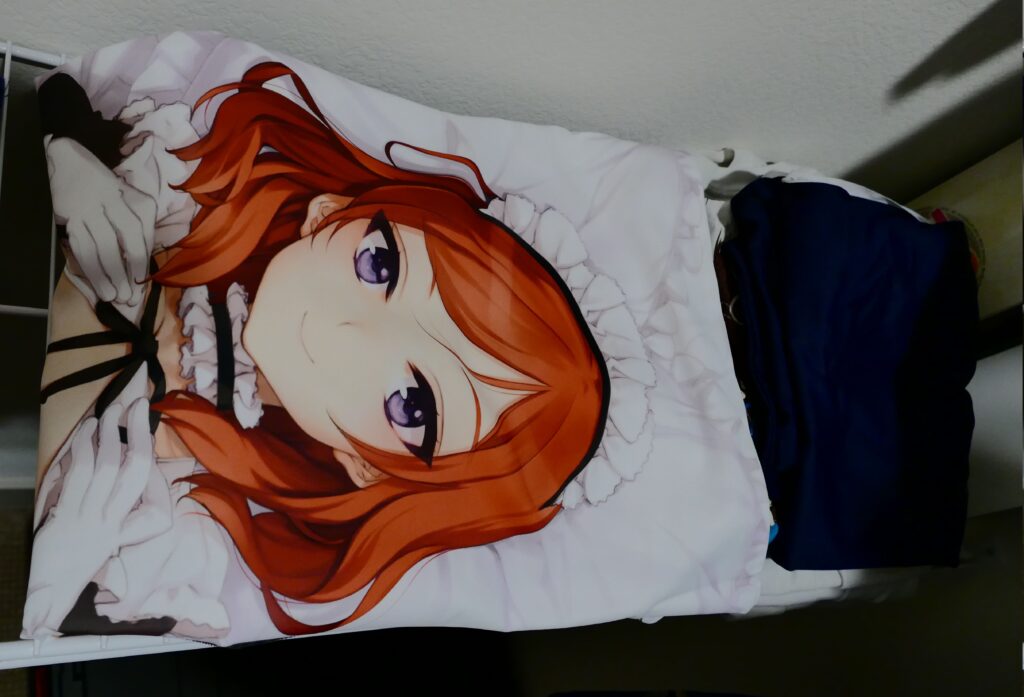
The pillow itself was finally delivered on November 19th, about two and a half weeks after I placed my order. When it was delivered, I was immediately impressed at how small the box was, although I could tell that it was stuffed full– the box was comically bulging outwards, and didn’t sit flat when set down. The box was also a bit beat up, and at least one of the labels had ink running like it had gotten wet.
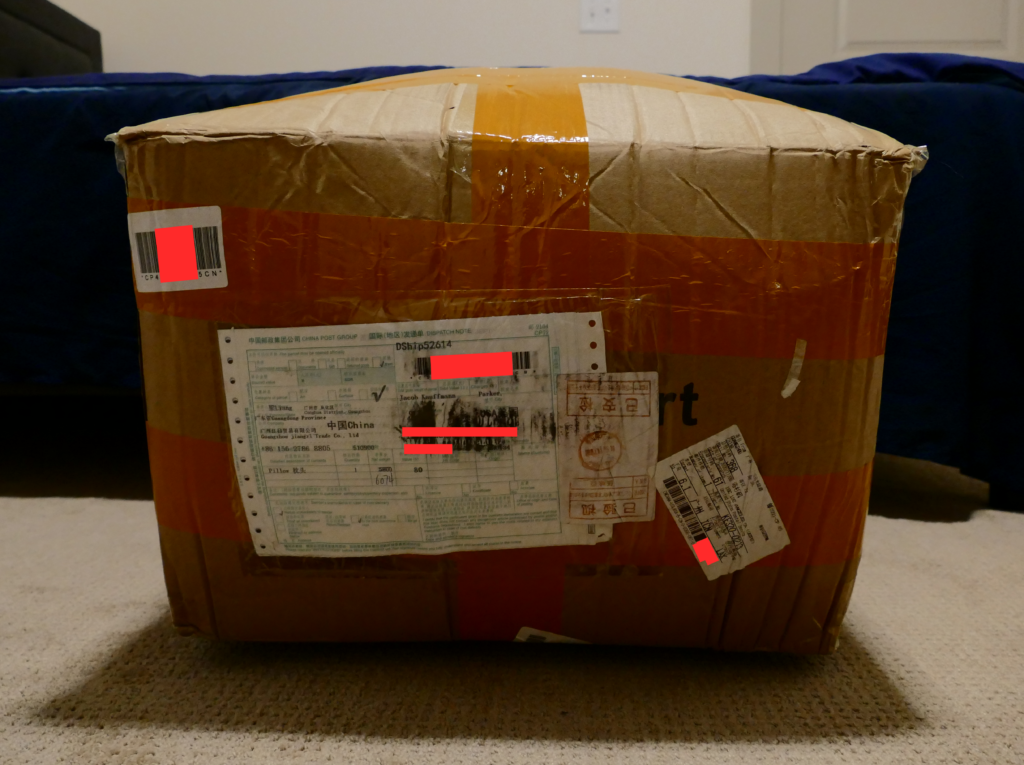
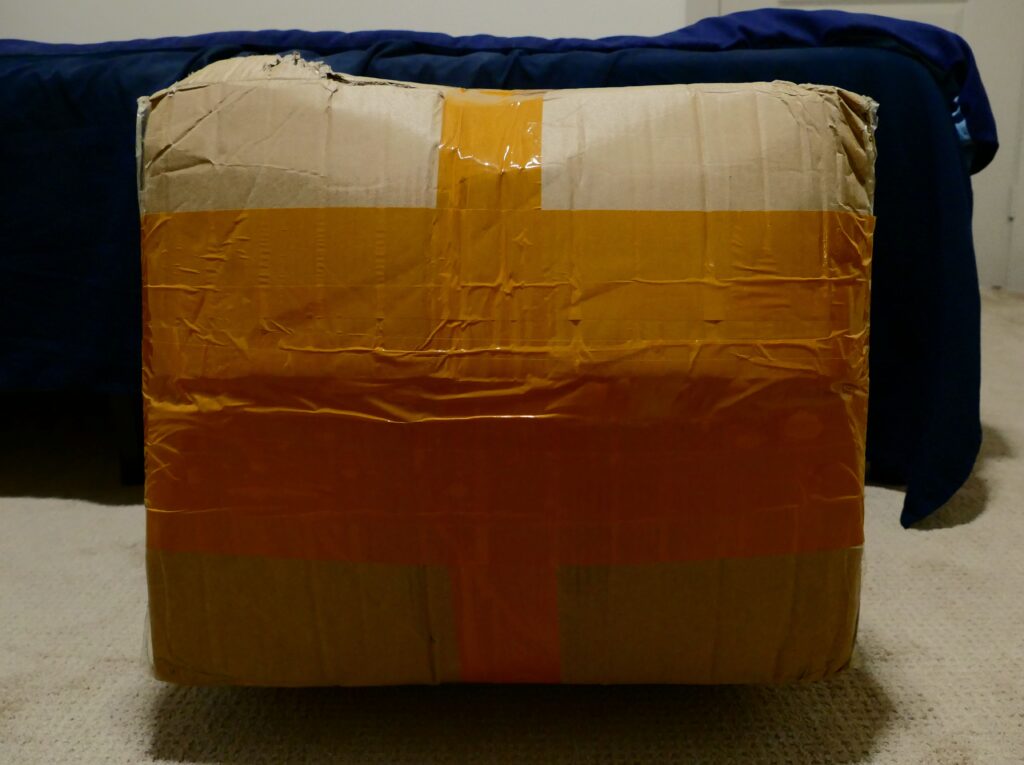
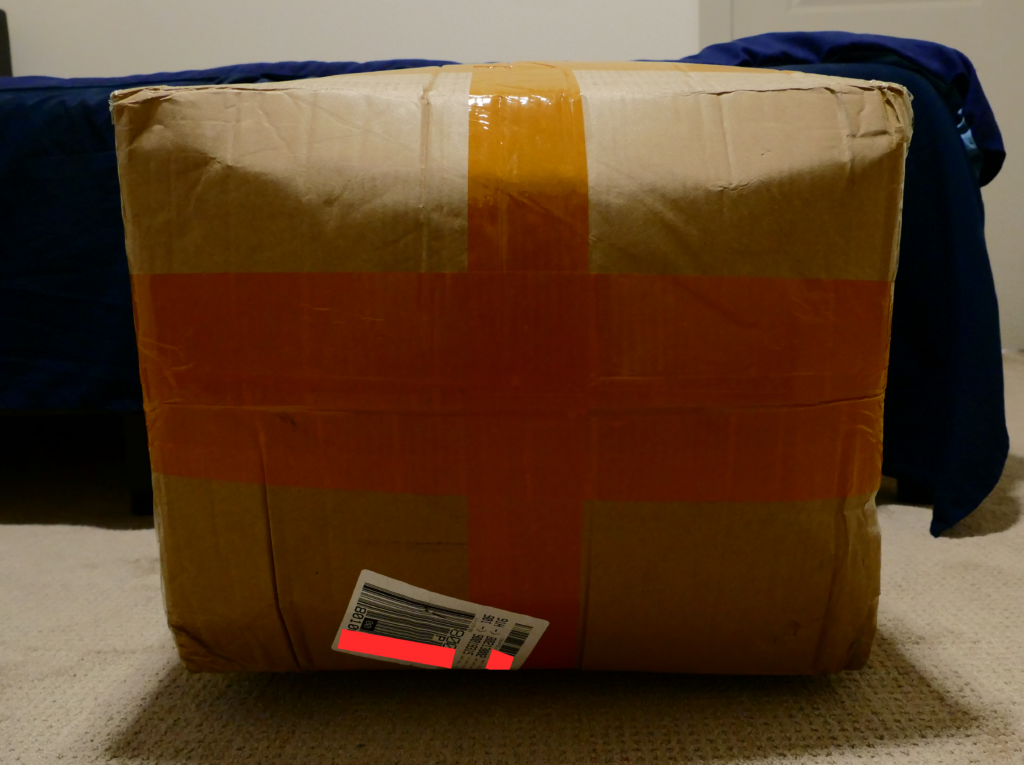
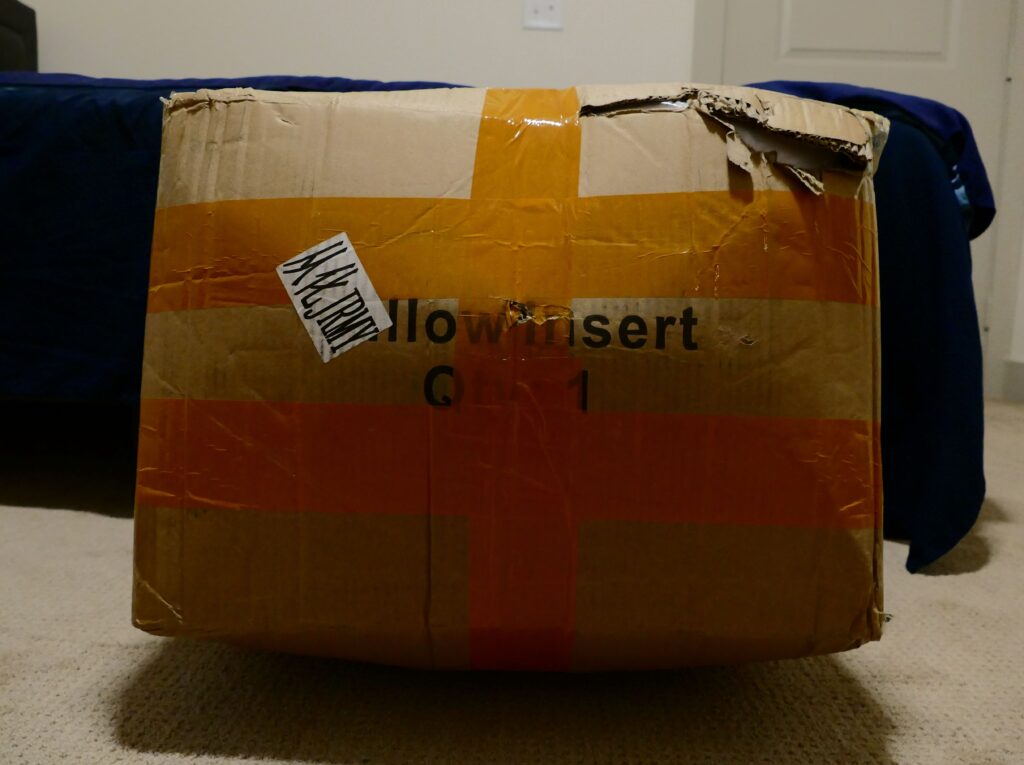
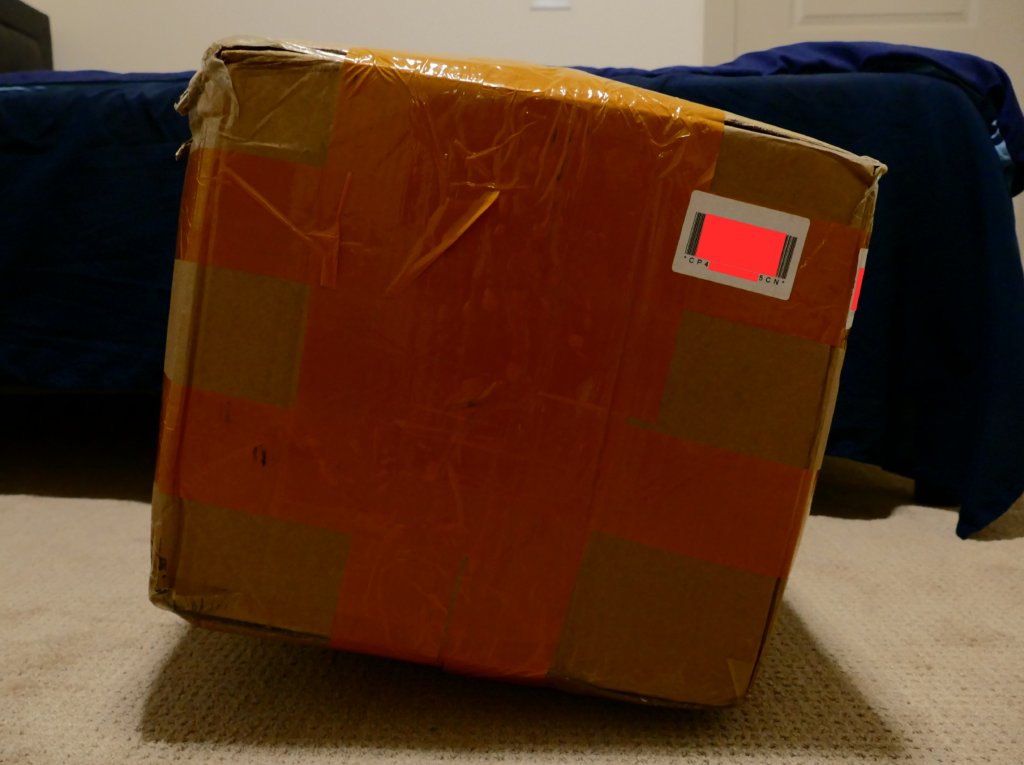
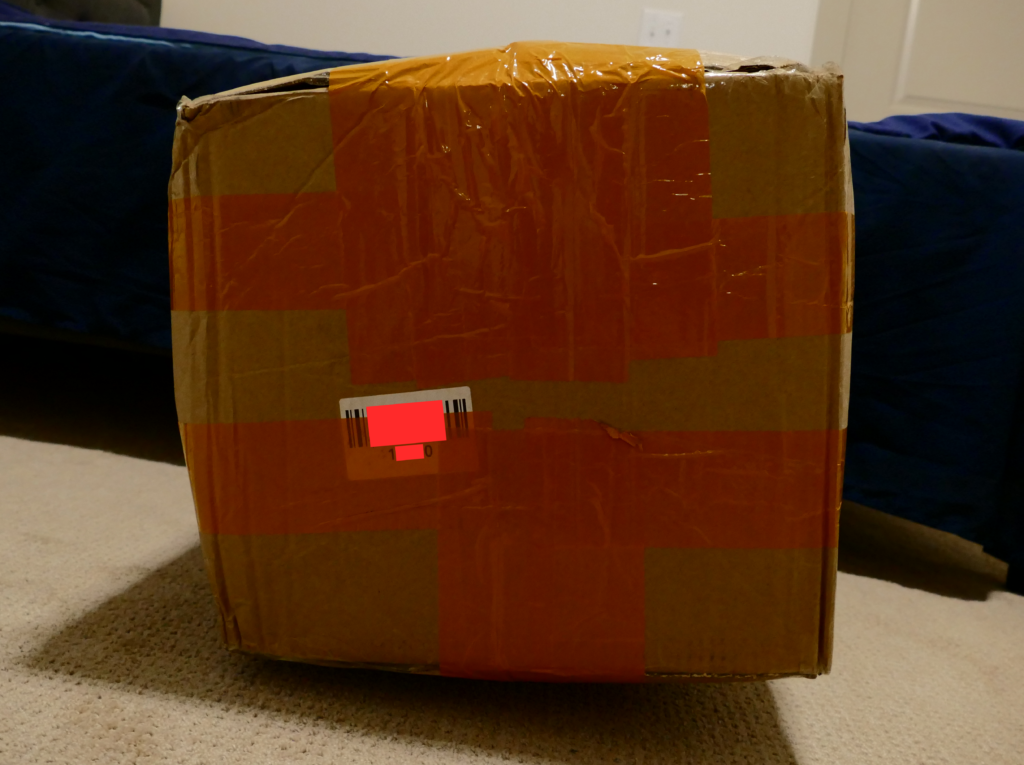
As seen in the fourth image above, part of the box was actually torn clean open when I received it. Fortunately, the pillow itself was encased in a sealed plastic bag, so I didn’t have to worry too much about it being dirty from the trip.
Since the box was heavily taped, I tore a flap off from the existing hole.
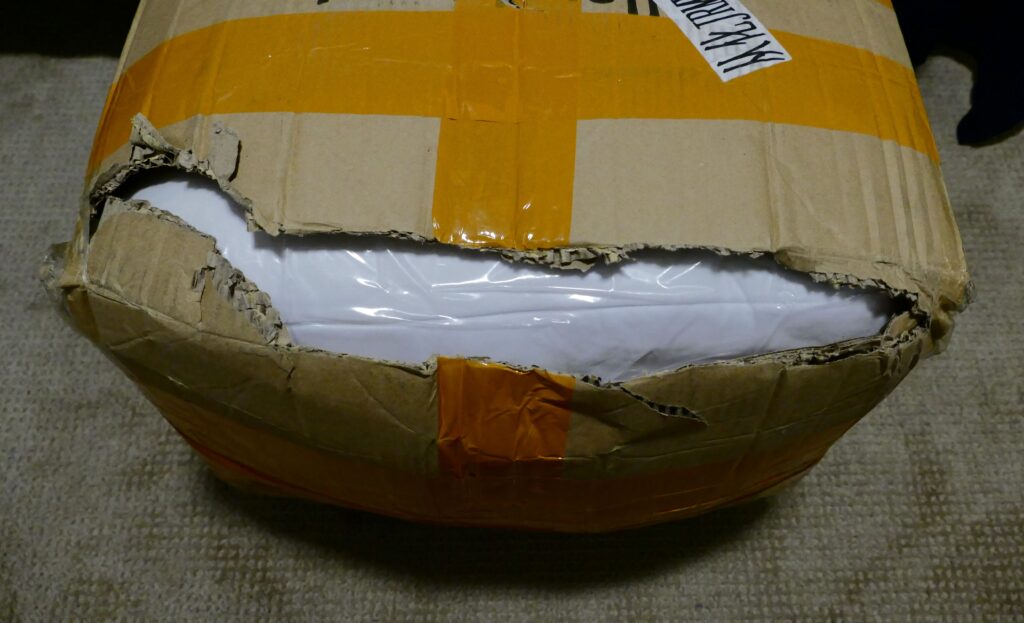
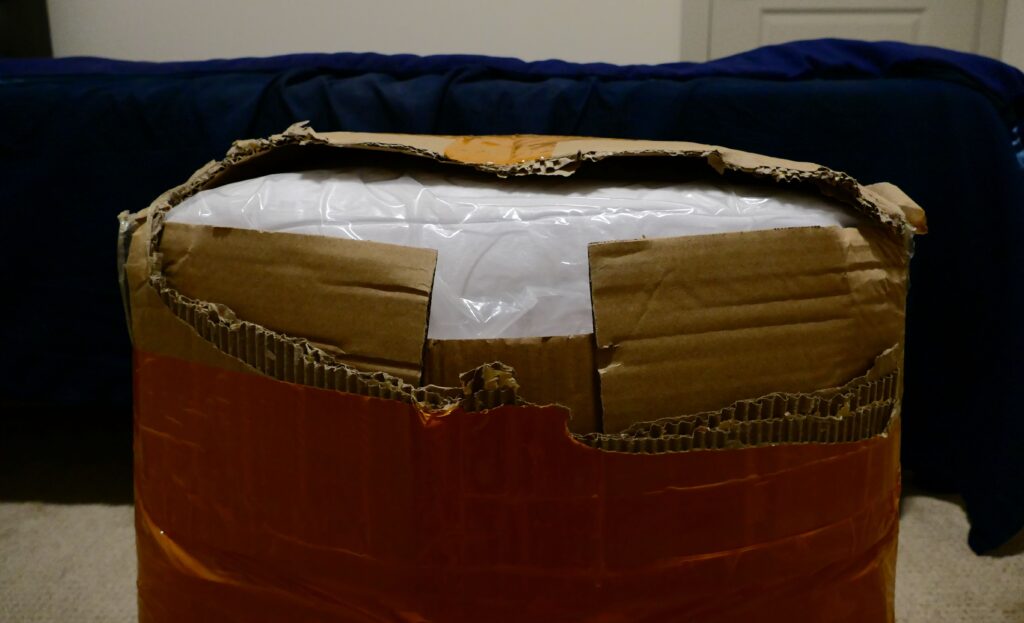
Finally, I pulled the contents out of the box.
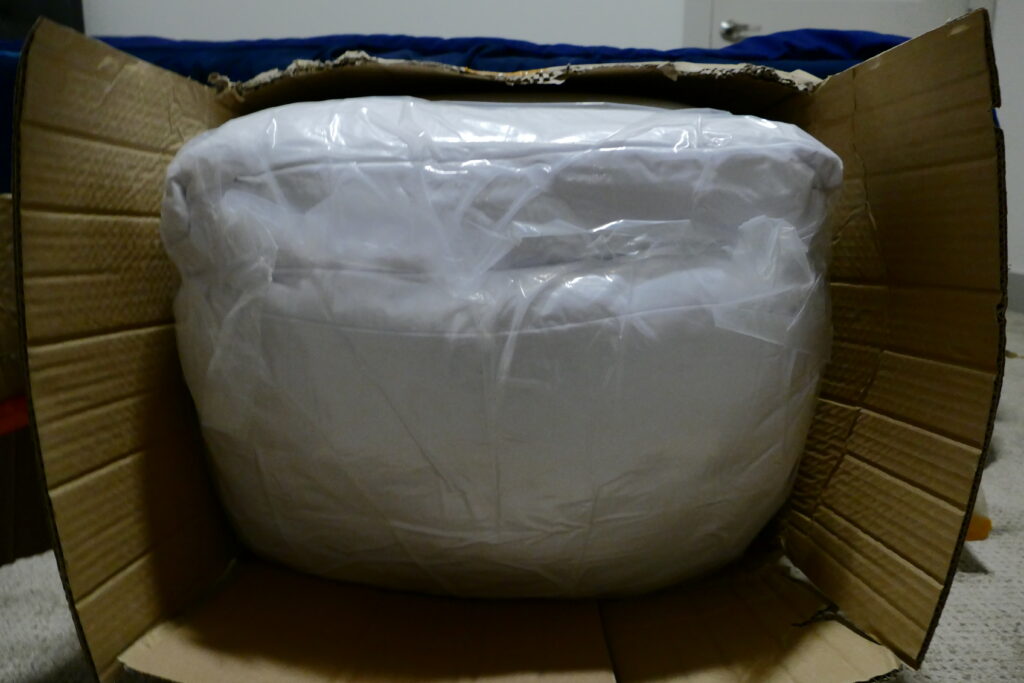
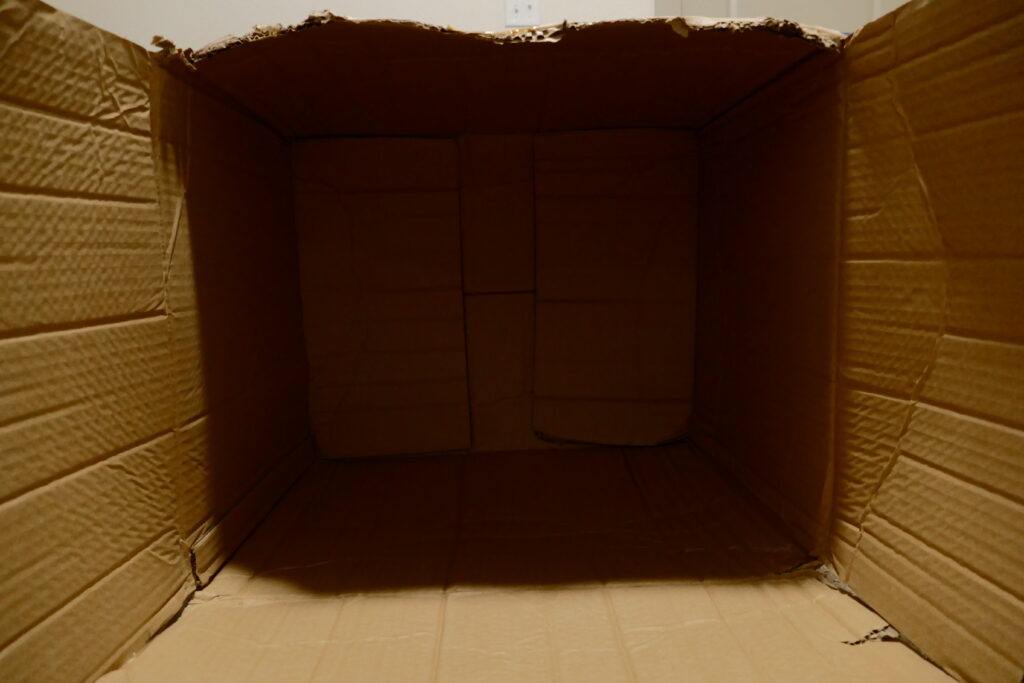
Once unfurled from how it was crammed into the box, the pillow was essentially folded in half. There was also a smaller plastic bag filled with what I assume is extra stuffing, so the pillow can be “topped up” after it’s been used for a while and started to go flat.
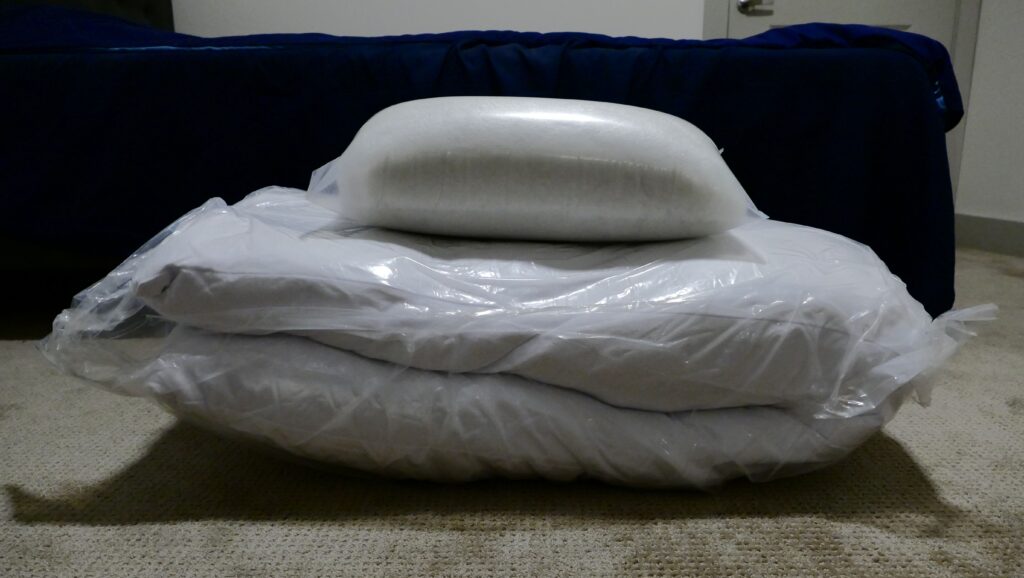
The pillow’s bag seemed to be vacuum packed, and the pillow expanded quickly after being removed. Thankfully, the point where it was folded wasn’t visible after allowing it to expand. The pillow’s outer cloth feels sort of like a felt material; it’s possible to pull apart if you’re too rough while cleaning it. Unzipping the bottom reveals the stuffing inside, which can be unwieldy to clean up once it starts to come out.
I ended up putting the extra stuffing in a couple of years later. Compared to its size, the extra bag had a hefty weight and felt like it contained twice as much stuffing as it looked like, since the fluffy stuffing was so tightly packed in.
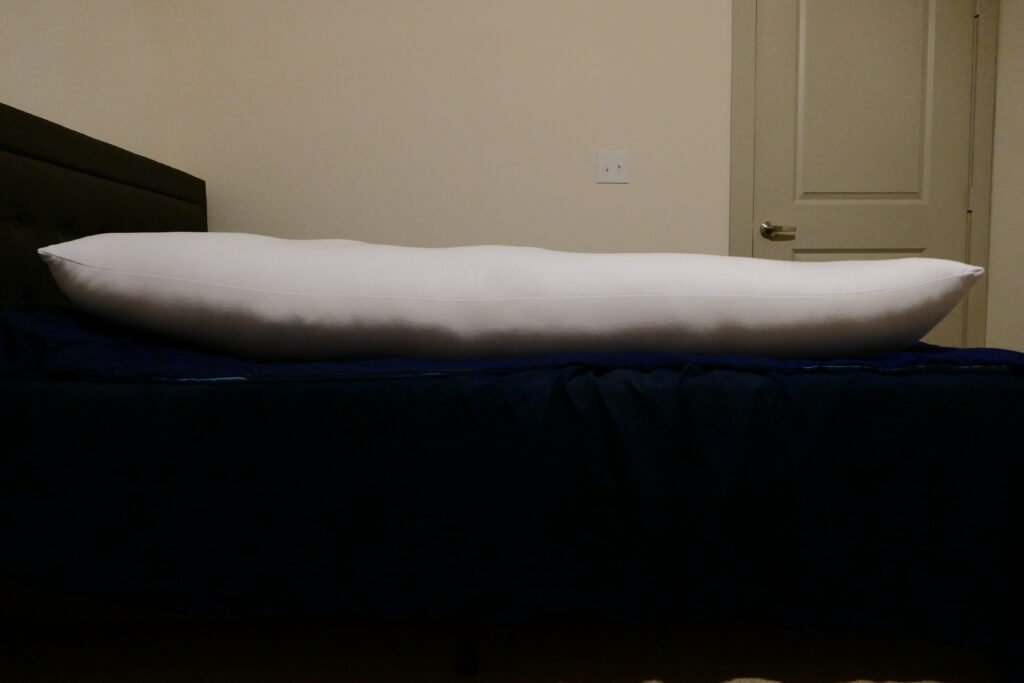
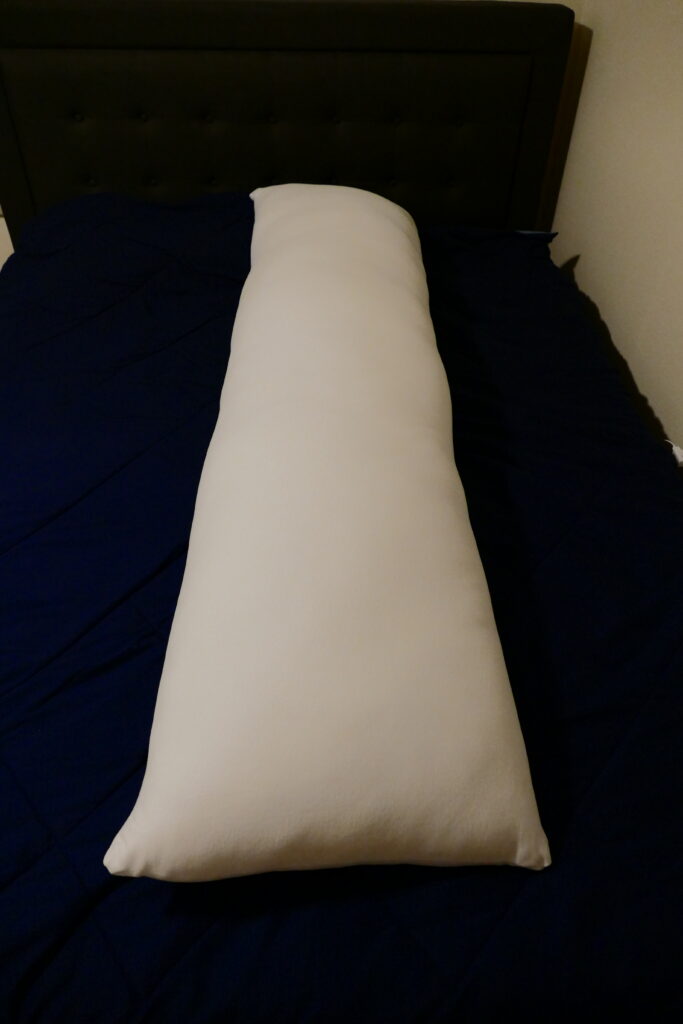
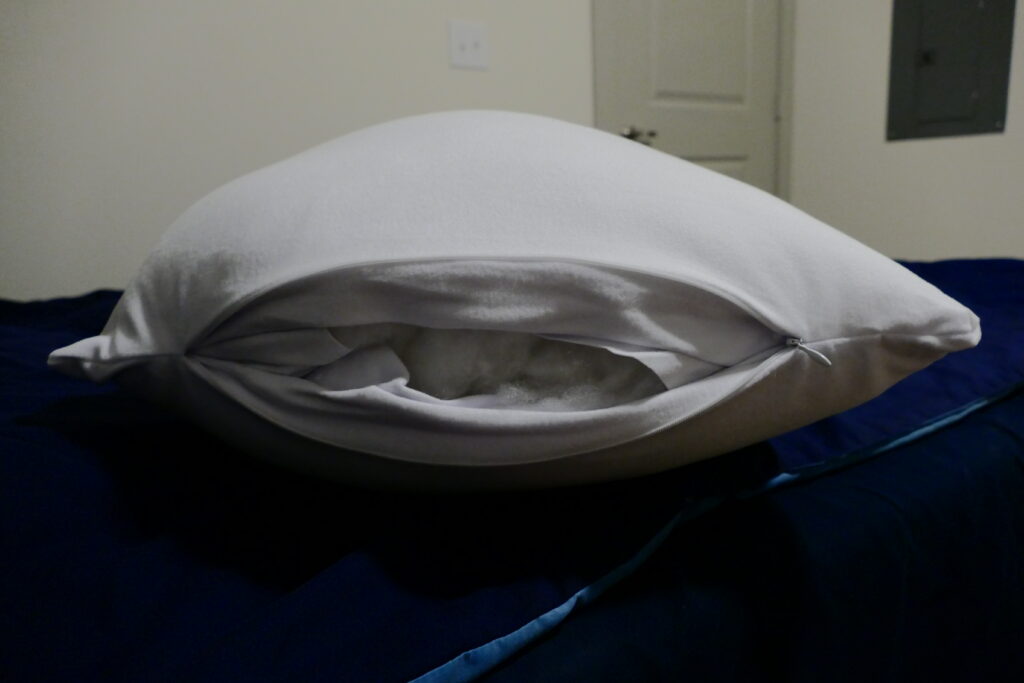
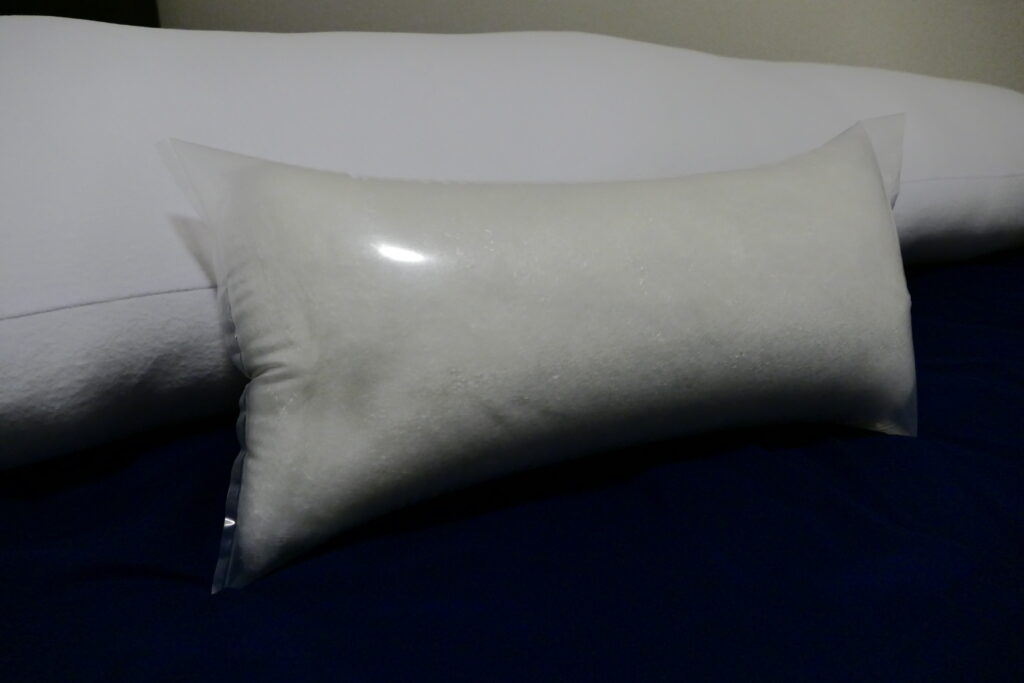
Putting It All Together
Finally, at long last, I put the cover onto the pillow for a complete dakimakura! The cover was actually very difficult to put on. I had to essentially stuff a handful of the pillow into the cover at a time, pulling the cover on inch by inch. It does get slightly easier to switch out over time as the pillow deflates and the cover stretches out.
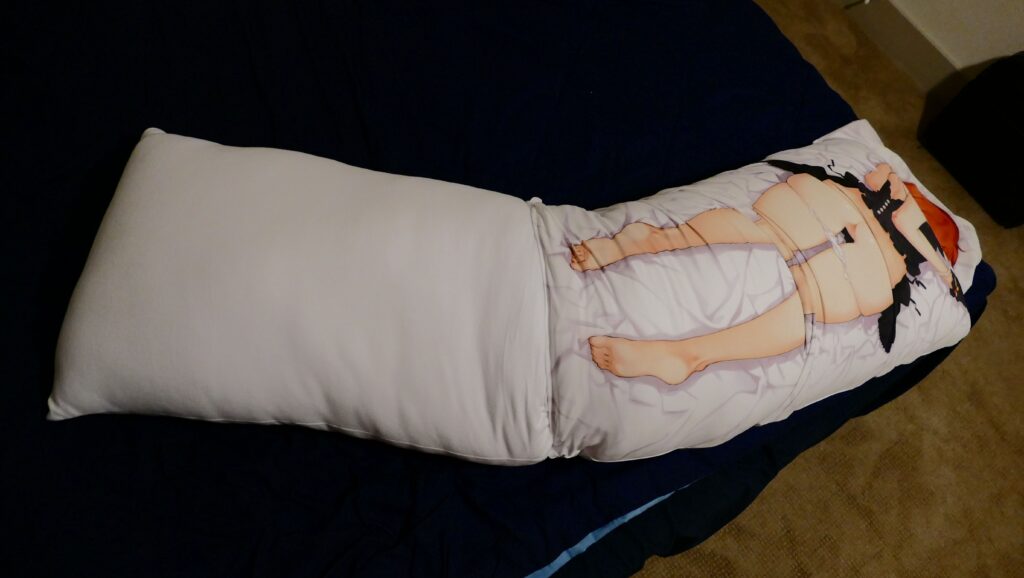
After what felt like around ten minutes, I had the entire cover on the pillow, smoothed out and zipped up. I was worried about breaking the zipper due to how tightly the pillow was stuffed in, but I just made sure to hold the pillow farther into the cover while zipping, and it held fine once it was on.
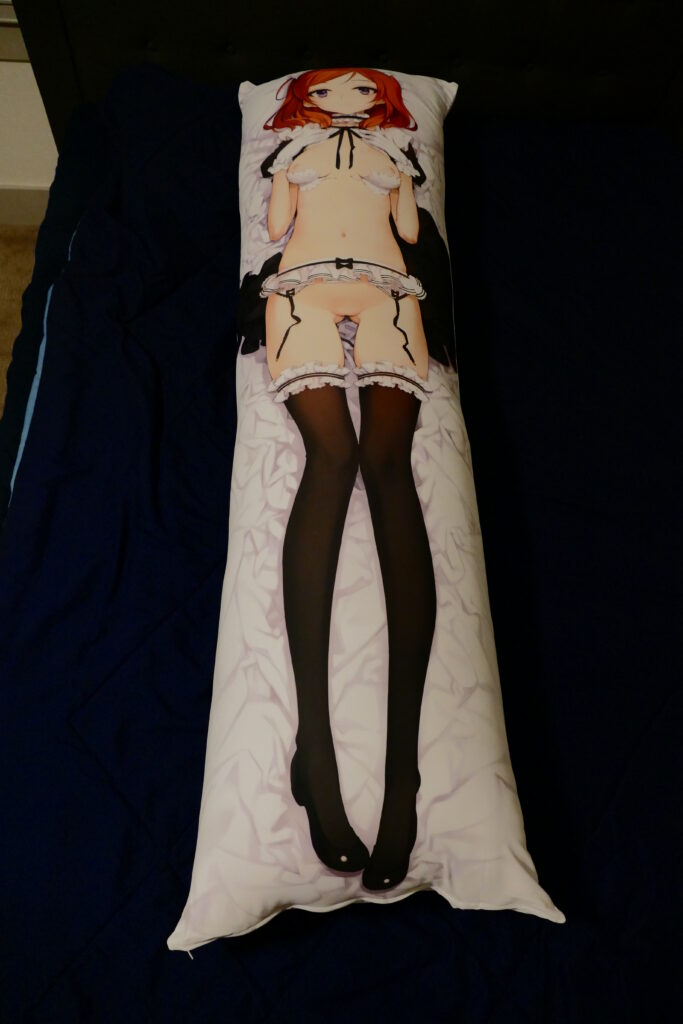
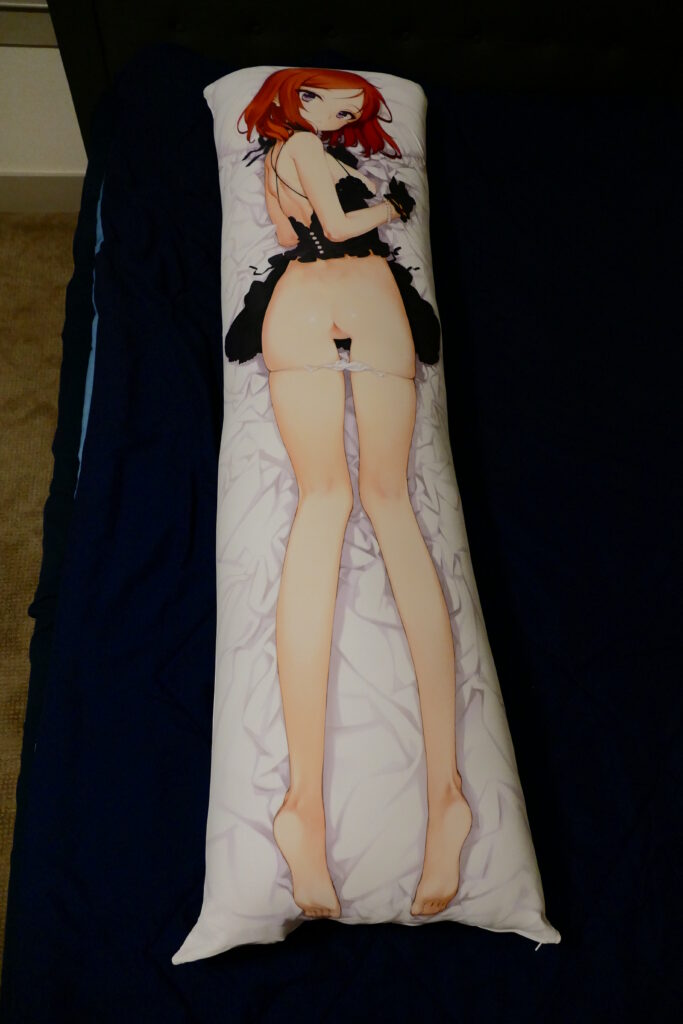
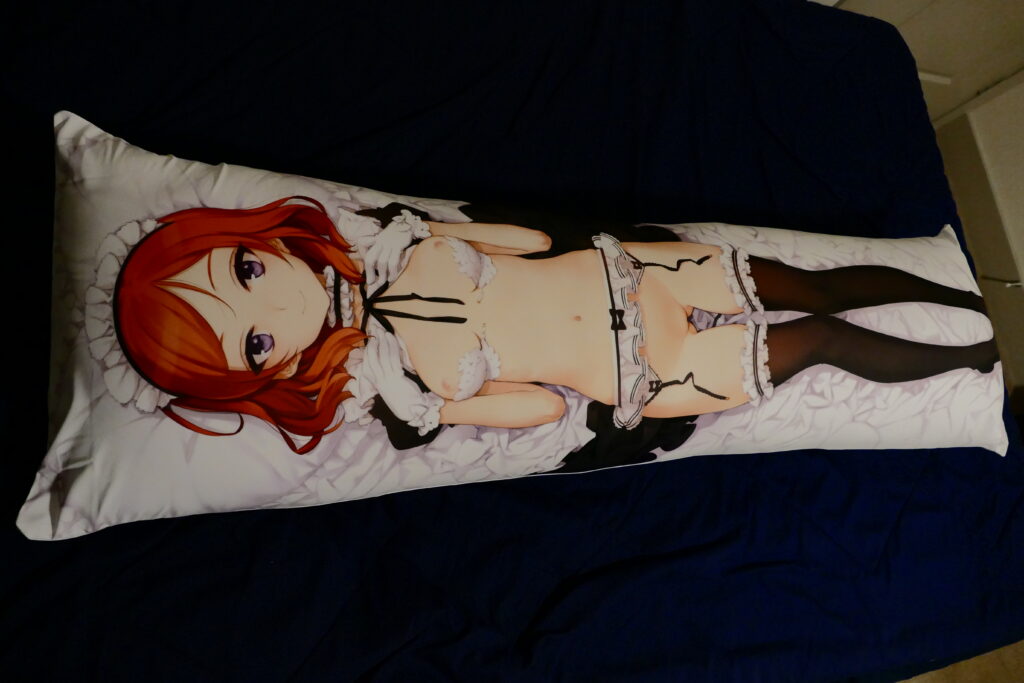
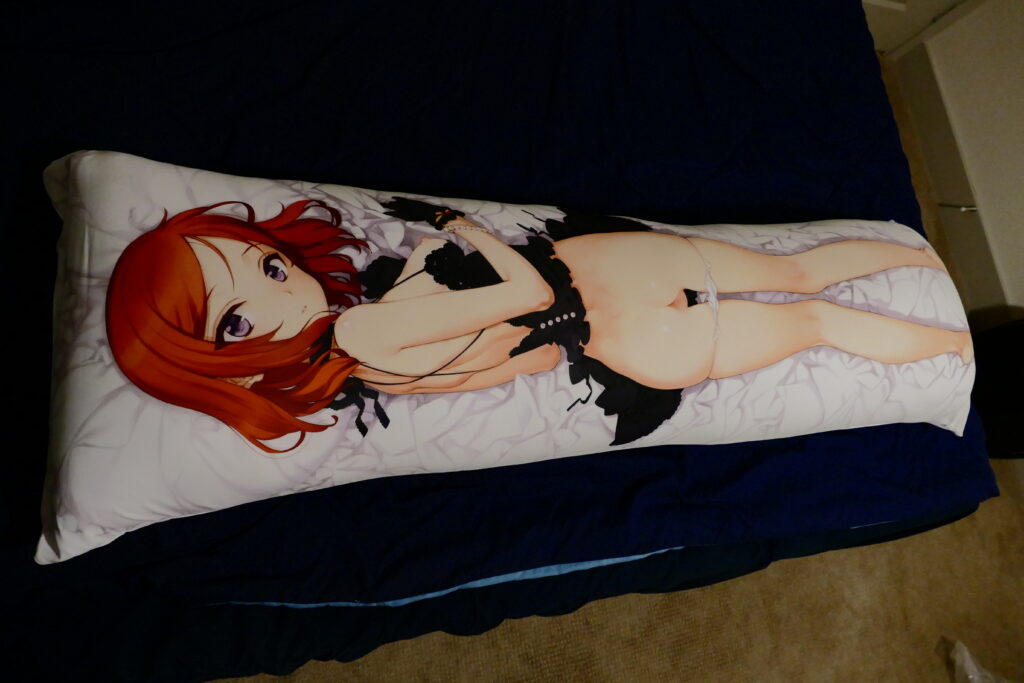
I was extremely pleased with the final product! The printing on the pillow case was very vibrant, and it really showed when positioned as intended over a pillow. The red of Maki’s hair, the peach tone of her skin, and the black gradient of her stockings appeared just as pristine (or more) than they would looking at artwork on a computer screen. The printing is especially crisp under sunlight coming in through the window, although it’s difficult to do it justice with photos.
While I was figuring things out, I decided to try putting the overcover on as well. It was much quicker and easier to put on since its zipper went down the long side instead of the short one– after all, it’s intended to be able to hide the inner cover on short notice, so it’s designed to be convenient to slip on and off.
As advertised, the overcover is opaque, so there’s no waifu outline that shows through. The white blotches in the photos above are just the bedroom’s light reflecting off of the shiny fabric, not the inner cover peeking out. I’ve since used the overcover both with and without a printed cover underneath, since printed covers underneath can still take some wear and tear through the overcover, especially from hairs poking through the fabric.
Follow-Up
If there was one upside to the roundabout process of obtaining this Maki cover, it’s that the whole experience made owning it more rewarding than if I’d simply ordered it from a print-on-demand website. Every time I see the cover, I know that it’s a genuine print that made its way from the artist to me, which makes it feel like real artwork despite the ecchi nature of the depicted clothing.
However, the cover’s rarity also made me more cautious about damaging it, which is difficult to control while sleeping. The two places that tend to damage covers are nails and hair, and I ended up growing my beard out not long after obtaining the cover, so I was hesitant to really hold it naturally without having a blanket over it. I ended up using the opaque cover over the Maki cover for a long stretch of time, then used the Maki cover exposed for a bit, then took it off and used only the opaque cover for a while. I definitely spent some months with the Maki cover as intended, but I ended up feeling obligated to replace it before it got too worn out, rather than after.
The cover aside, sleeping with a dakimakura is definitely a game-changer for quality of life. When I travel and am away from the daki, I don’t sleep on my side anymore, as it just doesn’t feel natural without having something to lean on and keep my spine aligned. Even when sleeping on my back, I tend to keep the daki over my chest to provide a bit of weight.
It did take some time to figure out how to hold and use the pillow most comfortably. When laying on my side, I typically keep the pillow laying flat, so it’s not actually facing me when I’m holding it. Attempting to turn it towards myself like illustrations commonly show doesn’t work because it’s far too wide to be comfortable; the width of the pillow is better used as depth held from the side. When laying on my back, I usually keep it over myself diagonally, so it’s not covering my face and doesn’t have to balance on top of me.
One downside I anticipated was that sleeping with a body pillow would make me annoying (or annoyed) to sleep with an actual human, and on that front, I was somewhat correct. The daki felt heavy when I first got it (and was firmer than I expected), but compared to a person, it’s extremely lightweight. The pillow provides volume without much mass, which makes for great maneuverability. After having your arm get tired or sore from being stuck underneath a real partner, you start to appreciate the pillow’s fluffiness a little more.
Basically, it’s extremely comfortable, and while I know it’s not an actual necessity, I’d highly recommend one to anyone who has the space for it. It ended up being unimaginably helpful after I suffered a concussion a few months later, since it helped me stay grounded when I started to get dizzy after laying down. Now that I’ve gotten used to it, going without it would be an adjustment.
So with that, I hope I’ve shed some light on the dakimakura scene for anyone who’s not part of it yet! Finding a legitimate cover that’s not from one of the few legitimate print-on-demand websites (such as Dakimakuri and Cuddly Octopus) can be a challenge, but I found the hunt to be quite fun. And even if a waifu (or husbando) design isn’t for you, you can still enjoy the body pillow aspect with an opaque option.
As for me, at least when I don’t have guests over, I’ll enjoy a little extra decoration in my bedroom.
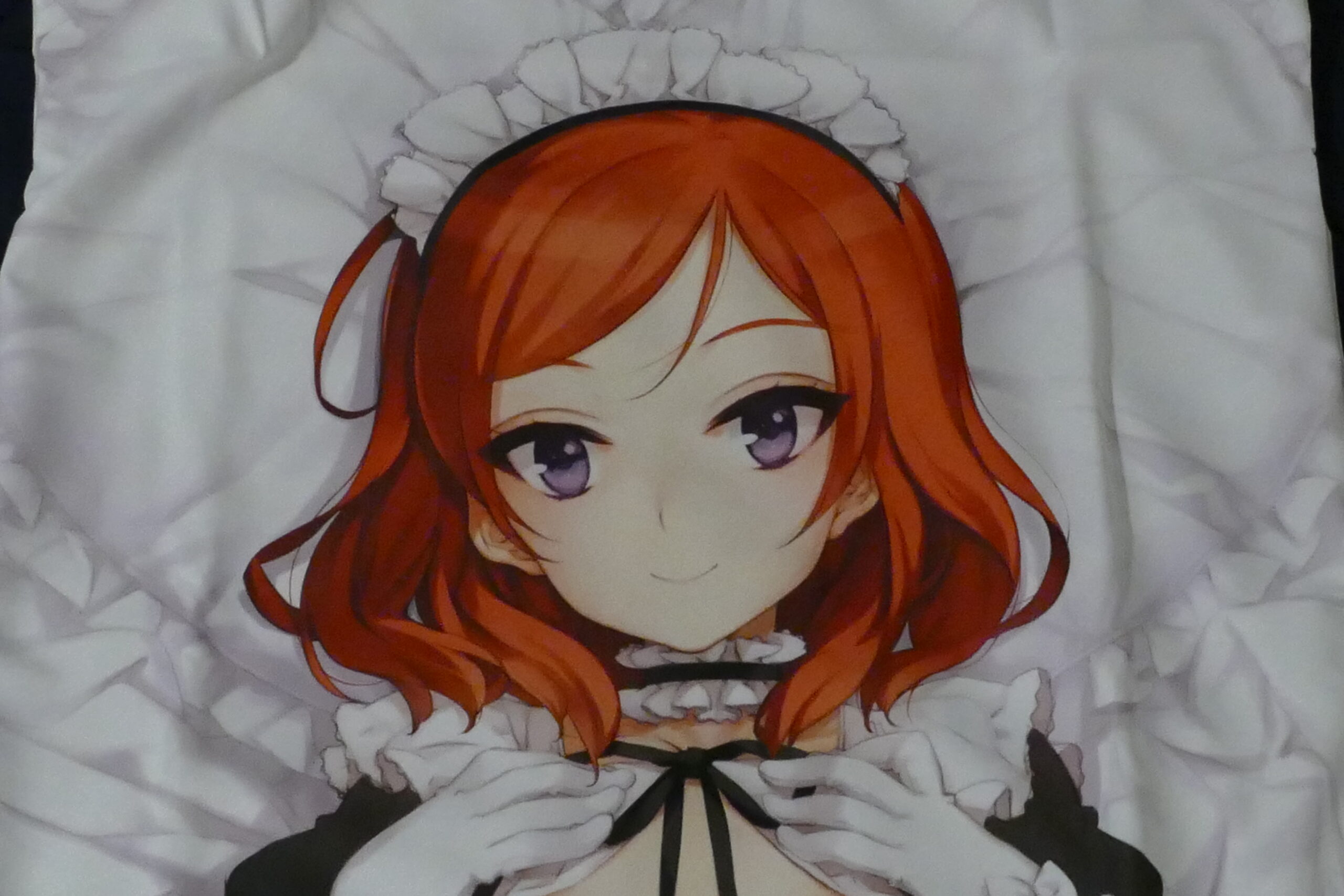
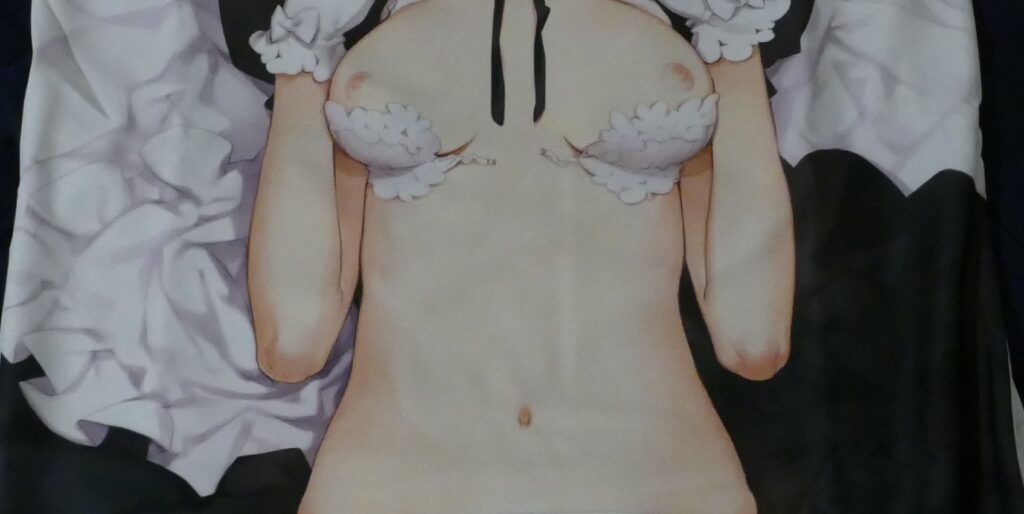


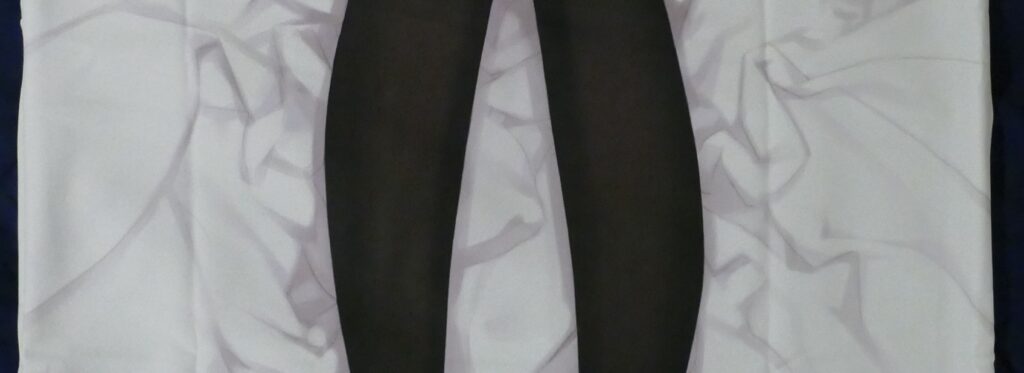
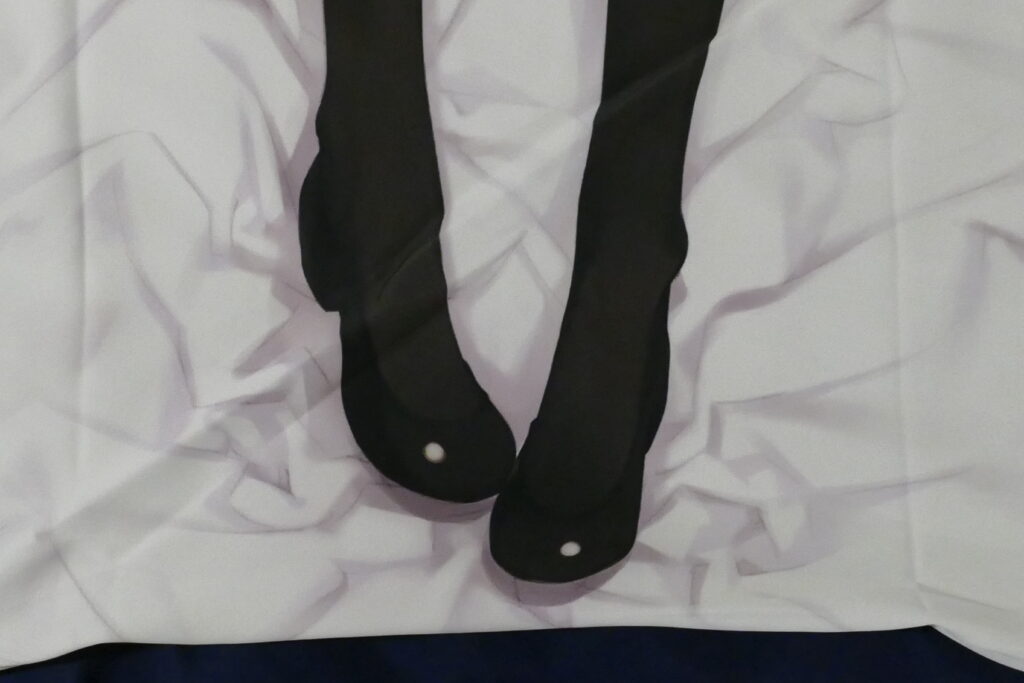
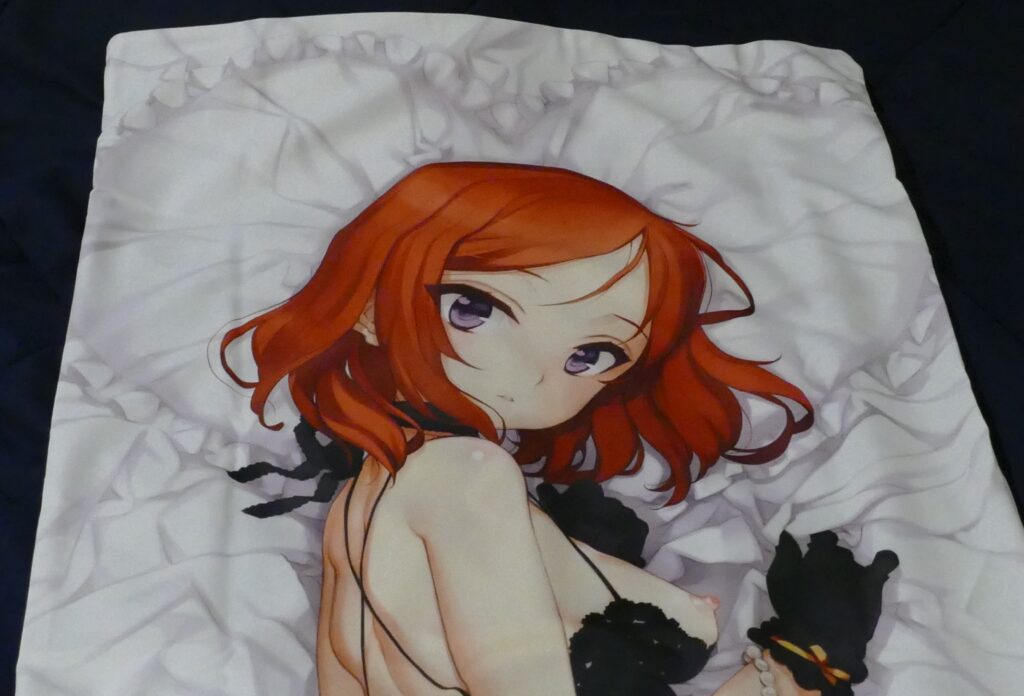
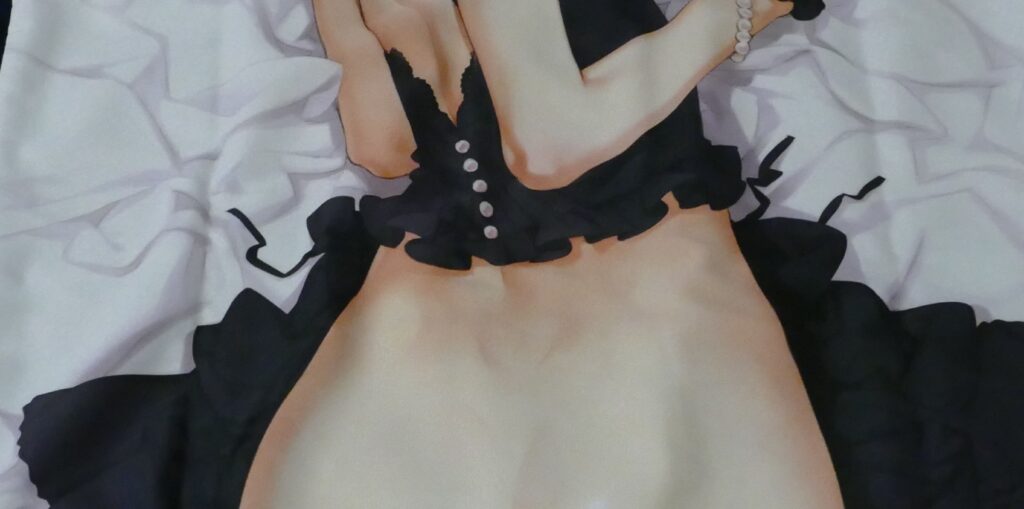
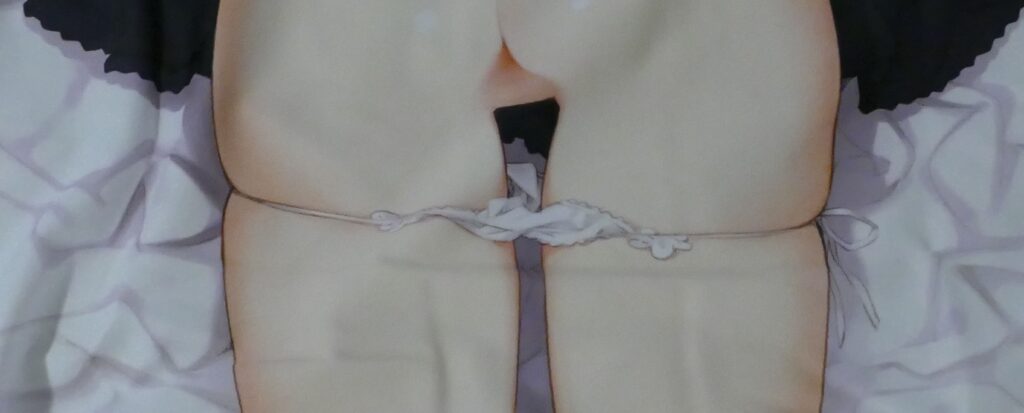
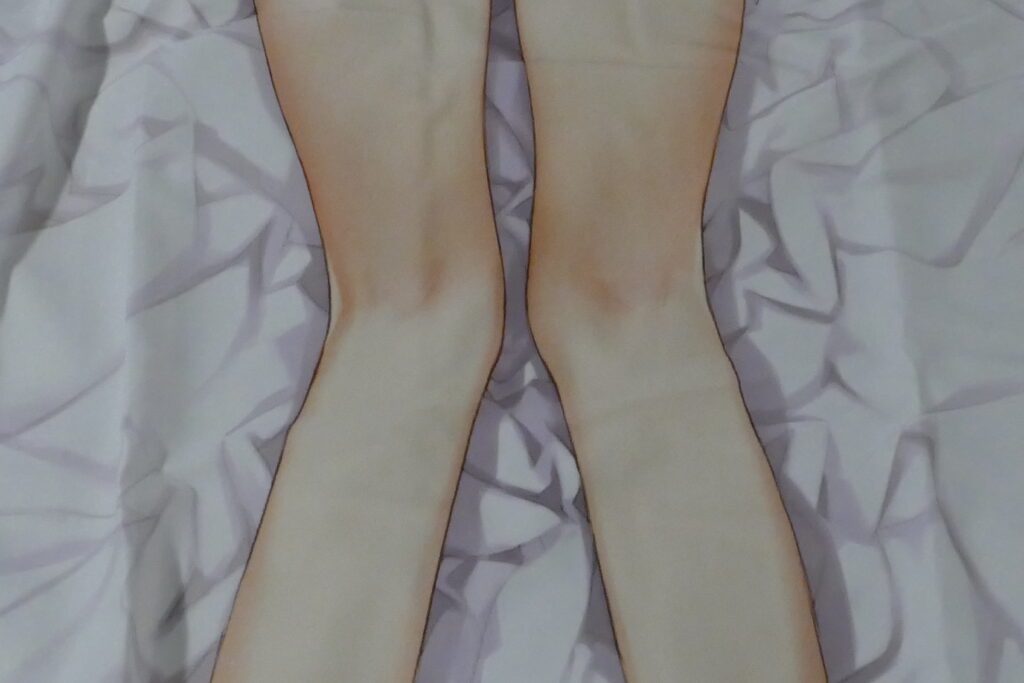
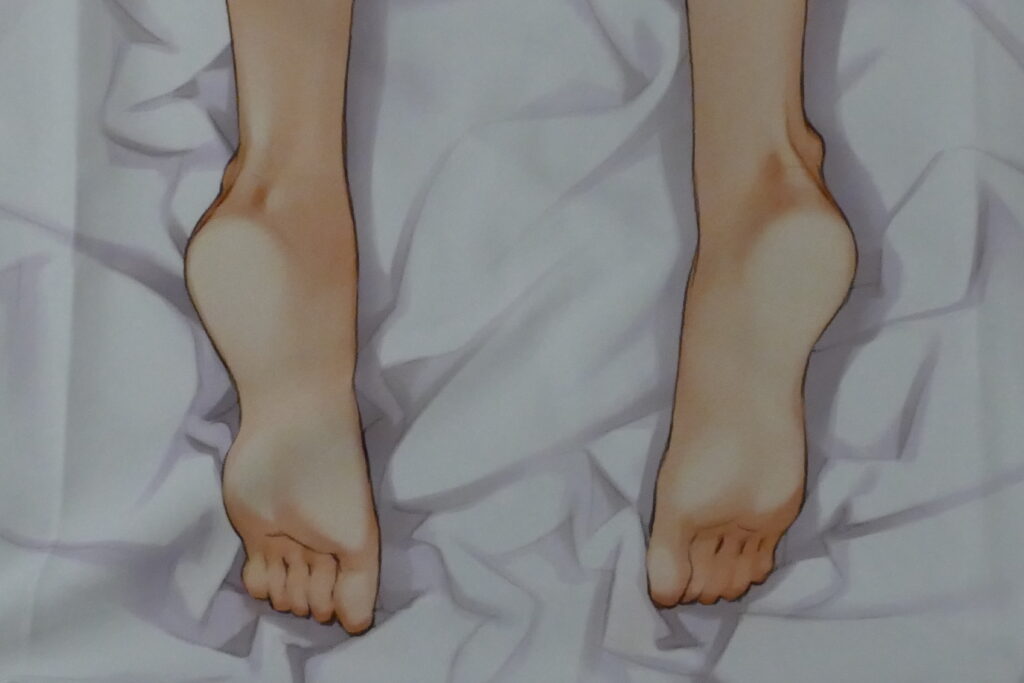
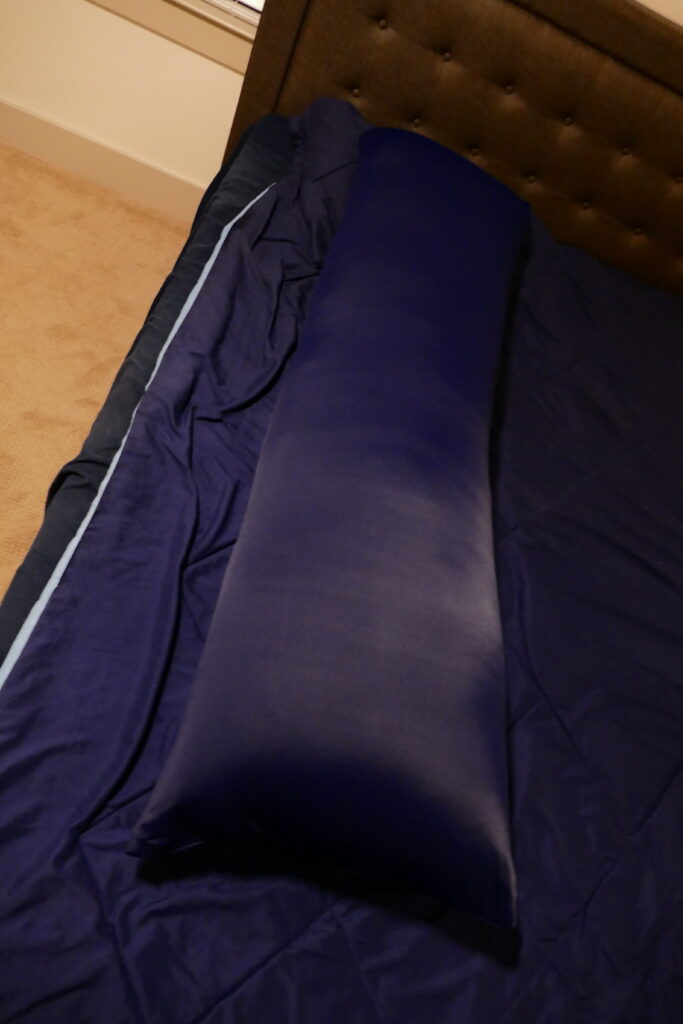
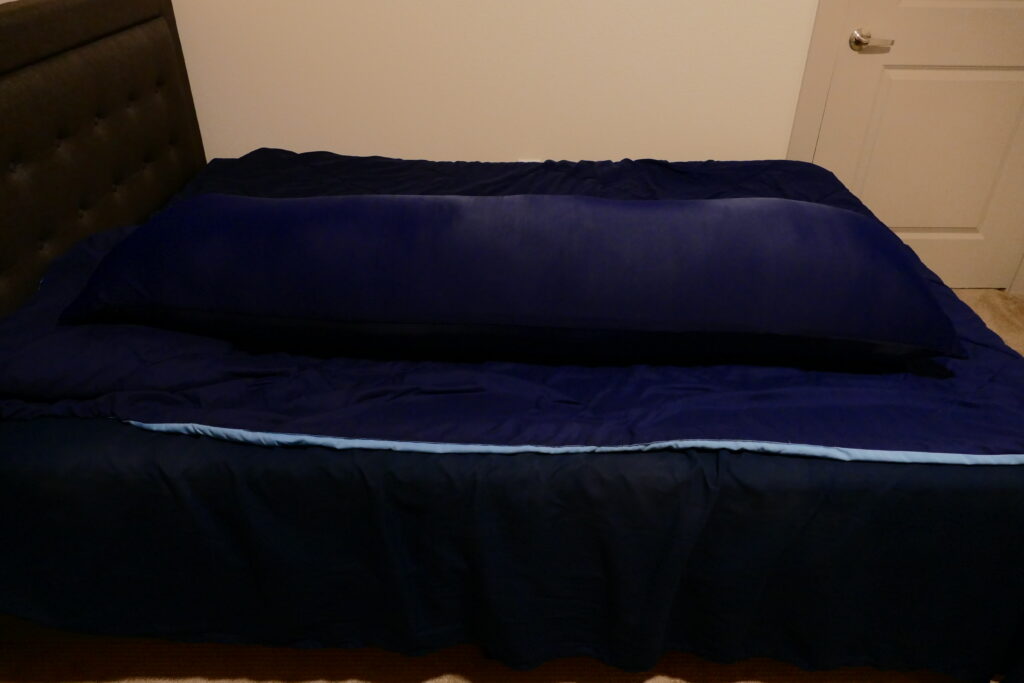
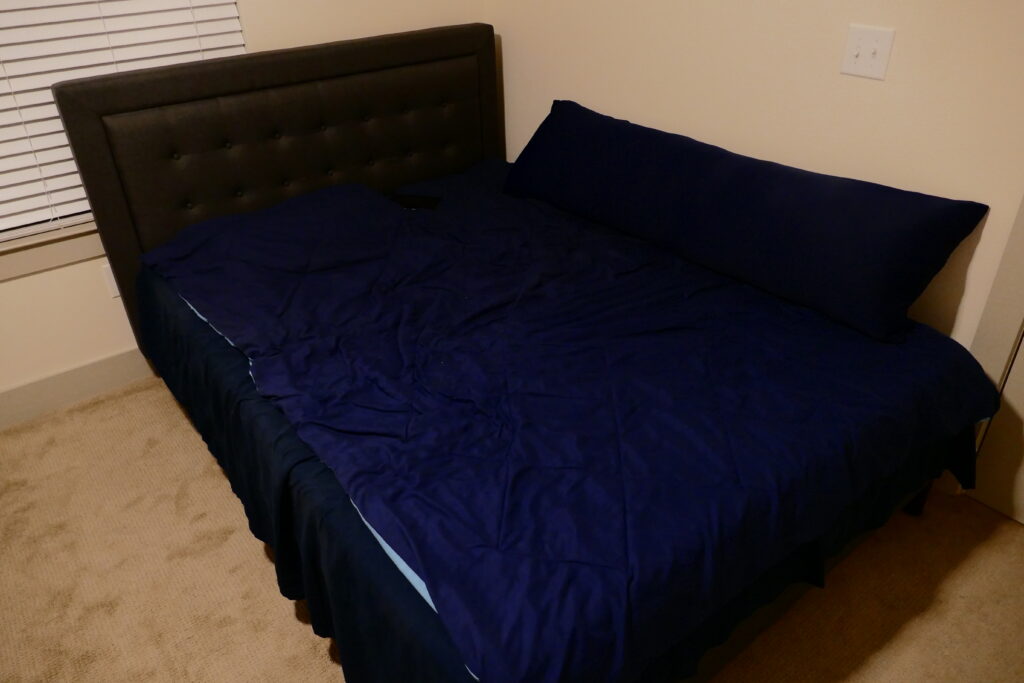
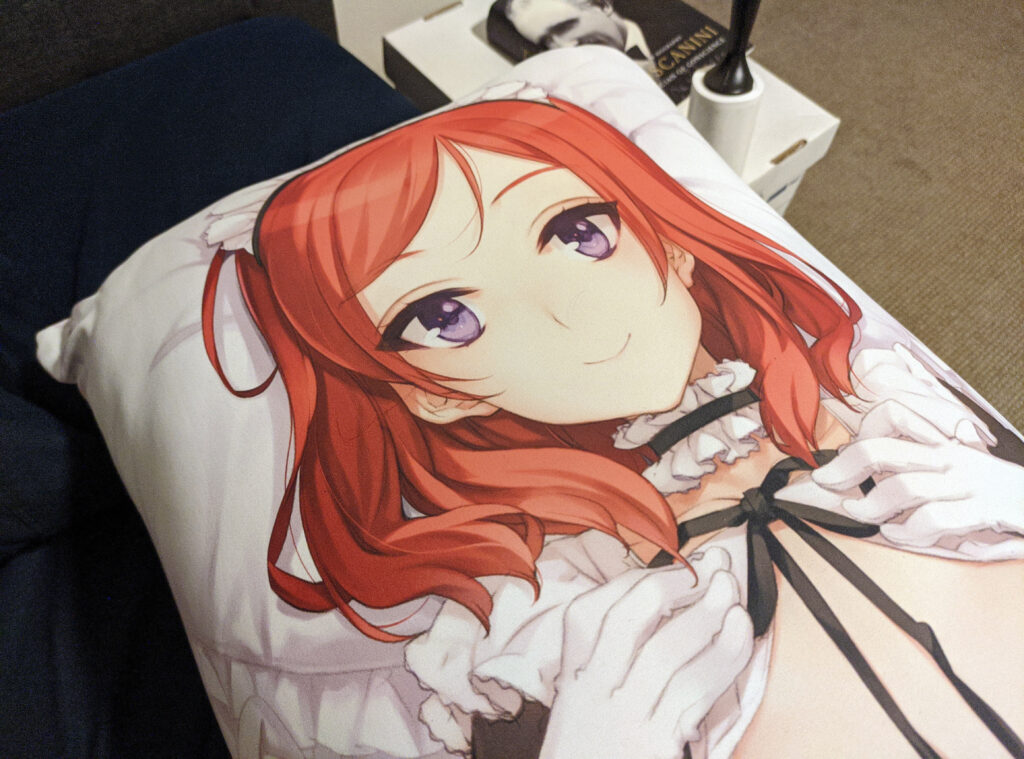
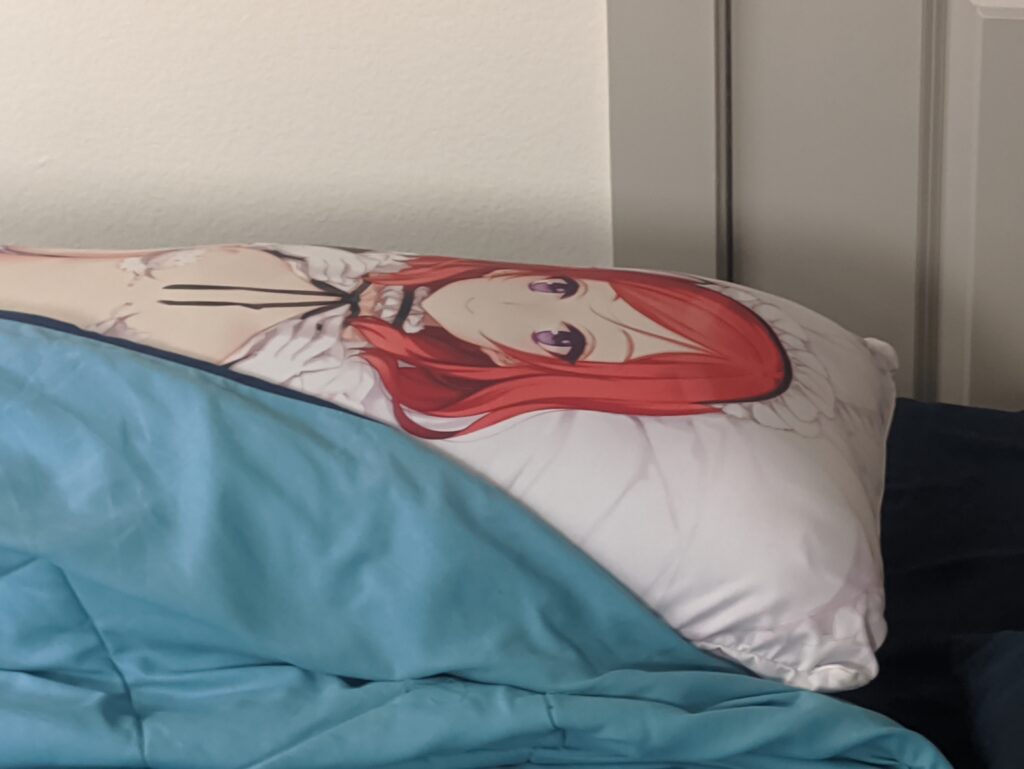
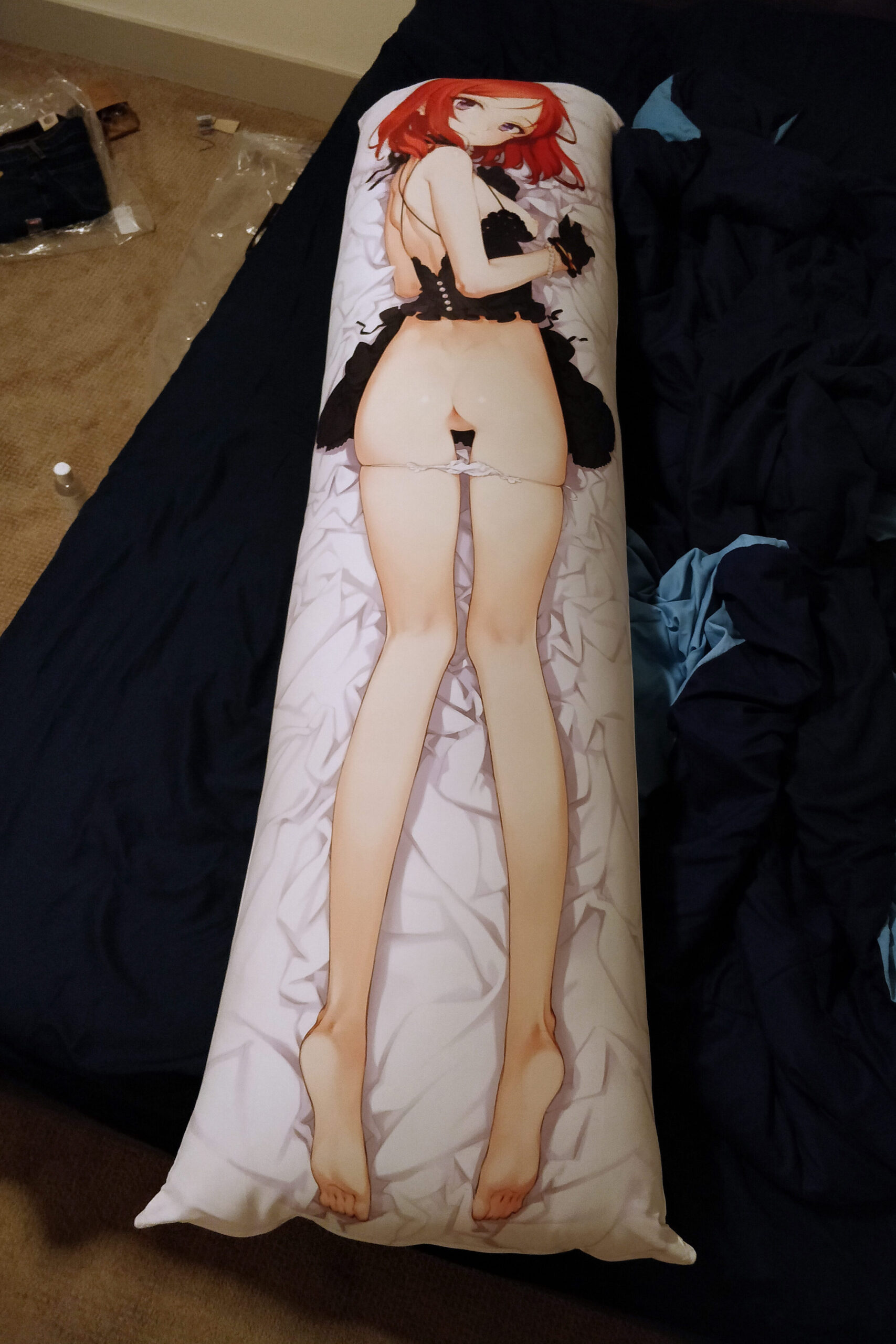
Some comments and discussion about this post took place on the /r/Dakimakuras subreddit: https://old.reddit.com/r/Dakimakuras/comments/143y36p/nishikino_maki_by_oyari_ashito_buying_a/